Ricoh MFSP220SFNW1 Multifunction Digital Product (Copier/Printer/Scanner/Fax) User Manual
Ricoh Company Ltd Multifunction Digital Product (Copier/Printer/Scanner/Fax)
Ricoh >
User Manual

For safe and correct use, be sure to read Safety Information before
using the machine.
User Guide

TABLE OF CONTENTS
How to Find Information about Operations and Troubleshooting...............................................................10
Operating Manual (Printed)....................................................................................................................... 10
Operating Manual (Digital Format)........................................................................................................... 10
Help.............................................................................................................................................................. 11
How to Read This Manual...............................................................................................................................12
Introduction...................................................................................................................................................12
Symbols Used in This Manual.....................................................................................................................12
Model-Specific Information........................................................................................................................ 12
Disclaimer.....................................................................................................................................................13
Notes............................................................................................................................................................ 14
Note to Administrator.................................................................................................................................. 14
About IP Address......................................................................................................................................... 15
Differences in Performance/Functions between Different Models.......................................................... 15
Differences in Performance/Functions between Different Models.......................................................... 16
1. Guide to the Machine
Guide to Components......................................................................................................................................17
Exterior..........................................................................................................................................................17
Exterior..........................................................................................................................................................21
Interior...........................................................................................................................................................22
Control Panel (When Using SP 221S, SP 220SNw, or SP221SNw)....................................................22
Control Panel (When Using SP 221SF, SP 220SFNw, or SP221SFNw).............................................. 24
Control Panel................................................................................................................................................26
Changing Operation Modes.......................................................................................................................... 29
Multi-access......................................................................................................................................................30
Assigning a Setting to the Short Cut Key........................................................................................................33
Assigning a Setting Using the Control Panel..............................................................................................33
Assigning a Setting Using Web Image Monitor........................................................................................33
Accessing the Function Assigned to the Short Cut Key.............................................................................34
Entering Characters..........................................................................................................................................35
About Operation Tools....................................................................................................................................37
2. Paper Specifications and Adding Paper
Workflow for Loading Paper and Configuring Paper Sizes and Types...................................................... 39
Loading Paper.................................................................................................................................................. 41
1
Draft 2016/05/27

Loading Paper into Tray 1...........................................................................................................................41
Loading Paper into the Bypass Tray...........................................................................................................46
Specifying Paper Type and Paper Size Using the Control Panel.................................................................49
Specifying the Paper Type.......................................................................................................................... 49
Specifying the Standard Paper Size...........................................................................................................50
Specifying a Custom Paper Size................................................................................................................ 50
Specifying Paper Type and Paper Size Using Smart Organizing Monitor.................................................52
Specifying a Custom Paper Size................................................................................................................ 52
Specifying Paper Type and Paper Size Using Web Image Monitor...........................................................53
Specifying a Custom Paper Size................................................................................................................ 53
Specifying Paper Type and Paper Size Using the Printer Driver..................................................................54
Supported Paper.............................................................................................................................................. 55
Specifications of Paper Types.....................................................................................................................56
Non-Recommended Paper Types.............................................................................................................. 58
Paper Storage.............................................................................................................................................. 59
Print Area......................................................................................................................................................59
Placing Originals..............................................................................................................................................62
Placing Originals on the Exposure Glass...................................................................................................62
Placing Originals in the Auto Document Feeder....................................................................................... 62
About Originals............................................................................................................................................63
3. Printing Documents
What You Can Do with the Printer Function...................................................................................................67
Configuring Option Settings and Paper Settings for the Printer....................................................................68
When Using Windows................................................................................................................................ 68
When Using Mac OS X...............................................................................................................................69
Displaying the Printing Preferences Dialog Box.............................................................................................70
Displaying the Printing Preferences Dialog Box from the [Start] Menu...................................................70
Displaying the Printing Preferences Dialog Box in an Application.......................................................... 70
Basic Operation of Printing............................................................................................................................. 72
If a Paper Mismatch Occurs....................................................................................................................... 72
Canceling a Print Job...................................................................................................................................73
4. Copying Originals
What You Can Do with the Copier Function..................................................................................................75
2
Draft 2016/05/27

Copier Mode Screen.......................................................................................................................................76
Basic Operation of Copying........................................................................................................................... 77
Canceling a Copy....................................................................................................................................... 78
Making Enlarged or Reduced Copies............................................................................................................80
Specifying Reduce/Enlarge....................................................................................................................... 80
Making Combined/2-sided Copies.............................................................................................................. 82
Specifying Combined and 2-sided Copies............................................................................................... 86
Copying an ID Card........................................................................................................................................ 87
Specifying the Scan Settings for Copying......................................................................................................89
Adjusting Image Density..............................................................................................................................89
Selecting the Document Type According to Original............................................................................... 89
5. Scanning Originals
What You Can Do with the Scanner Function............................................................................................... 91
Send Scanned Documents to a Folder on a Client Computer................................................................. 91
Send Scanned Documents by E-mail......................................................................................................... 91
Scanning Documents from a Client Computer.......................................................................................... 91
Scanner Mode Screen.....................................................................................................................................92
Registering Scan Destinations......................................................................................................................... 93
Modifying Scan Destinations......................................................................................................................98
Deleting Scan Destinations..........................................................................................................................99
Testing Transmission.....................................................................................................................................99
Basic Operation of Scan to Folder...............................................................................................................101
Step 1: Printing the Check Sheet.............................................................................................................. 101
Step 2: Confirming the User Name and Computer Name.................................................................... 102
Step 3: Creating a Shared Folder on a Computer................................................................................. 104
Step 4: Specifying Access Privileges for the Created Shared Folder................................................... 105
Step 5: Registering a Shared Folder in the Machine's Address Book.................................................. 106
Step 6: Send Scanned Files to a Shared Folder.....................................................................................107
Basic Operation of Scan to E-mail...............................................................................................................109
Step 1: Configuring SMTP and DNS Settings.........................................................................................109
Step 2: Registering Destination E-mail Addresses in the Address Book................................................109
Step 3: Sending Scanned Files by E-mail................................................................................................110
Basic Operation of Scan to FTP....................................................................................................................113
3
Draft 2016/05/27

Step 1: Configuring SMTP and DNS Settings.........................................................................................113
Step 2: Sending Scanned Files to an FTP Server.................................................................................... 113
Specifying the Scan Destination Using the One Touch Buttons or [Pause/Redial] Key (only SP 221SF, SP
220SFNw, and SP 221SFNw)....................................................................................................................116
Basic Procedure for Saving Scan Files on a USB Flash Memory Device..................................................118
Basic Operation for TWAIN Scanning........................................................................................................120
Using TWAIN scanner..............................................................................................................................120
TWAIN scanning.......................................................................................................................................120
Settings you can configure in the TWAIN dialog box........................................................................... 121
Basic Operation for WIA Scanning............................................................................................................. 123
Using SANE scanning................................................................................................................................... 124
Specifying the Scan Settings for Scanning.................................................................................................. 125
Specifying the Scanning Size According to the Size of the Original....................................................125
Adjusting Image Density........................................................................................................................... 125
Specifying Resolution................................................................................................................................126
6. Sending and Receiving a Fax
What You Can Do with the Fax Function.....................................................................................................127
Fax Settings Workflow.................................................................................................................................. 128
Types of Transmission and Reception Modes............................................................................................. 129
Transmission Mode Selection...................................................................................................................129
Reception Mode Selection....................................................................................................................... 129
Fax Mode Screen..........................................................................................................................................131
Setting the Date and Time............................................................................................................................. 132
Registering Fax Destinations......................................................................................................................... 133
Registering Fax Destinations Using the Control Panel............................................................................133
Registering Fax Destinations Using Web Image Monitor...................................................................... 135
Sending a Fax................................................................................................................................................138
Selecting Transmission Mode...................................................................................................................138
Basic Operation for Sending a Fax......................................................................................................... 139
Specifying the Fax Destination................................................................................................................. 141
Useful Sending Functions..........................................................................................................................145
Specifying the Scan Settings for Faxing.................................................................................................. 148
Using the Fax Function from a Computer (LAN-Fax)..................................................................................151
4
Draft 2016/05/27

Basic Operation for Sending Faxes from a Computer...........................................................................151
Configuring Transmission Settings............................................................................................................153
Configuring the LAN-Fax Address Book................................................................................................. 153
Editing a Fax Cover Sheet........................................................................................................................ 156
Receiving a Fax..............................................................................................................................................157
Selecting Reception Mode....................................................................................................................... 157
Forwarding or Storing Faxes in Memory................................................................................................ 160
Lists/Reports Related to Fax......................................................................................................................... 164
7. Configuring the Machine Using the Control Panel
Basic Operation.............................................................................................................................................165
Menu Chart.................................................................................................................................................... 167
Copier Features Settings............................................................................................................................... 168
Scanner Features Settings............................................................................................................................. 172
Fax Transmission Features Settings...............................................................................................................174
Fax Features Settings.....................................................................................................................................176
Address Book Settings...................................................................................................................................181
System Settings...............................................................................................................................................182
Tray Paper Settings........................................................................................................................................187
Administrator Settings....................................................................................................................................189
Printing Lists/Reports..................................................................................................................................... 195
Printing the Configuration Page................................................................................................................195
Types of Lists/Reports............................................................................................................................... 195
Network Settings............................................................................................................................................197
8. Configuring the Machine Using Utilities
Available Setting Functions Using Web Image Monitor and Smart Organizing Monitor...................... 201
Using Web Image Monitor...........................................................................................................................202
Displaying Top Page..................................................................................................................................... 203
Changing the Interface Language........................................................................................................... 204
Checking the System Information................................................................................................................. 205
Status Tab...................................................................................................................................................205
Counter Tab............................................................................................................................................... 206
Machine Information Tab......................................................................................................................... 207
Configuring the System Settings................................................................................................................... 208
5
Draft 2016/05/27

Sound Volume Adjustment Tab (only SP 221SF, SP 220SFNw, and SP 221SFNw).........................208
Tray Paper Settings Tab............................................................................................................................208
Copier Tab.................................................................................................................................................209
Fax Tab (only SP 221SF, SP 220SFNw, and SP 221SFNw)...............................................................210
Toner Management Tab...........................................................................................................................211
Interface Tab..............................................................................................................................................211
Shortcut to Function Tab............................................................................................................................211
Registering Destinations................................................................................................................................ 213
Configuring the Network Settings................................................................................................................ 214
Network Status Tab...................................................................................................................................214
IPv6 Configuration Tab.............................................................................................................................215
Network Application Tab......................................................................................................................... 216
DNS Tab.................................................................................................................................................... 217
Auto E-mail Notification Tab.................................................................................................................... 218
SNMP Tab................................................................................................................................................. 218
SMTP Tab...................................................................................................................................................219
POP3 Tab...................................................................................................................................................220
Wireless Tab (only SP 220SNw, SP 221SNw, SP 220SFNw, and SP 221SFNw).......................... 221
Google Cloud Tab....................................................................................................................................222
Configuring the IPsec Settings.......................................................................................................................223
IPsec Global Settings Tab.........................................................................................................................223
IPsec Policy List Tab...................................................................................................................................223
Printing Lists/Reports..................................................................................................................................... 227
Configuring the Administrator Settings.........................................................................................................228
Administrator Tab...................................................................................................................................... 228
Rest Settings Tab........................................................................................................................................228
Backup Setting Tab................................................................................................................................... 229
Restore Setting Tab....................................................................................................................................230
Set Date/Time Tab....................................................................................................................................231
Energy Saver Mode Tab.......................................................................................................................... 232
Using Web Image Monitor...........................................................................................................................233
Displaying Top Page.................................................................................................................................233
Changing the Interface Language........................................................................................................... 234
6
Draft 2016/05/27

Installing the Help Source File..................................................................................................................235
Displaying Help.........................................................................................................................................235
Menu.......................................................................................................................................................... 235
Home..........................................................................................................................................................236
System Settings.......................................................................................................................................... 236
Network Settings....................................................................................................................................... 237
IPsec Settings............................................................................................................................................. 240
Print List/Report......................................................................................................................................... 243
Administrator Tools....................................................................................................................................243
Using Smart Organizing Monitor.................................................................................................................246
Displaying Smart Organizing Monitor Dialog....................................................................................... 246
Checking the Status Information...............................................................................................................246
Checking the Status Information...............................................................................................................248
Configuring the Machine Settings............................................................................................................249
Configuring the IPv6 Settings................................................................................................................... 250
9. Maintaining the Machine
Replacing the Print Cartridge........................................................................................................................253
Cautions When Cleaning..............................................................................................................................255
Cleaning the Inside of the Machine............................................................................................................. 256
Cleaning the Exposure Glass........................................................................................................................257
Cleaning the Auto Document Feeder (When Using SP 221SF, SP 220SNw, SP 221SNw, SP
220SFNw, and SP 221SFNw)....................................................................................................................258
Moving and Transporting the Machine....................................................................................................... 259
Disposal......................................................................................................................................................260
Where to Inquire....................................................................................................................................... 260
10. Troubleshooting
Error and Status Messages on the Screen...................................................................................................261
Error and Status Indicate on the Control Panel........................................................................................... 269
Error and Status Messages Appear on Smart Organizing Monitor..........................................................271
Clearing Misfeeds......................................................................................................................................... 273
Removing Jammed Paper from Tray 1.....................................................................................................273
Removing Jammed Paper from the Bypass Tray.....................................................................................275
Opening the Rear Cover to Remove Jammed Paper............................................................................. 276
7
Draft 2016/05/27

Removing Scanning Jams......................................................................................................................... 277
When You Cannot Print Test Page............................................................................................................... 279
Paper Feed Problems.....................................................................................................................................280
Print Quality Problems................................................................................................................................... 282
Checking the Condition of the Machine..................................................................................................282
Checking the Printer Driver Settings.........................................................................................................283
Printer Problems............................................................................................................................................. 284
When You Cannot Print Properly.............................................................................................................284
When You Cannot Print Clearly...............................................................................................................285
When Paper is Not Fed or Ejected Properly...........................................................................................287
Copier Problems............................................................................................................................................ 288
When You Cannot Make Clear Copies..................................................................................................288
When You Cannot Make Copies as Wanted.........................................................................................289
Scanner Problems..........................................................................................................................................290
When You Cannot Browse the Network to Send a Scan File............................................................... 290
When Scanning Is Not Done As Expected............................................................................................. 290
Fax Problems..................................................................................................................................................291
When You Cannot Send or Receive Fax Messages As Wanted.......................................................... 291
When an error code appears on the fax journal or transmission status report....................................292
Common Problems.........................................................................................................................................295
11. Appendix
Functions and Network Settings Available in an IPv6 Environment.......................................................... 297
Available Functions................................................................................................................................... 297
Transmission Using IPsec...............................................................................................................................299
Encryption and Authentication by IPsec.................................................................................................. 299
Security Association.................................................................................................................................. 300
Encryption Key Exchange Settings Configuration Flow......................................................................... 301
Specifying Encryption Key Exchange Settings........................................................................................301
Specifying IPsec Settings on the Computer............................................................................................. 302
Enabling and Disabling IPsec Using the Control Panel..........................................................................304
Notes About the Toner.................................................................................................................................. 305
Specifications of the Machine...................................................................................................................... 306
General Function Specifications.............................................................................................................. 306
8
Draft 2016/05/27
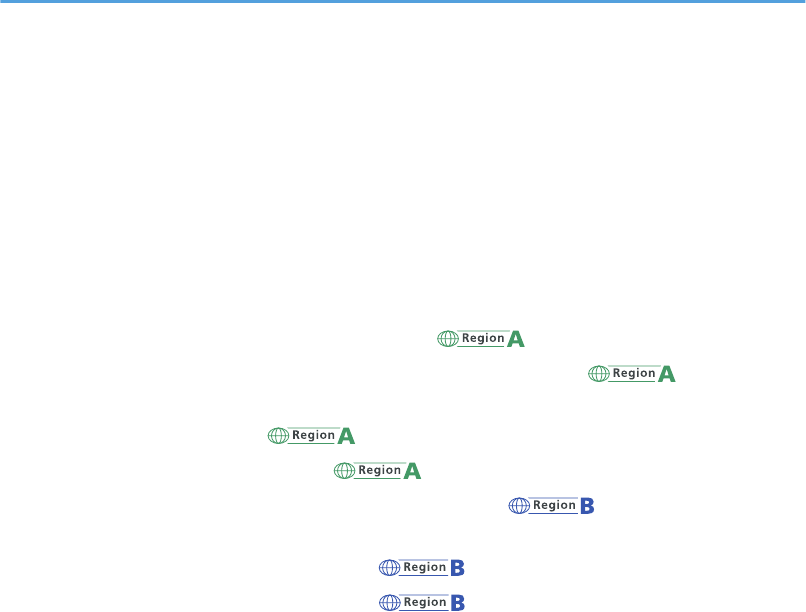
Printer Function Specifications..................................................................................................................308
Copier Function Specifications.................................................................................................................308
Scanner Function Specifications...............................................................................................................309
Fax Function Specifications...................................................................................................................... 310
Consumables..................................................................................................................................................312
Print Cartridge............................................................................................................................................312
Information for This Machine........................................................................................................................313
User Information on Electrical & Electronic Equipment (mainly Europe and Asia)..........313
Note for the Battery and/or Accumulator Symbol (For EU countries only) (mainly Europe)
.................................................................................................................................................................... 314
Environmental Advice for Users (mainly Europe)............................................................... 314
Notice To Wireless LAN Interface Users (mainly Europe).................................................315
Notes to users in the state of California (Notes to Users in USA) (mainly North America)....
.................................................................................................................................................................... 316
Notes to users in the United States of America (mainly North America)......................... 316
Notes to Canadian Users of Wireless Devices (mainly North America)......................... 317
Caution.......................................................................................................................................................317
ENERGY STAR Program........................................................................................................................... 318
Saving Energy............................................................................................................................................319
Copyright Information about Installed Applications...................................................................................321
expat...........................................................................................................................................................321
JPEG LIBRARY............................................................................................................................................321
OpenLDAP 2.1.......................................................................................................................................... 321
OpenSSL 0.9.8g....................................................................................................................................... 322
Trademarks.....................................................................................................................................................325
INDEX...........................................................................................................................................................327
9
Draft 2016/05/27
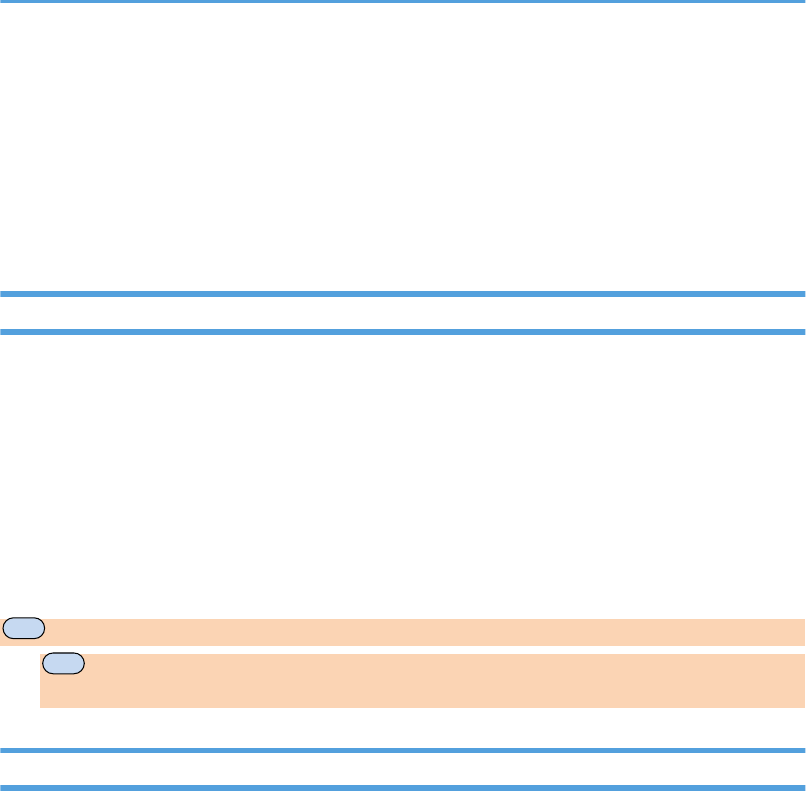
How to Find Information about Operations
and Troubleshooting
You can find support information about operating the machine and troubleshooting in the Operating
Manual (printed), Operating Manual (digital format), and Help (online).
Operating Manual (Printed)
The following manuals are provided with this machine.
Safety Information
This manual explains the safety precautions that should be followed when using the machine. Be
sure to read this manual before using the machine.
Setup Guide
This manual explains how to setup this machine.
It explains the instructions of taking out the machine from the packing box and connecting it to a
computer.
MF
Initial Guide for FAX (only SP 221SF, SP 220SFNw, and SP221SFNw)
MF
This manual explains how to set up the machine. It also explains how to remove the machine
from the packaging and how to connect it to a computer.
Operating Manual (Digital Format)
Operating manuals can be viewed from Ricoh's website or from the provided CD-ROM.
Viewing from a web browser
Access the Internet from a web browser.
Confirm that the computer or the machine is connected to the network.
Download the operating manuals from http://www.ricoh.com/.
Viewing from the provided CD-ROM
Operating manuals can also be viewed from the provided CD-ROM.
• When using Windows
1. Insert the CD-ROM into the CD-ROM drive.
2. Click [Read Manual] and follow the instructions on the screen.
The PDF file manual opens.
• When using Mac OS X
10 opal-p3_mf3_com_user_guide_gb_00228413_eng.xml
Draft 2016/05/27
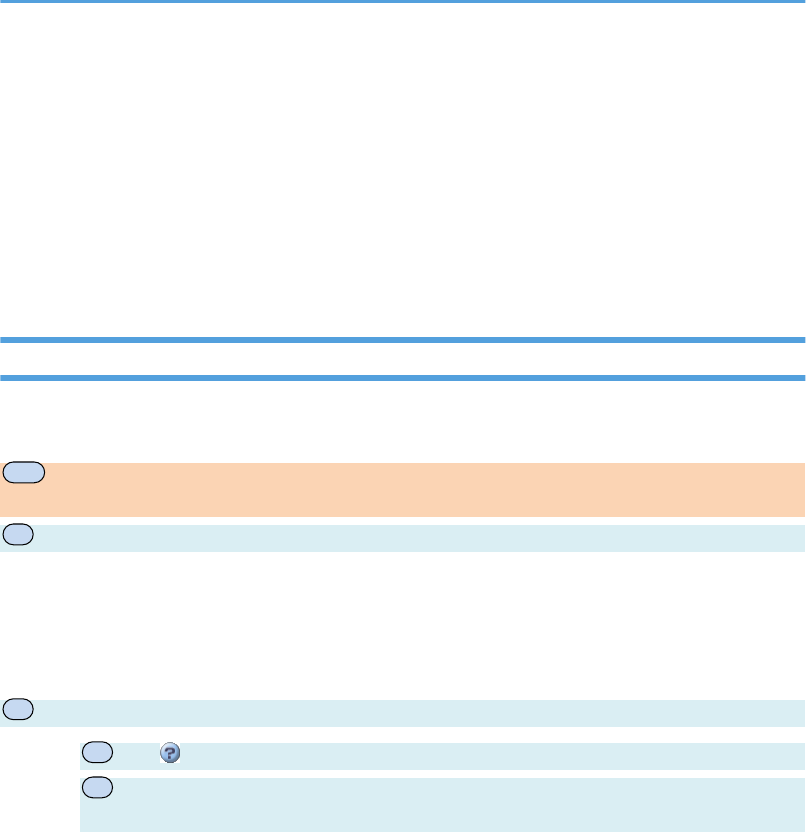
1. Insert the CD-ROM into the CD-ROM drive.
2. Double-click [Manuals.htm] file, located on the CD-ROM root directory.
3. Select the language.
4. Click [Read PDF manuals].
5. Click the manual you want to refer to.
The PDF file manual opens.
Help
Use the following procedure to open the Help files learn about the printer driver, Web Image Monitor,
and Smart Organizing Monitor functions.
MF
For details about using Web Image Monitor, see page 201 "Configuring the Machine Using
Utilities".
P
For details about using Web Image Monitor, see page 233 "Using Web Image Monitor".
Printer driver
1. Click [Help] on the printing preferences dialog box.
For the procedure on how to open the printing preferences dialog box, see page 70
"Displaying the Printing Preferences Dialog Box".
P
Web Image Monitor
1.
P
Click on the top right of the screen.
P
To display Help, install the help source file beforehand. For details about installing the
file, see page page 233 "Using Web Image Monitor".
Smart Organizing Monitor
1. Click [Help] on the [Printer Configuration] screen.
opal-p3_mf3_com_user_guide_gb_00228413_eng.xml 11
Draft 2016/05/27
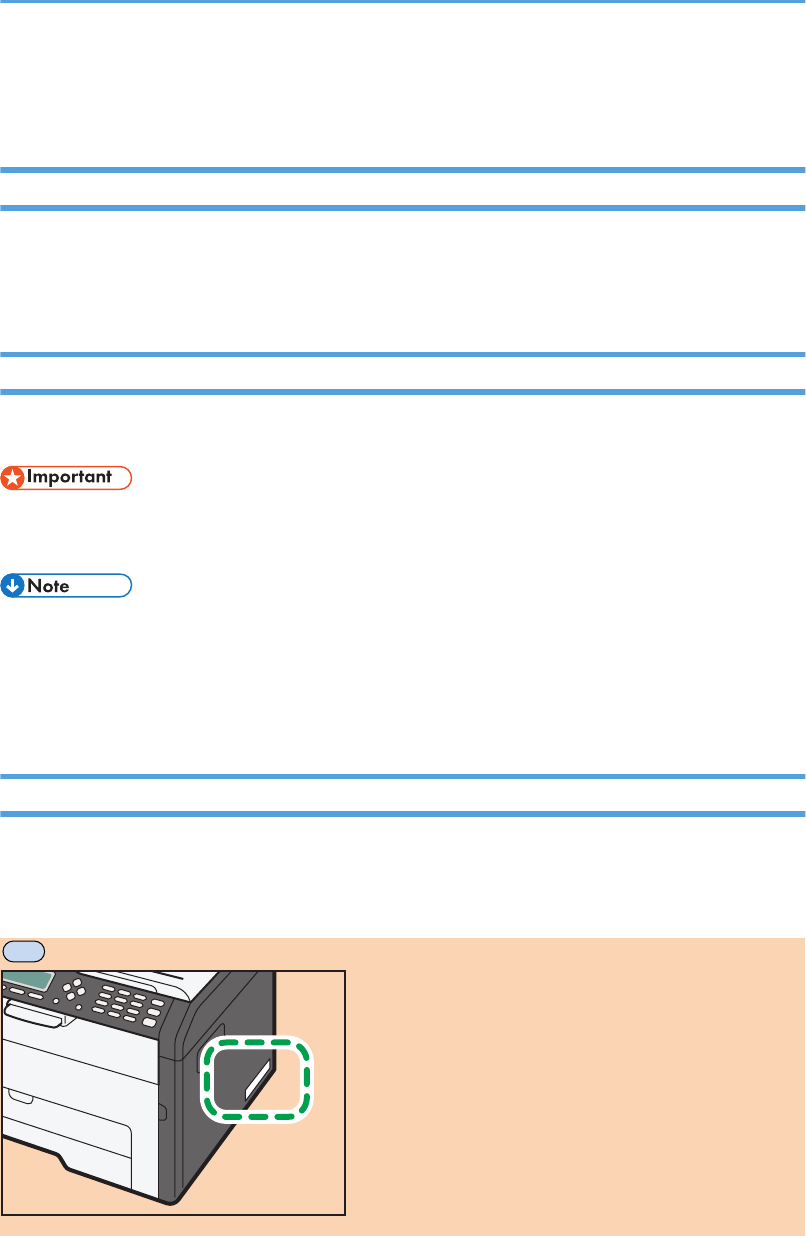
How to Read This Manual
Introduction
This manual contains detailed instructions and notes on the operation and use of this machine. For your
safety and benefit, read this manual carefully before using the machine. Keep this manual in a handy
place for quick reference.
Symbols Used in This Manual
This manual uses the following symbols:
Indicates points to pay attention to when using the machine, and explanations of likely causes of paper
misfeeds, damage to originals, or loss of data. Be sure to read these explanations.
Indicates supplementary explanations of the machine’s functions, and instructions on resolving user
errors.
[ ]
Indicates the names of keys on the machine's display or control panels.
Model-Specific Information
This section explains how you can identify the region your machine belongs to.
There is a label on the rear of the machine, located in the position shown below. The label contains
details that identify the region your machine belongs to. Read the label.
MF
DCT065
12 opal-p3_mf3_com_user_guide_gb_00228414_eng.xml
Draft 2016/05/27
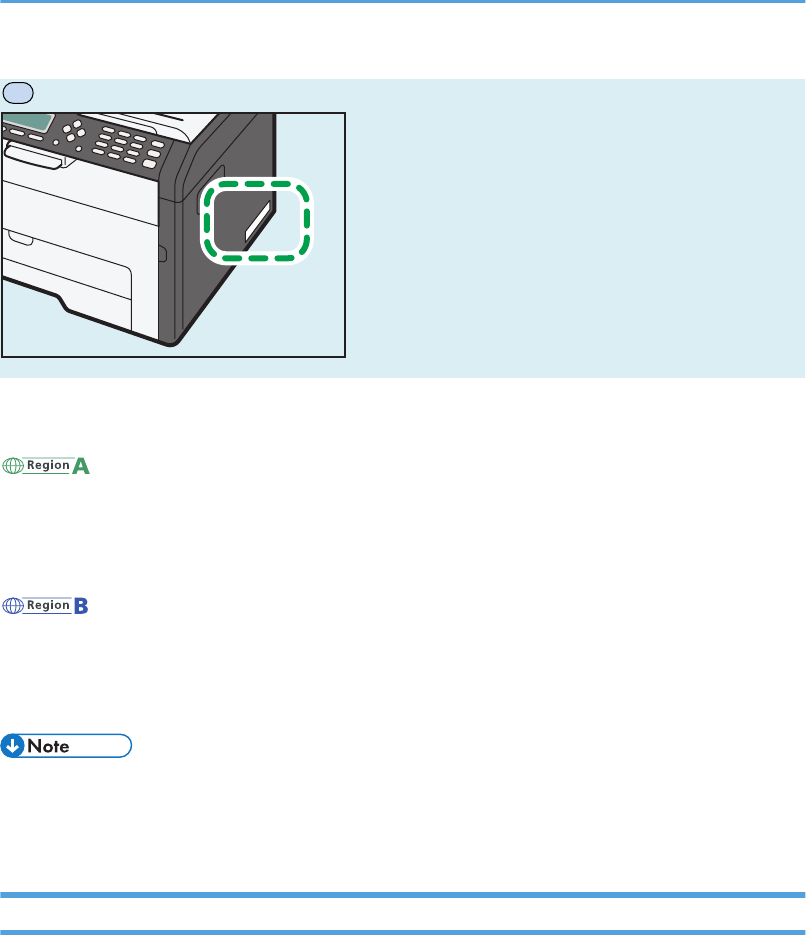
P
DCT065
The following information is region-specific. Read the information under the symbol that corresponds to
the region of your machine.
(mainly Europe and Asia)
If the label contains the following, your machine is a region A model:
• CODE XXXX -27
• 220–240 V
(mainly North America)
If the label contains the following, your machine is a region B model:
• CODE XXXX -17
• 120–127 V
• Dimensions in this manual are given in two units of measure: metric and inch. If your machine is a
Region A model, refer to the metric units. If your machine is a Region B model, refer to the inch
units.
Disclaimer
To the maximum extent permitted by applicable laws, in no event will the manufacturer be liable for any
damages whatsoever arising out of failures of this machine, losses of the registered data, or the use or
non-use of this product and operation manuals provided with it.
Make sure that you always copy or have backups of the data registered in this machine. Documents or
data might be erased due to your operational errors or malfunctions of the machine.
In no event will the manufacturer be responsible for any documents created by you using this machine or
any results from the data executed by you.
For good output quality, the manufacturer recommends that you use genuine toner from the
manufacturer.
opal-p3_mf3_com_user_guide_gb_00228414_eng.xml 13
Draft 2016/05/27
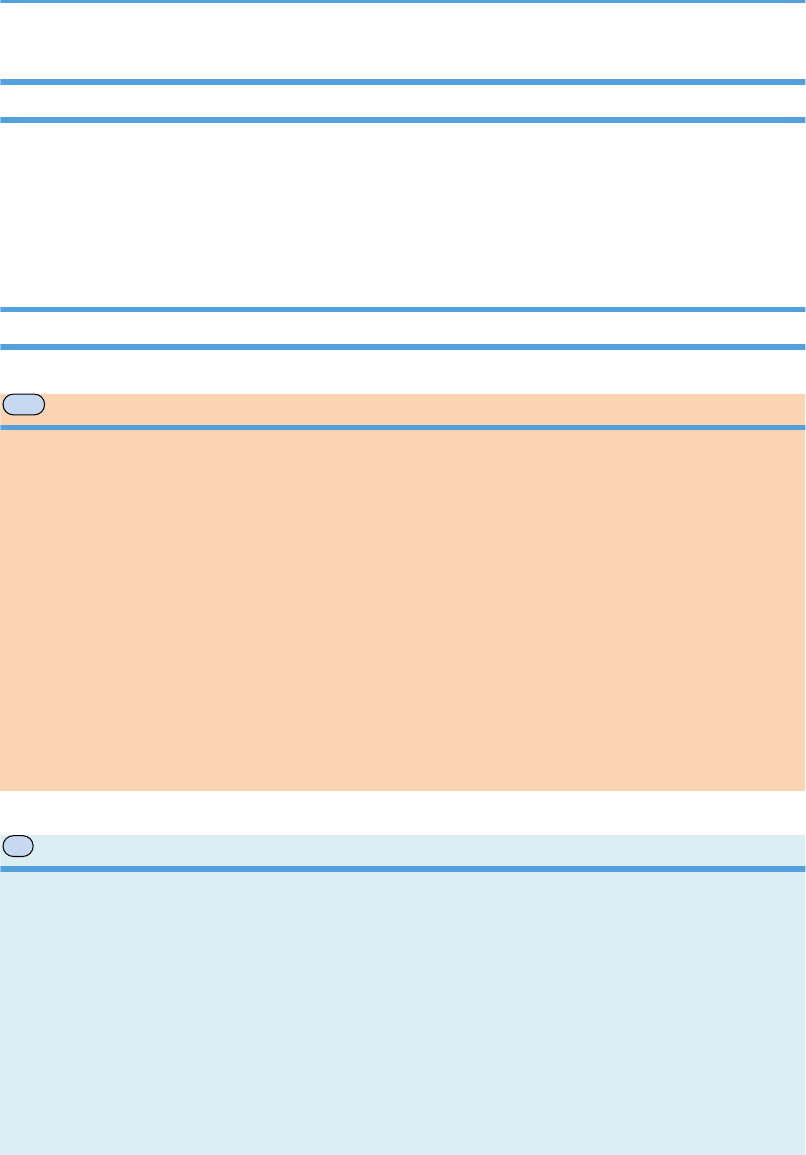
Notes
Contents of this manual are subject to change without prior notice.
The manufacturer shall not be responsible for any damage or expense that might result from the use of
parts other than genuine parts from the manufacturer with your office products.
Some illustrations in this manual might be slightly different from the machine.
Note to Administrator
MF
Password
Certain configurations of this machine can be password-protected to prevent unauthorized modifications
by others. We strongly recommend you to create your own password immediately.
The following are the operations that can be password-protected:
• Entering the [Address Book], [Network Settings], or [Admin. Tools] menu using the control panel
You can access these menus without a password by factory default.
The setting for creating a password can be found in [Admin. Tools].
• Configuring the machine using Web Image Monitor
You can configure the machine using Web Image Monitor without a password by factory default.
The setting for creating a password can be found in [Administrator Settings].
For details about creating passwords, see page 189 "Administrator Settings" or page 165
"Configuring the Machine Using the Control Panel".
P
Password
When you log in to this printer, you will be prompted to enter the password. We strongly recommend
you to change the factory default password immediately to prevent information leakage and
unauthorized operations by others.
You will be prompted to enter your password when you attempt to change printer settings configured
using Web Image Monitor.
To use the factory default password, leave the password blank when using Web Image Monitor.
To Change password for Web Image Monitor, you need to log on as an Administrator, and then make
the necessary settings.
For details about setting a password, see page 233 "Using Web Image Monitor".
14 opal-p3_mf3_com_user_guide_gb_00228414_eng.xml
Draft 2016/05/27
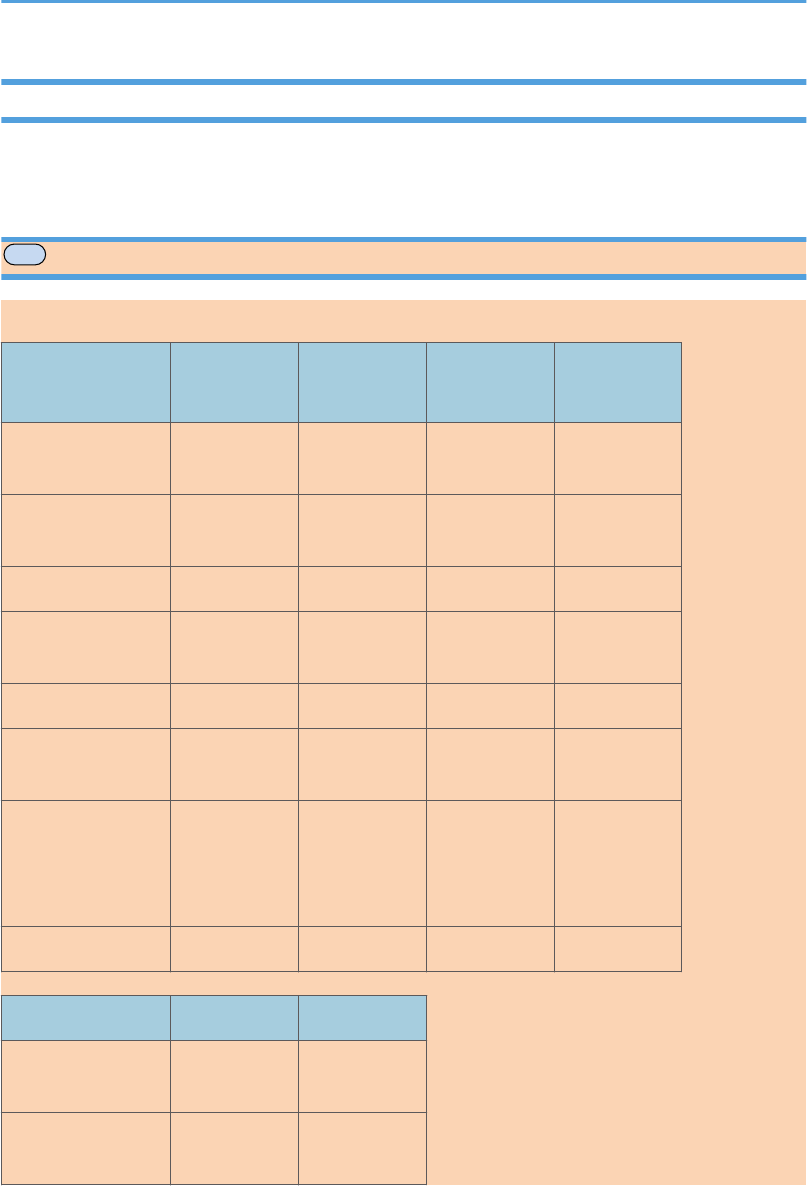
About IP Address
In this manual, "IP address" covers both IPv4 and IPv6 environments. Read the instructions that are
relevant to the environment you are using.
MF
Differences in Performance/Functions between Different Models
The differences in main performance/functions between different models are as follows:
SP 221S SP 220SNw
SP 221SNw SP 221SF SP 220SFNw
SP 221SFNw
Fax Not available Not available Available
(Standard)
Available
(Standard)
ADF Not available Available
(Standard)
Available
(Standard)
Available
(Standard)
PCL driver Not available Available Not available Available
Ethernet Port
(Network)
Not available Available Not available Available
Wireless LAN Not available Available Not available Available
Scan to
Email/FTP/Folder
Not available Available Not available Available
Toner
Management
(Toner Level
Indication)
Not available Not available Available*1 Available*1
Paperless FAX*2 Not available Not available Not available Available
SP 221S SP 221SF
Fax Not available Available
(Standard)
ADF Not available Available
(Standard)
opal-p3_mf3_com_user_guide_gb_00228414_eng.xml 15
Draft 2016/05/27
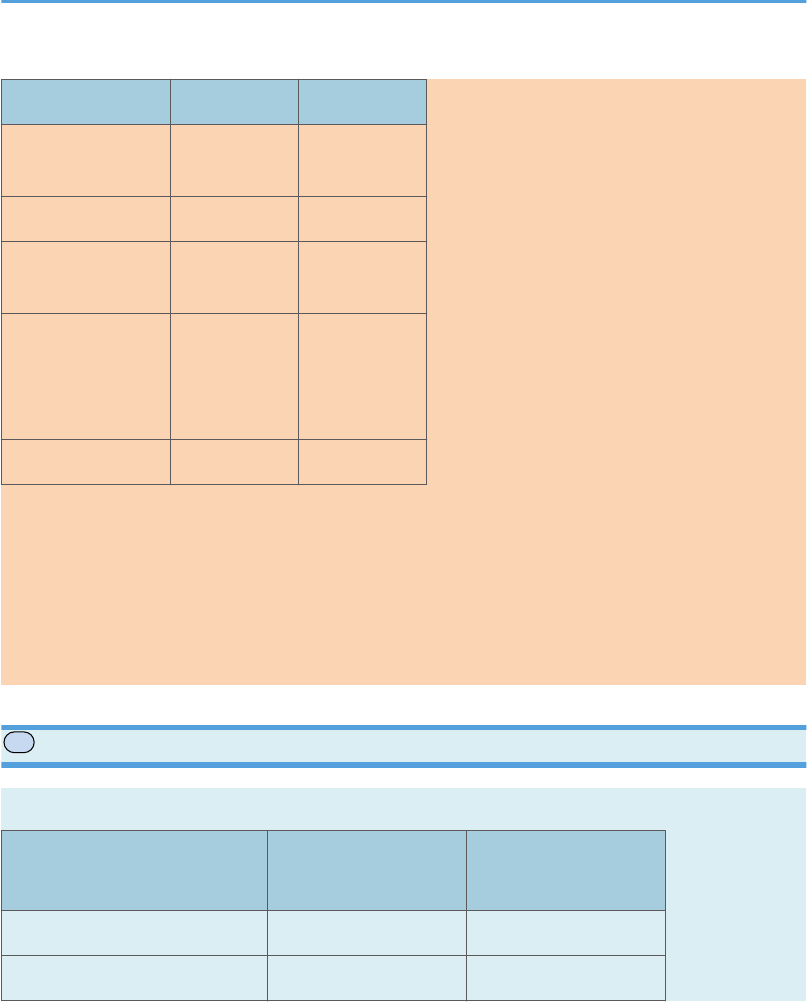
SP 221S SP 221SF
Ethernet Port
(Network)
Not available Not available
Wireless LAN Not available Not available
Scan to
Email/FTP/Folder
Not available Not available
Toner
Management
(Toner Level
Indication)
Not available
Available
Available*1
Paperless FAX*2 Not available Not available
*1 Depending on the [Toner End Option] setting, the toner management (toner level indication) function may not
be available. For [Toner End Option], see page 182 "System Settings".
*2 "Paperless FAX" refers to the function that allows you to store faxes in memory and print only the ones you
want, thus saving paper. "Paperless FAX" refers to [Reception File Processing] and [Notify Forward Status]
that can be specified using the machine's control panel and [Fax Received File Processing] that can be
specified using Web Image Monitor. For details, see page 176 "Fax Features Settings" and page 208
"Configuring the System Settings".
P
Differences in Performance/Functions between Different Models
The differences in main performance/functions between different models are as follows:
SP 221 SP 220Nw
SP 221Nw
Ethernet Port (Network) Not available Available
Wireless LAN Not available Available
16 opal-p3_mf3_com_user_guide_gb_00228414_eng.xml
Draft 2016/05/27
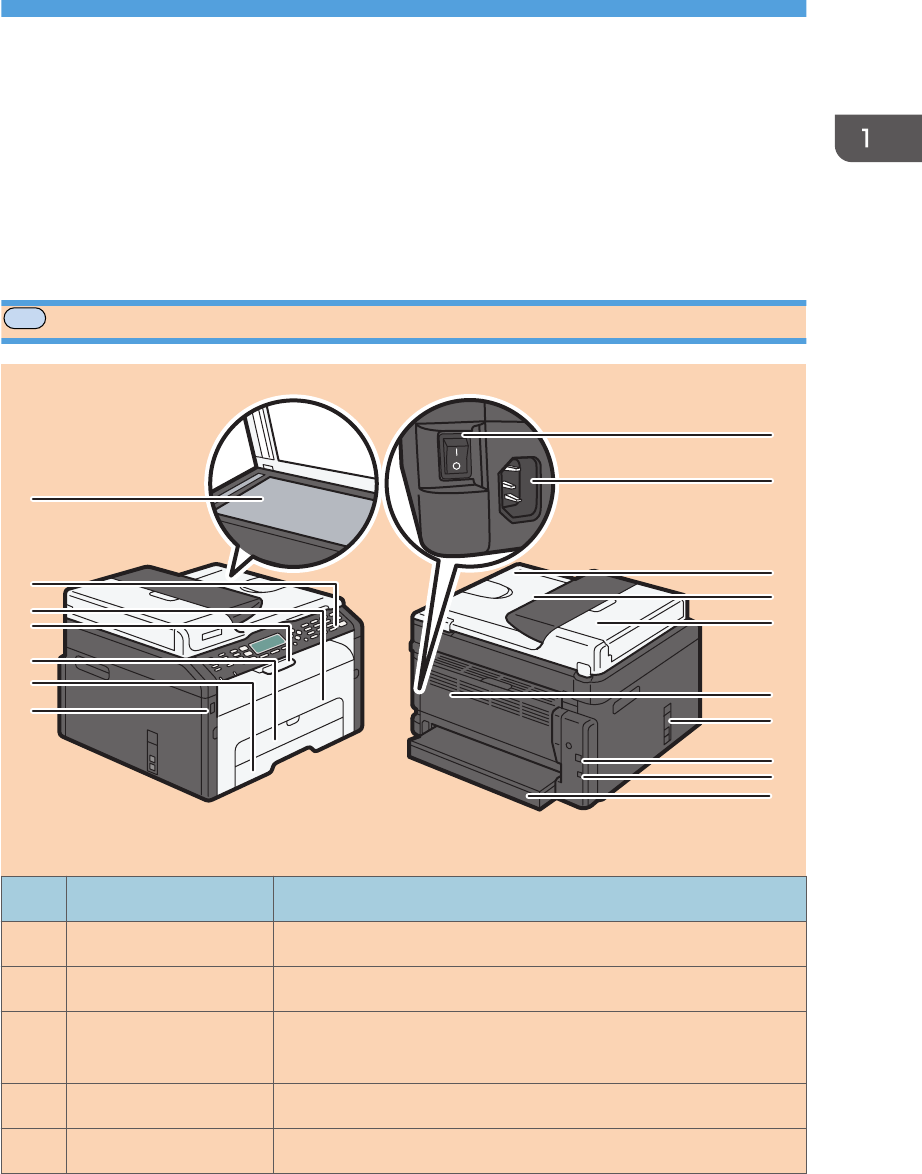
1. Guide to the Machine
This chapter describes preparations for using the machine and its operating instructions.
Guide to Components
This section introduces the names of the various parts on the front and rear side of the machine and
outlines their functions.
MF
Exterior
DCT067
2
8
1
6
3
7
4
5
9
10
11
14
13
12
16
15
17
No. Name Description
1 Exposure Glass Place originals here sheet by sheet.
2 Control Panel Contains a screen and keys for machine control.
3 Front Cover Open this cover to replace the print cartridge or remove jammed
paper.
4 Stop Fences Raise this fence to prevent paper from falling off.
5 Bypass Tray This tray can hold one sheet of plain paper.
opal-p3_mf3_com_user_guide_gb_00228417_eng.xml 17
Draft 2016/05/27
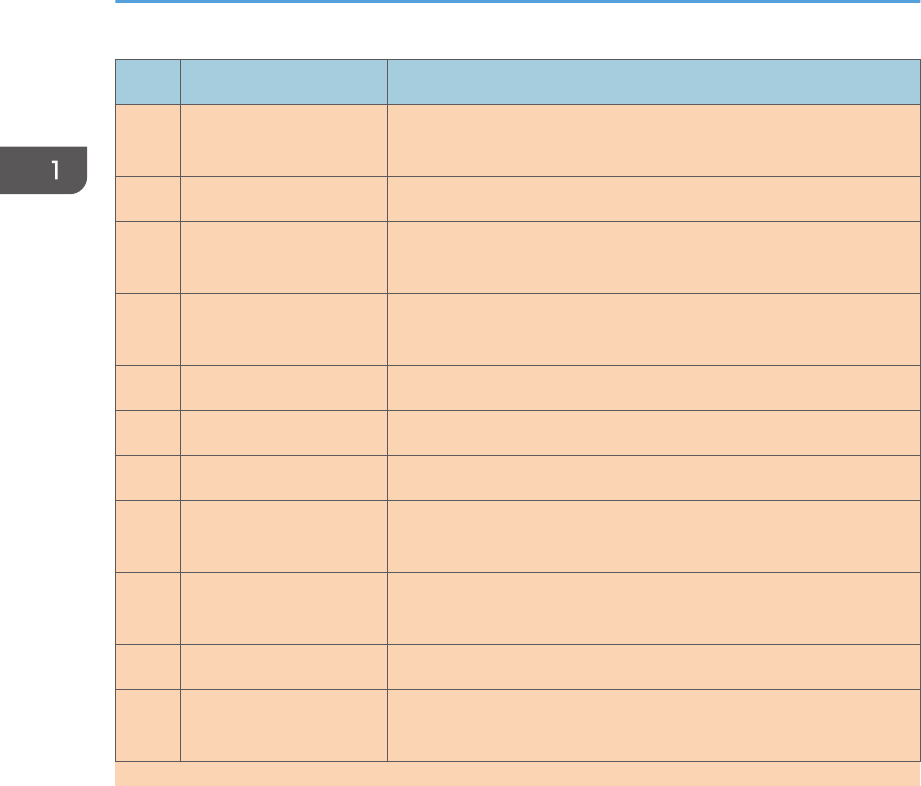
No. Name Description
5 Cover for the Exposure
Glass
Open this cover to place originals on the exposure glass.
6 Tray 1 This tray can hold up to 150 sheets of plain paper.
10 Auto Document Feeder
(Exposure Glass Cover)
The ADF is integrated with the exposure glass cover. Open this
cover to place documents on the exposure glass.
11 Input Tray for the ADF Place stacks of originals here. They will feed in automatically. This
tray can hold up to 35 sheets of plain paper.
11 Tray Cover Attach this cover when you extend the tray.
12 ADF Cover Open this cover to remove originals jammed in the ADF.
13 Rear Cover Open this cover to remove jammed paper.
14 External Telephone
Connector
For connecting an external telephone.
14 G3 (analog) Line
Interface Connector
For connecting a telephone line.
15 USB Port For connecting the machine to a computer using a USB cable.
16 Ethernet Port For connecting the machine to the network using a network
interface cable.
1. Guide to the Machine
18 opal-p3_mf3_com_user_guide_gb_00228417_eng.xml
Draft 2016/05/27
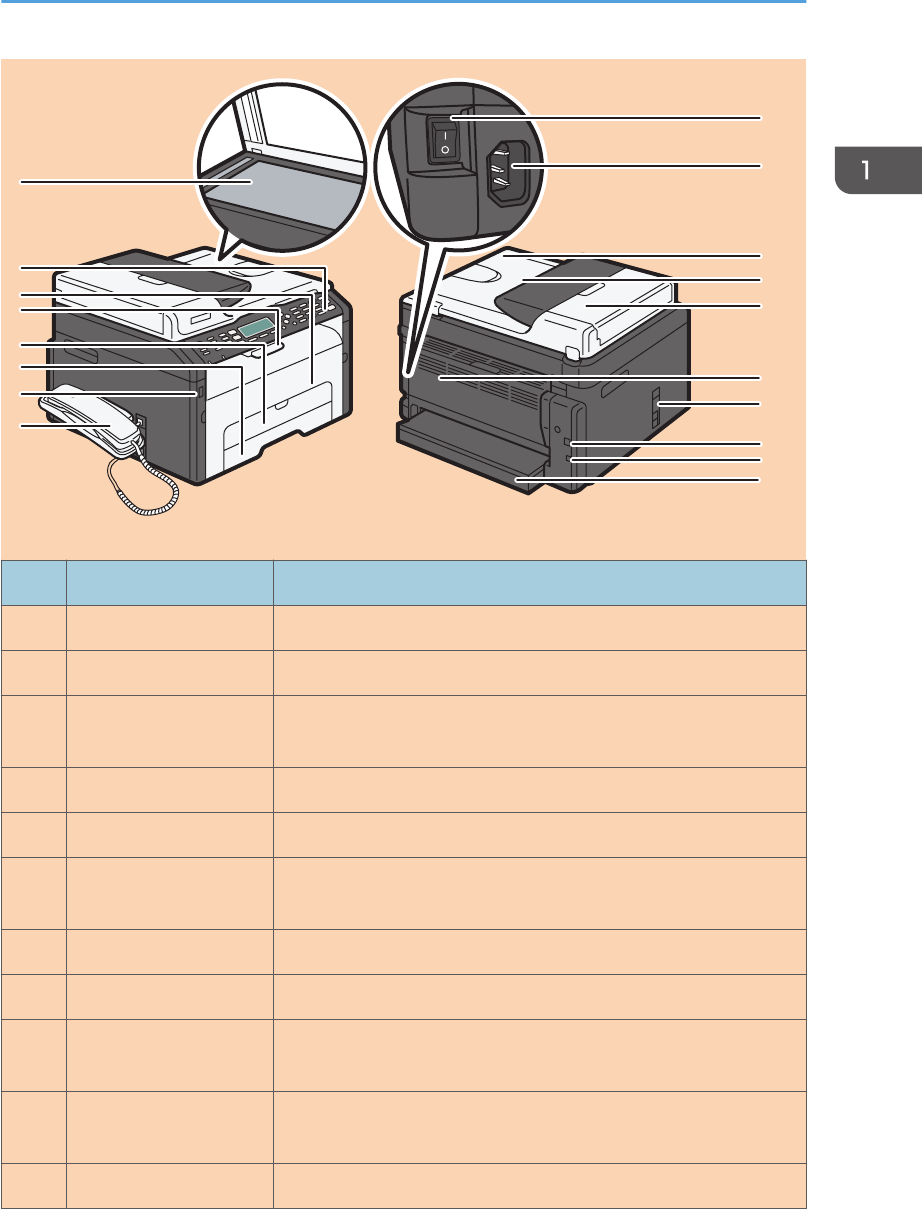
DCT881
2
9
1
6
3
7
8
4
5
11
10
12
15
14
13
17
16
18
No. Name Description
1 Exposure Glass Place originals here sheet by sheet.
2 Control Panel Contains a screen and keys for machine control.
3 Front Cover Open this cover to replace the print cartridge or remove jammed
paper.
4 Stop Fences Raise this fence to prevent paper from falling off.
5 Bypass Tray This tray can hold one sheet of plain paper.
5 Cover for the Exposure
Glass
Open this cover to place originals on the exposure glass.
6 Tray 1 This tray can hold up to 150 sheets of plain paper.
8 Handset Enables you to use the machine as a telephone.
10 Auto Document Feeder
(Exposure Glass Cover)
The ADF is integrated with the exposure glass cover. Open this
cover to place documents on the exposure glass.
11 Input Tray for the ADF Place stacks of originals here. They will feed in automatically. This
tray can hold up to 35 sheets of plain paper.
11 Tray Cover Attach this cover when you extend the tray.
Guide to Components
opal-p3_mf3_com_user_guide_gb_00228417_eng.xml 19
Draft 2016/05/27
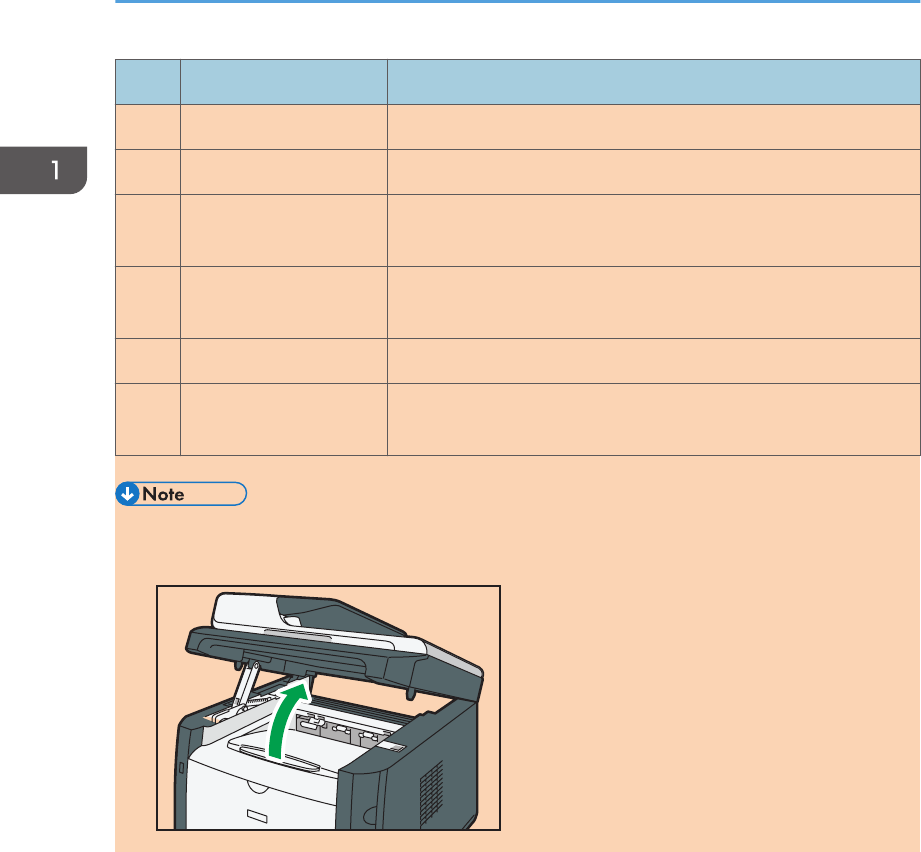
No. Name Description
12 ADF Cover Open this cover to remove originals jammed in the ADF.
13 Rear Cover Open this cover to remove jammed paper.
14 External Telephone
Connector
For connecting an external telephone.
14 G3 (analog) Line
Interface Connector
For connecting a telephone line.
15 USB Port For connecting the machine to a computer using a USB cable.
16 Ethernet Port For connecting the machine to the network using a network
interface cable.
• If it is difficult to take printed paper out of the output tray, you can lift the control panel and make it
easier to take the printed paper out.
DSG102
1. Guide to the Machine
20 opal-p3_mf3_com_user_guide_gb_00228417_eng.xml
Draft 2016/05/27
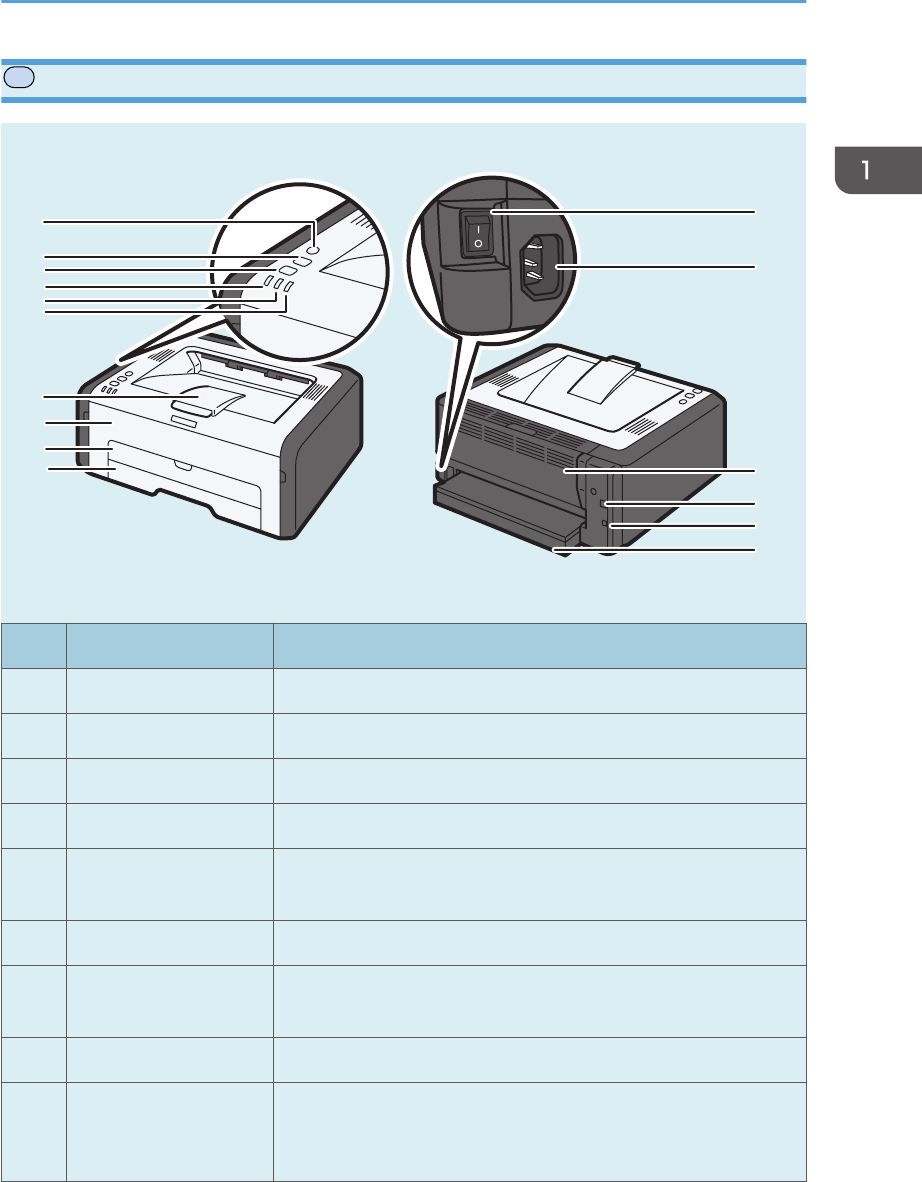
P
Exterior
DCT831
2
111
5
6
7
8
9
10
12
13
15
14
16
4
3
No. Name Description
1 Stop Fences Raise this fence to prevent paper from falling off.
2 Front Cover Lift up this cover to replace consumables or clear a paper jam.
3 Bypass Tray This tray can hold one sheet of plain paper.
4 Tray 1 This tray can hold up to 150 sheets of plain paper.
6 Rear Cover Open this cover to deliver sheets face up or remove jammed
paper.
7 USB Port Use a USB cable to connect the printer to the host computer.
8 Ethernet Port Use a network interface cable to connect the printer to the
network.
9 Tray 1 Cover Attach this cover when you extend the tray.
xx Control Panel The keys to operate the machine and the indicators for checking
the status of the machine are on this control panel. For details, see
page 26 "Control Panel".
Guide to Components
opal-p3_mf3_com_user_guide_gb_00228417_eng.xml 21
Draft 2016/05/27
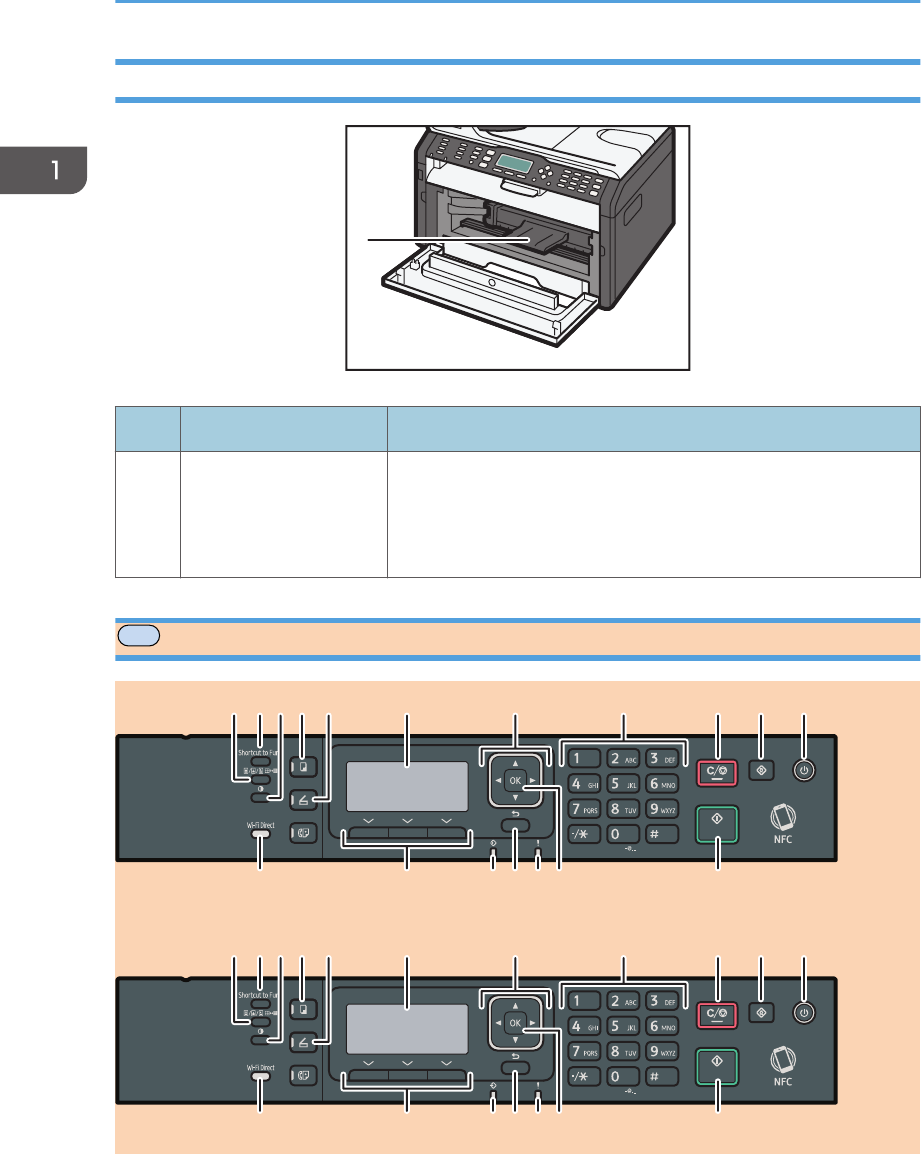
Interior
DCT064
1
No. Name Description
1 Print Cartridge A replacement consumable that is required to make prints on
paper. It needs to be replaced when the Toner/Paper End
indicator flashes red. For details about replacing the cartridge, see
page 253 "Replacing the Print Cartridge".
MF
Control Panel (When Using SP 221S, SP 220SNw, or SP221SNw)
DSH107
12345 6 7 8 9 10 11
12 1713 14 15 16 18
DSH107
12345 6 7 8 9 10 11
12 1713 14 15 16 18
1. Guide to the Machine
22 opal-p3_mf3_com_user_guide_gb_00228417_eng.xml
Draft 2016/05/27
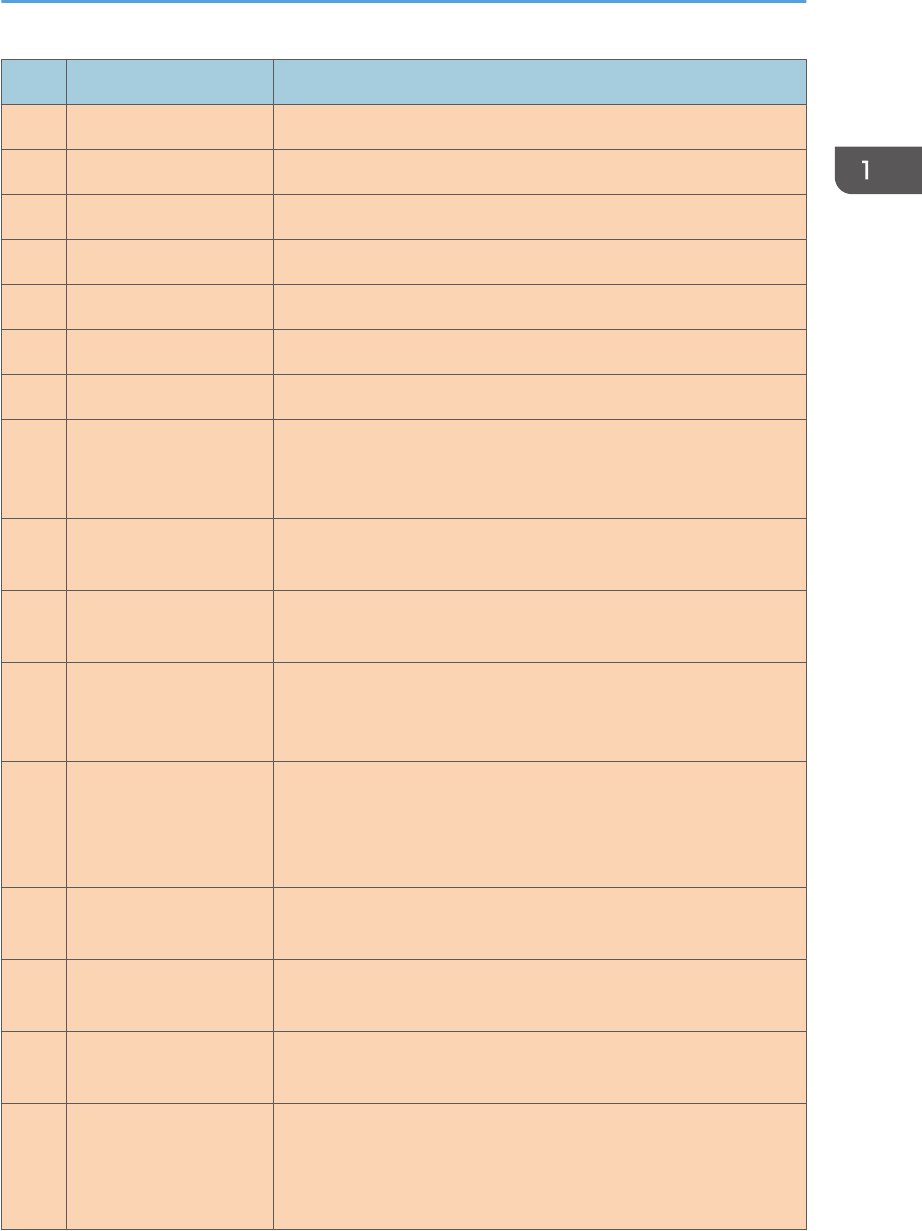
No. Name Description
1 [Image Quality] key Press to select the scan quality for the current job.
2 [Shortcut to Func.] key Press to use the function pre-assigned to this key.
3 [Density] key Press to adjust the image density for the current job.
4 [Copy] key Press to switch the machine to copier mode.
5 [Scanner] key Press to switch the machine to scanner mode.
6 Screen Displays the current status and messages.
7 Scroll Keys Press to move the cursor in the direction indicated by the key.
8 Number Keys Press to enter numerical values when specifying settings such as
fax numbers and copy quantities or to enter letters when specifying
names.
9 [Clear/Stop] key Press to cancel or stop print jobs, document copying, scanning,
fax transmission/reception, and other actions in progress.
10 [User Tools] key Press to display the menu for configuring the machine's system
settings.
11 [Power] key This indicator lights up blue when the machine is turned on. It
flashes when a print job is received and during printing, scanning,
or fax transmission/reception.
12 [Wi-Fi Direct] key (only
SP 220SNw and SP
221SNw)
Press this key to activate or deactivate the Wi-Fi Direct function.
Pressing this key while Wi-Fi is disabled activates Wi-Fi and
reboots the machine automatically. This indicator lights blue when
the Wi-Fi Direct function is active.
14 Selection keys Press the key underneath an item shown on the bottom line of the
screen to select it.
15 Data In Indicator This indicator lights blue when the machine receives print data
from the host device.
16 [Back] key Press to cancel the last operation or to return to the previous level
of the menu tree.
17 Alert Indicator This indicator lights up red when the machine runs out of paper or
consumables, when the paper settings do not match the settings
specified by the driver, or when other errors occur. It flashes when
the toner is nearly empty.
Guide to Components
opal-p3_mf3_com_user_guide_gb_00228417_eng.xml 23
Draft 2016/05/27
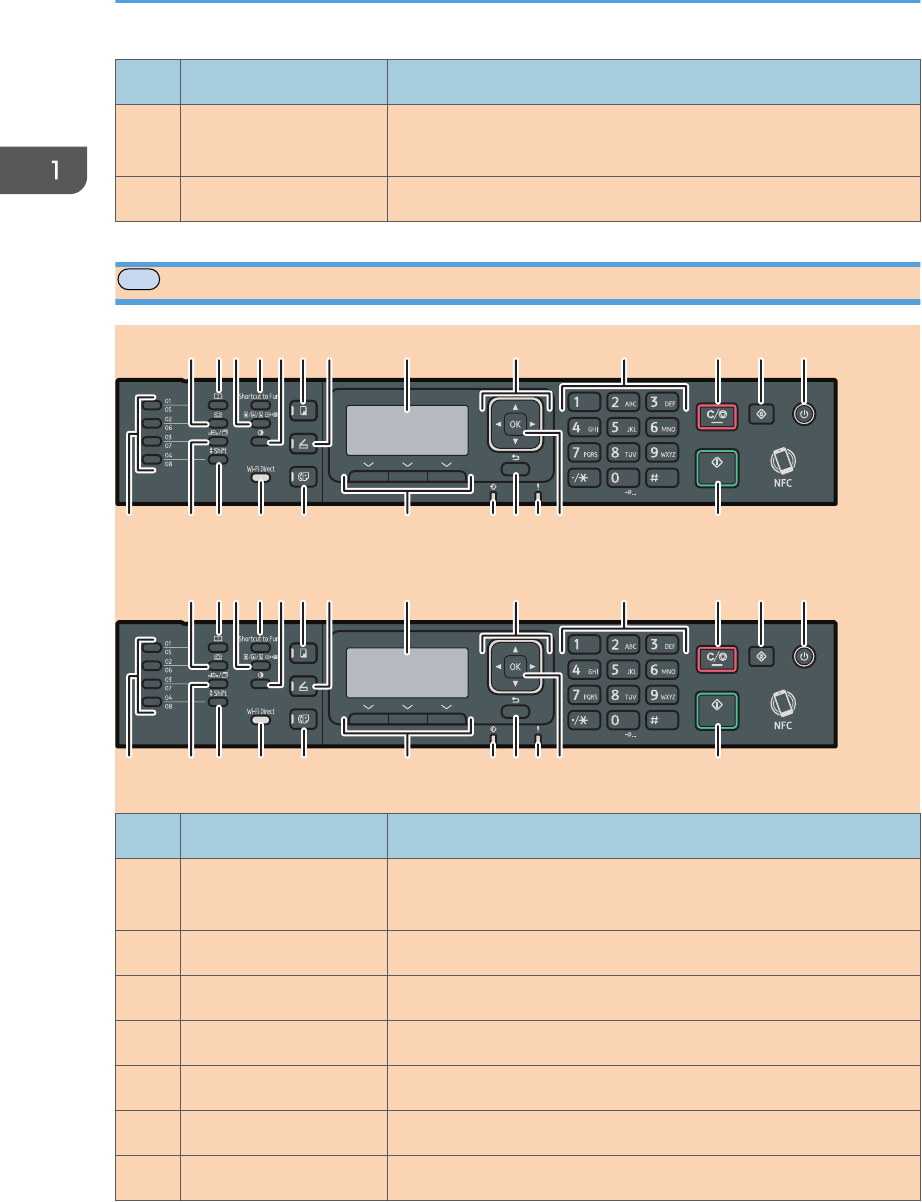
No. Name Description
18 [OK] Key Press to confirm settings and specified values, or to move to the
next menu level.
19 [Start] key Press to start fax transmission/reception, scanning, or copying.
MF
Control Panel (When Using SP 221SF, SP 220SFNw, or SP221SFNw)
1234567 8 9 10 11 12 13
14 15 16 17 18 19 20 21 22 24
DSH108
23
1234567 8 9 10 11 12 13
14 15 16 17 18 19 20 21 22 24
DSH108
23
No. Name Description
1 [On Hook Dial] key Press to use on-hook dialing to check the destination's status when
sending a fax.
2 [Address Book] key Press to select a scan or fax destination from the Address Book.
3 [Image Quality] key Press to select the scan quality for the current job.
4 [Shortcut to Func.] key Press to use the function pre-assigned to this key.
5 [Density] key Press to adjust the image density for the current job.
6 [Copy] key Press to switch the machine to copier mode.
7 [Scanner] key Press to switch the machine to scanner mode.
1. Guide to the Machine
24 opal-p3_mf3_com_user_guide_gb_00228417_eng.xml
Draft 2016/05/27

No. Name Description
8 Screen Displays the current status and messages.
9 Scroll Keys Press to move the cursor in the direction indicated by the key.
10 Number Keys Press to enter numerical values when specifying settings such as
fax numbers and copy quantities or to enter letters when specifying
names.
11 [Clear/Stop] key Press to cancel or stop print jobs, document copying, scanning,
fax transmission/reception, and other actions in progress.
12 [User Tools] key Press to display the menu for configuring the machine's system
settings.
13 [Power] key This indicator lights up blue when the machine is turned on. It
flashes when a print job is received and during printing, scanning,
or fax transmission/reception.
14 One Touch buttons Press to select a scan or fax Quick Dial destination.
15 [Pause/Redial] key Press to insert a pause in a fax number or to display the last used
scan or fax destination.
16 [Shift] key Press to use the Quick Dial numbers 5 to 8 when specifying a scan
or fax destination using the One Touch buttons.
17 [Wi-Fi Direct] key (only
SP 220SFNw and SP
221SFNw)
Press this key to activate or deactivate the Wi-Fi Direct function.
Pressing this key while Wi-Fi is disabled activates Wi-Fi and
reboots the machine automatically. This indicator lights blue when
the Wi-Fi Direct function is active.
19 [Facsimile] key Press to switch the machine to fax mode.
20 Selection keys Press the key underneath an item shown on the bottom line of the
screen to select it.
21 Data In Indicator This indicator lights blue when the machine receives print data
from the host device.
22 [Back] key Press to cancel the last operation or to return to the previous level
of the menu tree.
23 Alert Indicator This indicator lights up red when the machine runs out of paper or
consumables, when the paper settings do not match the settings
Guide to Components
opal-p3_mf3_com_user_guide_gb_00228417_eng.xml 25
Draft 2016/05/27
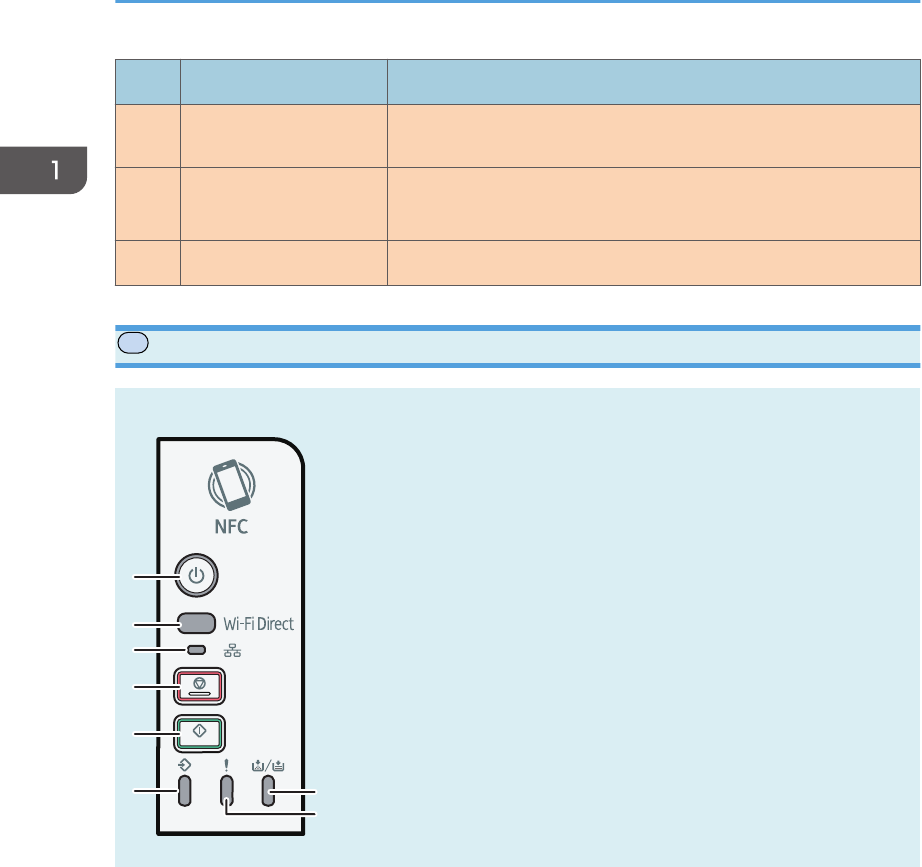
No. Name Description
specified by the driver, or when other errors occur. It flashes when
the toner is nearly empty.
24 [OK] Key Press to confirm settings and specified values, or to move to the
next menu level.
25 [Start] key Press to start fax transmission/reception, scanning, or copying.
P
Control Panel
This section introduces the names of the parts of the control panel and explains their functions.
1
2
3
4
5
67
8
DSH109
1. Guide to the Machine
26 opal-p3_mf3_com_user_guide_gb_00228417_eng.xml
Draft 2016/05/27
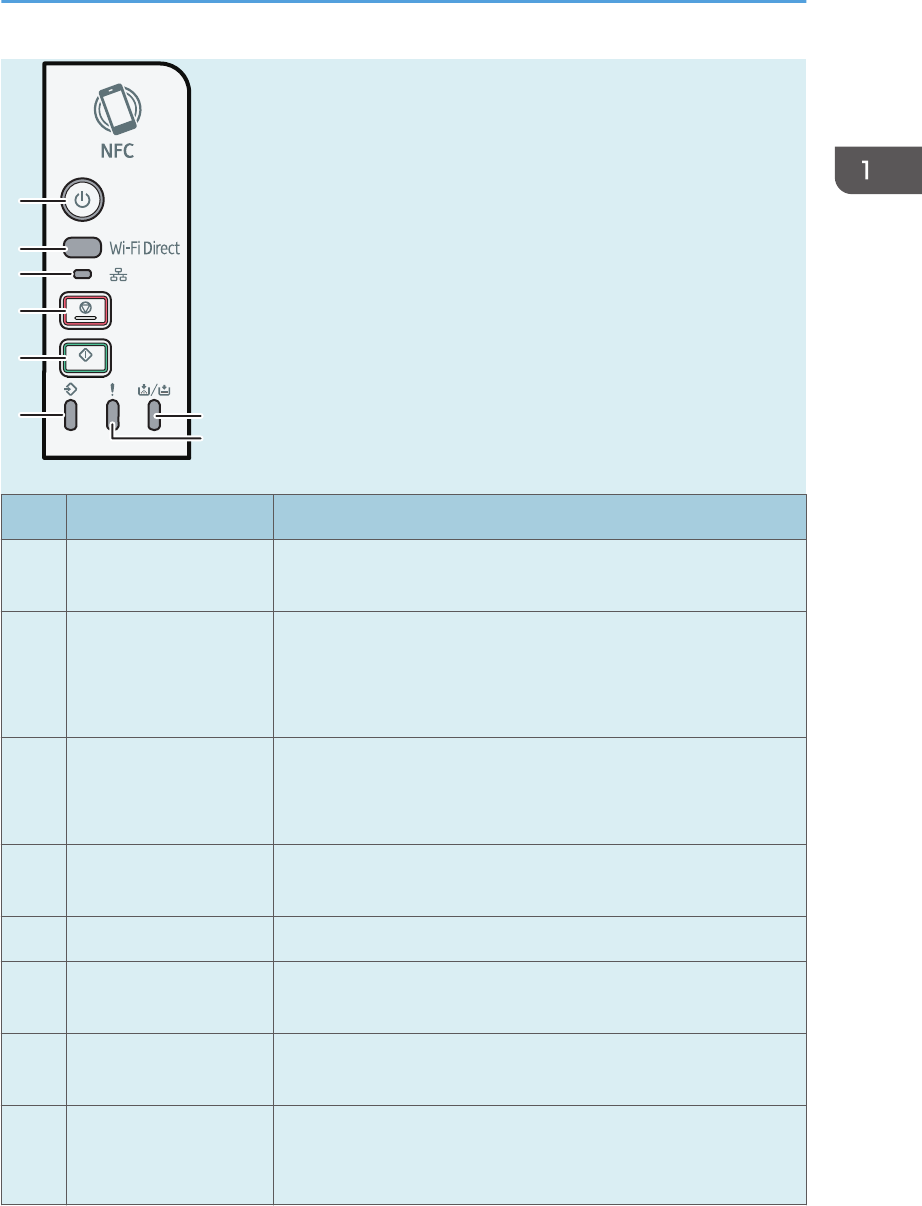
1
2
3
4
5
67
8
DSH109
No. Name Description
1 [Power] key This indicator lights blue when the machine is turned on. It flashes
when a print job is received.
2 [Wi-Fi Direct] key (only
SP 220Nw and SP
221Nw)
Press this key to activate or deactivate the Wi-Fi Direct function.
Pressing this key while Wi-Fi is disabled activates Wi-Fi and
reboots the machine automatically. This indicator lights blue when
the Wi-Fi Direct function is active.
3 Network Indicator
(only SP 220Nw and
SP 221Nw)
This indicator lights blue when the network is connected.
4 [Stop] key Press this key once to pause a job that is currently printing. To
cancel a job, press it again.
5 [Start] key Press to restart the printing job.
6 Data In Indicator This indicator lights blue when the machine receives print data
from the host device.
7 Toner/Paper End
Indicator
This indicator lights red when the machine runs out of paper or
toner. It flashes when the toner is nearly empty.
8 Alert Indicator This indicator flashes red when paper jams occur, and it lights
when the paper settings do not match the settings specified by the
driver, and when other errors occur.
Guide to Components
opal-p3_mf3_com_user_guide_gb_00228417_eng.xml 27
Draft 2016/05/27

• For details about printing a list of the machine's configurations or about doing a test print using
Smart Organizing Monitor, see page 246 "Using Smart Organizing Monitor".
1. Guide to the Machine
28 opal-p3_mf3_com_user_guide_gb_00228417_eng.xml
Draft 2016/05/27
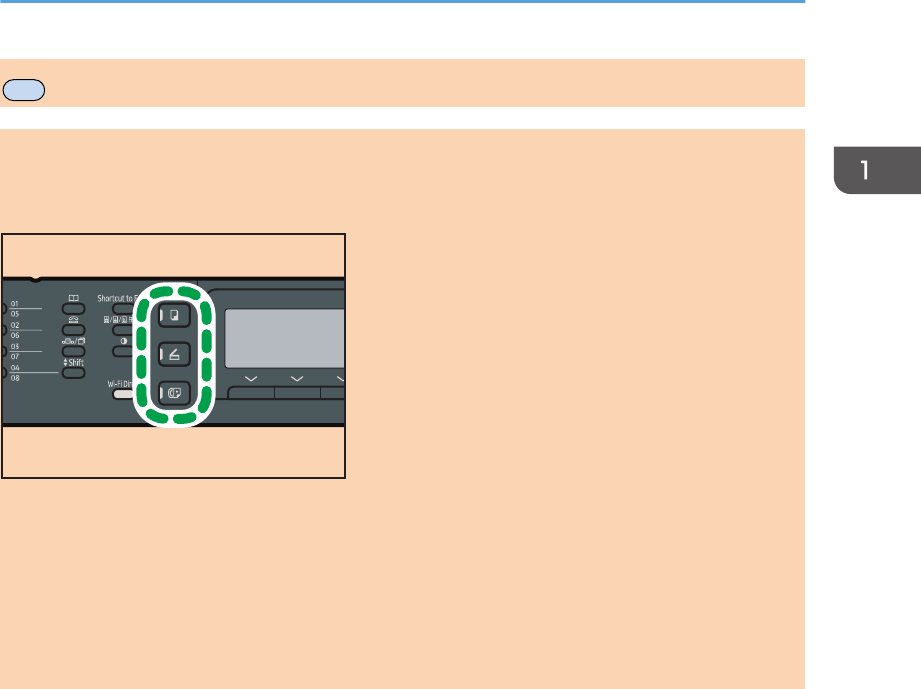
MF
Changing Operation Modes
You can switch between copier, scanner, and fax modes by pressing the corresponding keys.
Press the [Copy], [Scanner], or [Facsimile] (only SP 221SF, SP 220SFNw, and SP 221SFNw) key to
activate each mode. While in each mode, the corresponding key lights up.
DSH140
Function Priority
By default, copy mode is selected when the machine is turned on, or if the preset [System Auto
Reset Timer] time passes with no operation while the initial screen of the current mode is displayed.
You can change the selected mode using [Function Priority] under [Admin. Tools].
For details about [System Auto Reset Timer] or [Function Priority], see page 189 "Administrator
Settings".
Changing Operation Modes
opal-p3_mf3_com_user_guide_gb_00228418_eng.xml 29
Draft 2016/05/27
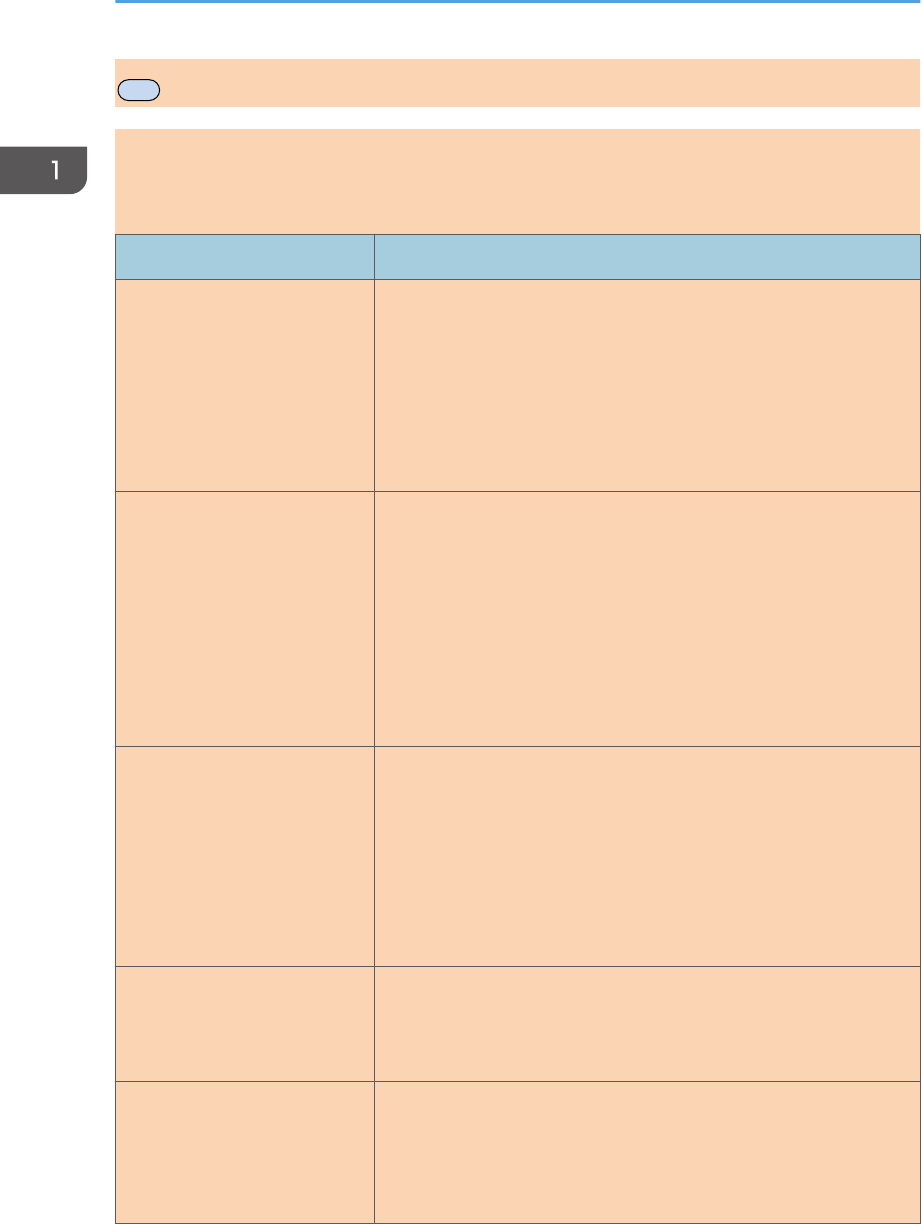
MF
Multi-access
This machine can perform multiple jobs using different functions, such as copying and faxing, at the
same time. Performing multiple functions simultaneously is called “Multi-access”.
The following table shows the functions that can be performed simultaneously.
Current job Job that you want to execute simultaneously
Copying • Fax memory transmission
• Fax memory reception
• Receiving a print job from a computer (the actual printing starts
after copying is finished)
• Receiving a LAN-Fax job from a computer
• LAN-Fax transmission
Scanning • Fax memory transmission
• Fax immediate printing
• Fax memory reception
• Printing a fax received in the machine's memory
• Printing
• Receiving a LAN-Fax job from a computer
• LAN-Fax transmission
Scanning a fax into the
machine's memory before
transmission
• Fax memory transmission
• Fax immediate printing
• Fax memory reception
• Printing a fax received in the machine's memory
• Printing
• Receiving a LAN-Fax job from a computer
Fax immediate transmission
(scanning an original and
sending it simultaneously)
• Printing a fax received in the machine's memory
• Printing
• Receiving a LAN-Fax job from a computer
Fax memory transmission
(sending a fax that has already
been stored in the machine's
memory)
• Copying
• Scanning
• Scanning a fax into the machine's memory before transmission
• Printing a fax received in the machine's memory
1. Guide to the Machine
30 opal-p3_mf3_com_user_guide_gb_00228419_eng.xml
Draft 2016/05/27
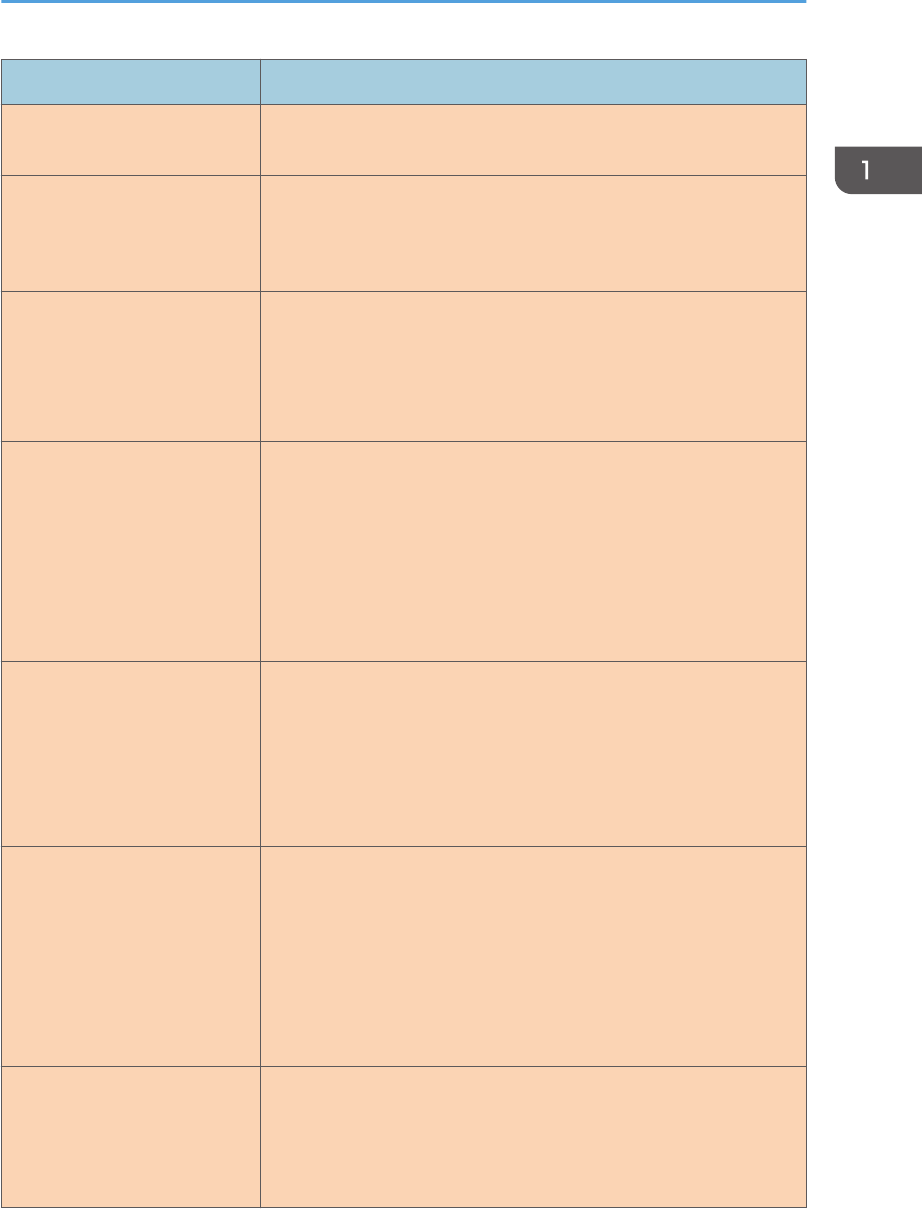
Current job Job that you want to execute simultaneously
• Printing
• Receiving a LAN-Fax job from a computer
Fax immediate printing
(receiving a fax and printing it
simultaneously)
• Scanning *1
• Scanning a fax into the machine's memory before transmission
• Receiving a LAN-Fax job from a computer
Fax memory reception (storing
a received fax into the
machine's memory)
• Copying
• Scanning
• Scanning a fax into the machine's memory before transmission
• Receiving a LAN-Fax job from a computer
Printing a fax received in the
machine's memory
• Scanning *1
• Scanning a fax into the machine's memory before transmission
• Fax immediate transmission
• Fax memory transmission
• Receiving a LAN-Fax job from a computer
• LAN-Fax transmission
Printing • Scanning
• Scanning a fax into the machine's memory before transmission
• Fax immediate transmission
• Fax memory transmission
• LAN-Fax transmission
Receiving a LAN-Fax job from
a computer
• Copying
• Scanning
• Fax immediate printing
• Fax memory reception
• Printing a fax received in the machine's memory
• LAN-Fax transmission
LAN-Fax transmission • Copying
• Scanning
• Scanning a fax into the machine's memory before transmission
• Printing a fax received in the machine's memory
Multi-access
opal-p3_mf3_com_user_guide_gb_00228419_eng.xml 31
Draft 2016/05/27
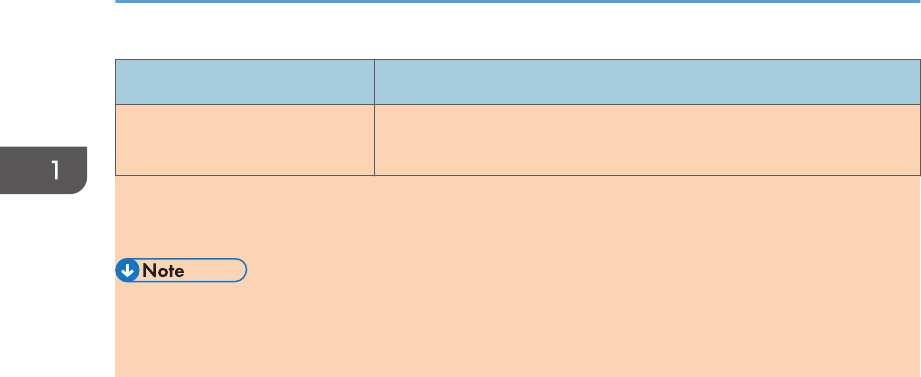
Current job Job that you want to execute simultaneously
• Printing
• Receiving a LAN-Fax job from a computer
*1 Fax printing may take longer than normal if you scan using the control panel at the same time, especially
when scanning multiple pages using the exposure glass.
• If you try to use a function that cannot be performed simultaneously, you will hear a beep sound
from the machine or see a failure message pop up on your computer screen. In this case, try again
after the current job is finished.
1. Guide to the Machine
32 opal-p3_mf3_com_user_guide_gb_00228419_eng.xml
Draft 2016/05/27
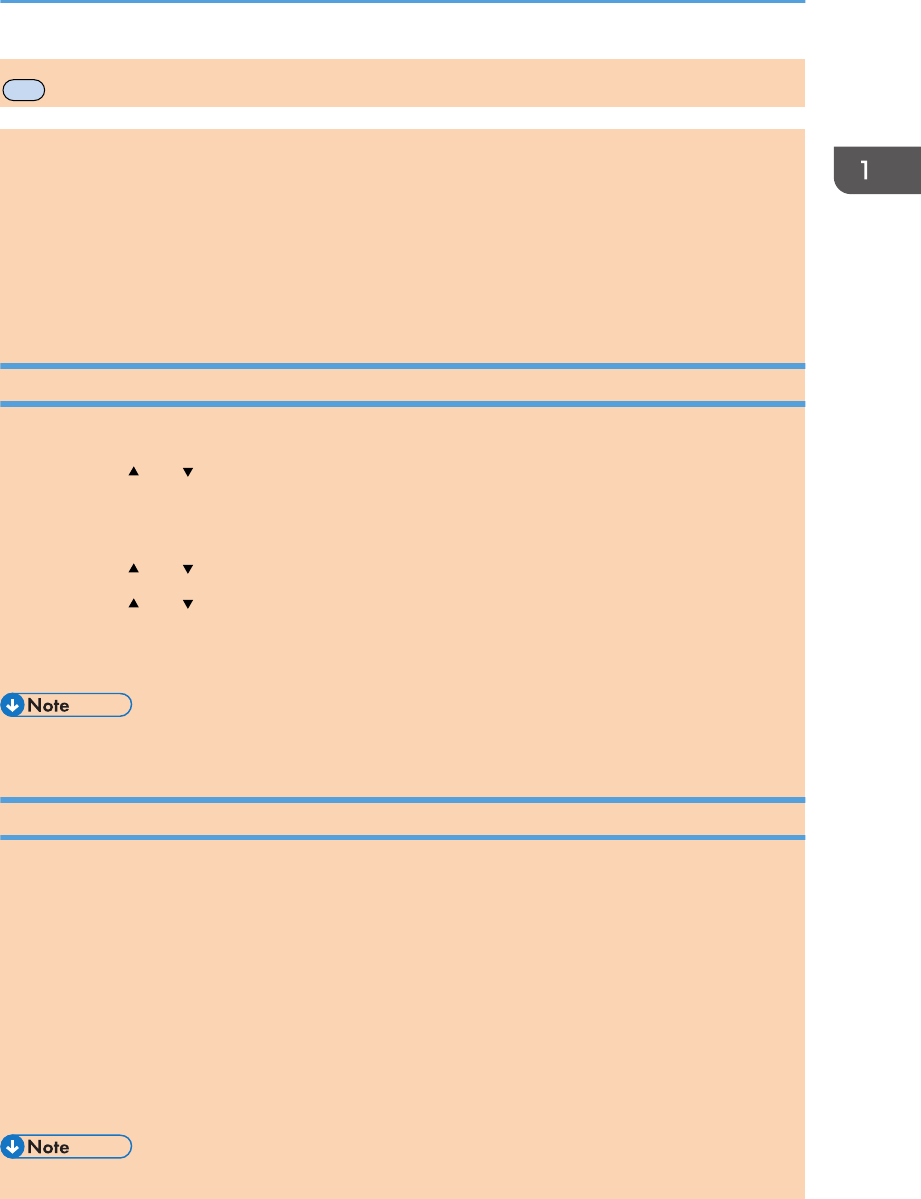
MF
Assigning a Setting to the Short Cut Key
You can access a frequently-used setting with a single keystroke by assigning the setting to the [Shortcut
to Func.] key.
You can configure settings for the following 3 function:
• ID Card Copy Mode
• Fax Immediate TX
• Select Scanner Dest.
Assigning a Setting Using the Control Panel
1. Press the [User Tools] key.
2. Press the [ ] or [ ] key to select [Admin. Tools], and then press the [OK] key.
3. If you are requested to enter a password, enter the password using the number keys,
and then press the [OK] key.
4. Press the [ ] or [ ] key to select [Shortcut to Function], and then press the [OK] key.
5. Press the [ ] or [ ] key to select the setting you want to configure, and then press the
[OK] key.
6. Press the [User Tools] key to return to the initial screen.
• A password for accessing the [Admin. Tools] menu can be specified in [Admin. Tools Lock].
Assigning a Setting Using Web Image Monitor
1. Start the Web browser, and enter "http://(the machine's IP address or host name)/" in
the address bar.
2. Click [System Settings].
3. Click the [Shortcut to Function] tab.
4. Specify the setting you want to configure from [Shortcut to Function].
5. Enter the administrator password.
6. Click [OK].
7. Close the Web browser.
• For details about [Administrator], see page 228 "Configuring the Administrator Settings".
Assigning a Setting to the Short Cut Key
opal-p3_mf3_com_user_guide_gb_00228420_eng.xml 33
Draft 2016/05/27
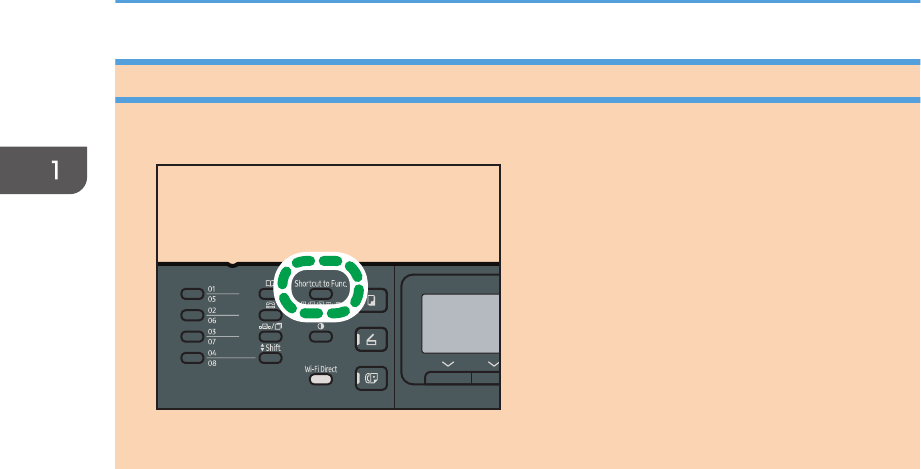
Accessing the Function Assigned to the Short Cut Key
1. Press the [Shortcut to Func.] key.
DSH141
The function assigned to the [Shortcut to Func.] key is displayed.
1. Guide to the Machine
34 opal-p3_mf3_com_user_guide_gb_00228420_eng.xml
Draft 2016/05/27
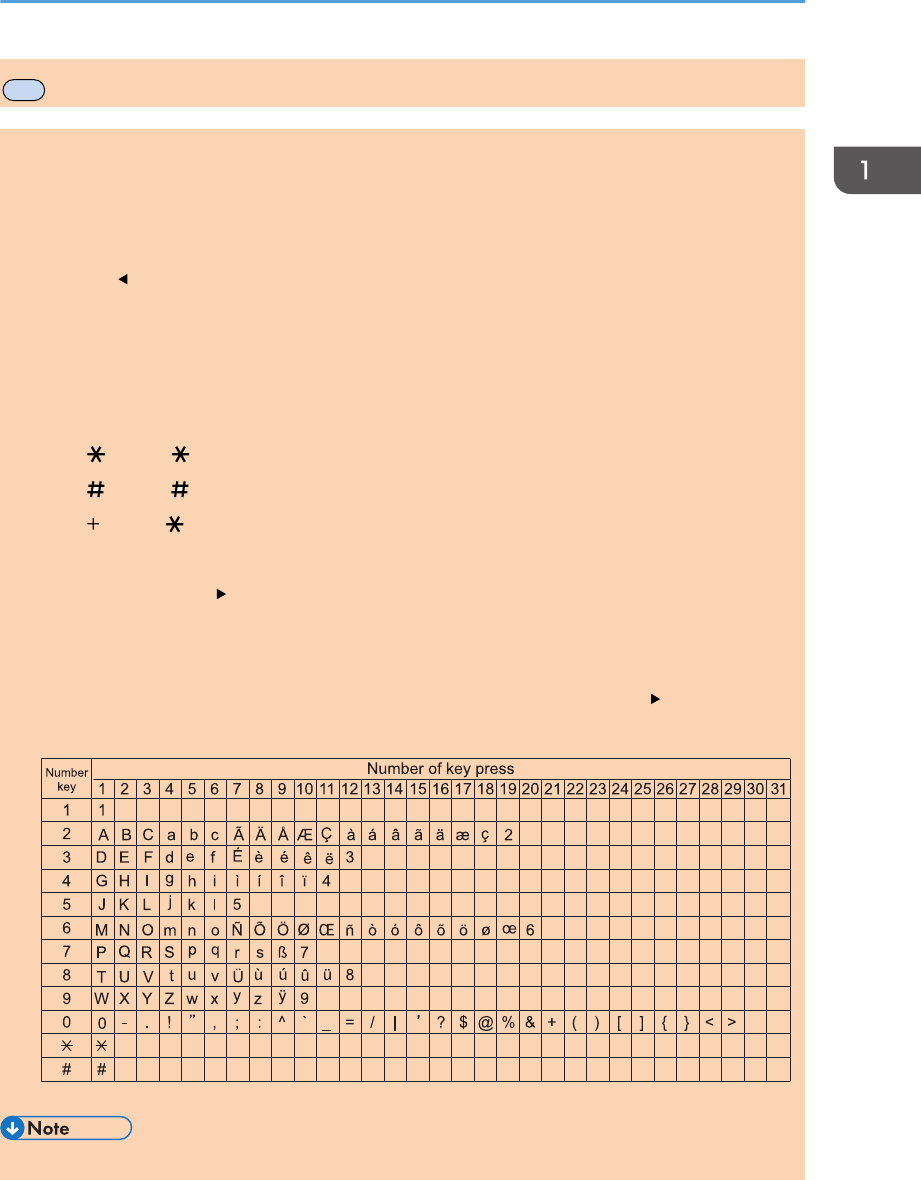
MF
Entering Characters
To enter characters, use keys as follows:
To enter a digit
Press a number key.
To delete a character
Press the [ ] key.
To enter a fax number
• To enter a number
Use the number keys.
• To enter characters other than digits
" ": Press [ ].
" ": Press [ ].
" ": Press [ ].
Pause: Press the [Pause/Redial] key. "P" appears on the screen.
Space: Press the [ ] key.
To enter a name
Letters, numbers, and symbols can be entered using the number keys.
To enter two characters consecutively that use the same number key, press the [ ] key to move the
cursor before entering the second character.
DCT843
\~
• Characters you can enter depend on the setting you are configuring.
Entering Characters
opal-p3_mf3_com_user_guide_gb_00228421_eng.xml 35
Draft 2016/05/27

• If the number you entered is too large or too small for the setting, it will not be accepted. If you
press the [OK] key, the machine will increase or decrease the number to the minimum or maximum
value for the setting.
1. Guide to the Machine
36 opal-p3_mf3_com_user_guide_gb_00228421_eng.xml
Draft 2016/05/27
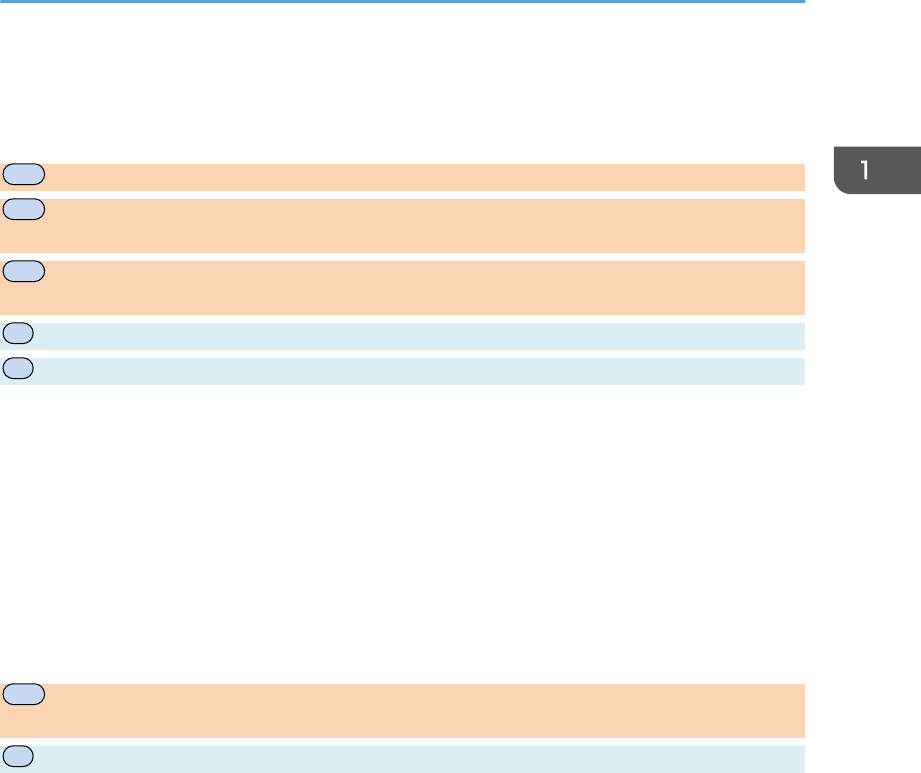
About Operation Tools
This section explains the operation tools of this machine.
MF
Control Panel
MF
The control panel contains a screen and keys for controlling the machine. They allow you to
configure the machine's various settings.
MF
For details about how to use the control panel, see page 165 "Configuring the Machine Using
the Control Panel".
P
Control Panel
P
The control panel contains keys for controlling the machine.
Smart Organizing Monitor
Install this utility on your computer from the included CD-ROM before using it.
Using Smart Organizing Monitor, you can check the machine's status, configure its settings, and use
other functions.
For details about how to use Smart Organizing Monitor, see page 246 "Using Smart Organizing
Monitor".
Web Image Monitor
You can check the machine's status and configure its settings by accessing the machine directly using
Web Image Monitor.
MF
For details about how to use Web Image Monitor, see page 201 "Configuring the Machine
Using Utilities".
P
For details about how to use Web Image Monitor, see page 233 "Using Web Image Monitor".
About Operation Tools
opal-p3_mf3_com_user_guide_gb_00228422_eng.xml 37
Draft 2016/05/27

1. Guide to the Machine
38 opal-p3_mf3_com_user_guide_gb_00228422_eng.xml
Draft 2016/05/27
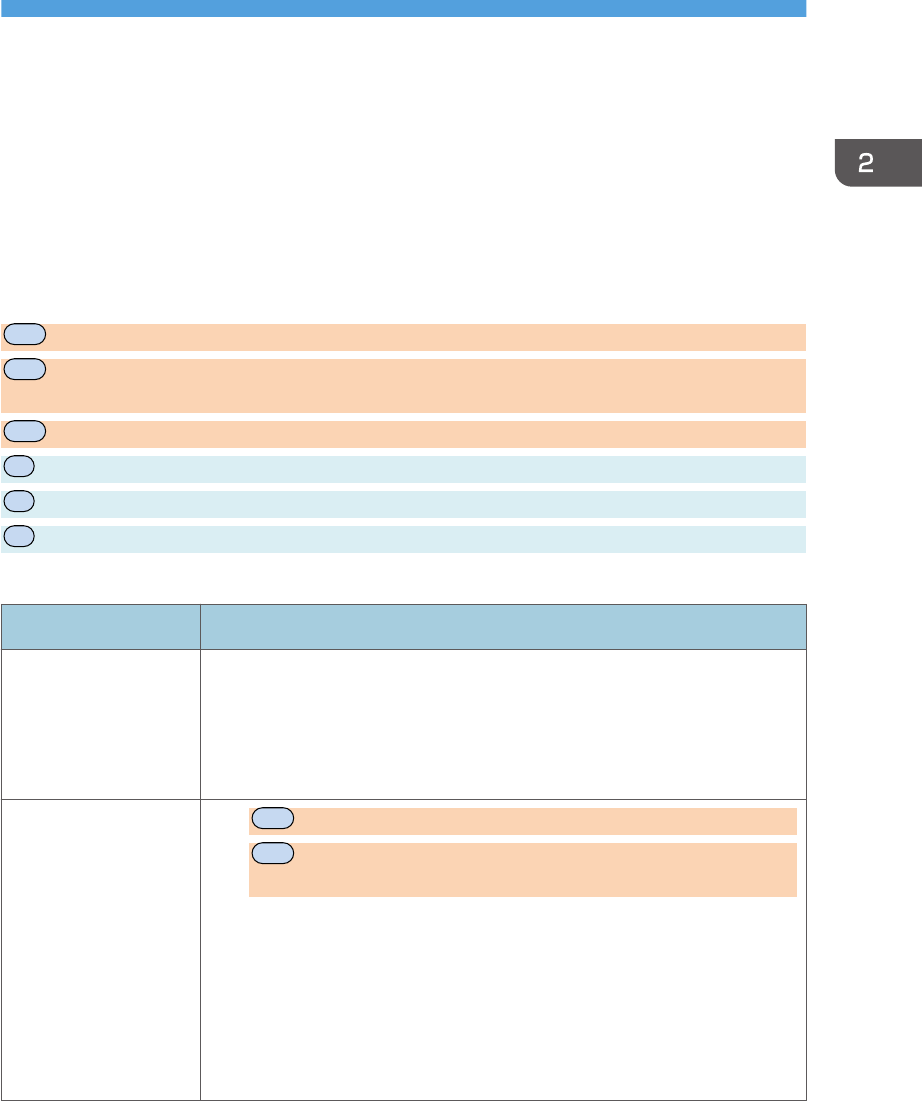
2. Paper Specifications and Adding
Paper
This chapter describes how to load paper and originals, and about their specifications.
Workflow for Loading Paper and Configuring
Paper Sizes and Types
This section explains how to load paper and the operations required after loading paper.
After doing the following procedures, you can copy or print on the paper that is loaded in the machine.
MF
1 Load paper into the paper tray.
MF
2 Specify the paper type and size using the control panel, Web Image Monitor, or Smart
Organizing Monitor.
MF
3 Specify the paper type and size on the printer driver.
P
1 Load paper into the paper tray.
P
2 Specify the paper type and size using Web Image Monitor or Smart Organizing Monitor.
P
3 Specify the paper type and size on the printer driver.
For details about the procedures, refer to the next page.
Procedure Reference
1
• When loading paper into Tray 1
See page 41 "Loading Paper into Tray 1".
• When loading paper into the bypass tray
See page 46 "Loading Paper into the Bypass Tray".
2
•
MF
When using the control panel
MF
See page 49 "Specifying Paper Type and Paper Size Using
the Control Panel".
• When using Web Image Monitor
See page 53 "Specifying Paper Type and Paper Size Using Web
Image Monitor".
• When using Smart Organizing Monitor
See page 52 "Specifying Paper Type and Paper Size Using Smart
Organizing Monitor".
opal-p3_mf3_com_user_guide_gb_00228425_eng.xml 39
Draft 2016/05/27

Procedure Reference
3See page 54 "Specifying Paper Type and Paper Size Using the Printer
Driver".
For details about supported paper, see page 55 "Supported Paper".
2. Paper Specifications and Adding Paper
40 opal-p3_mf3_com_user_guide_gb_00228425_eng.xml
Draft 2016/05/27
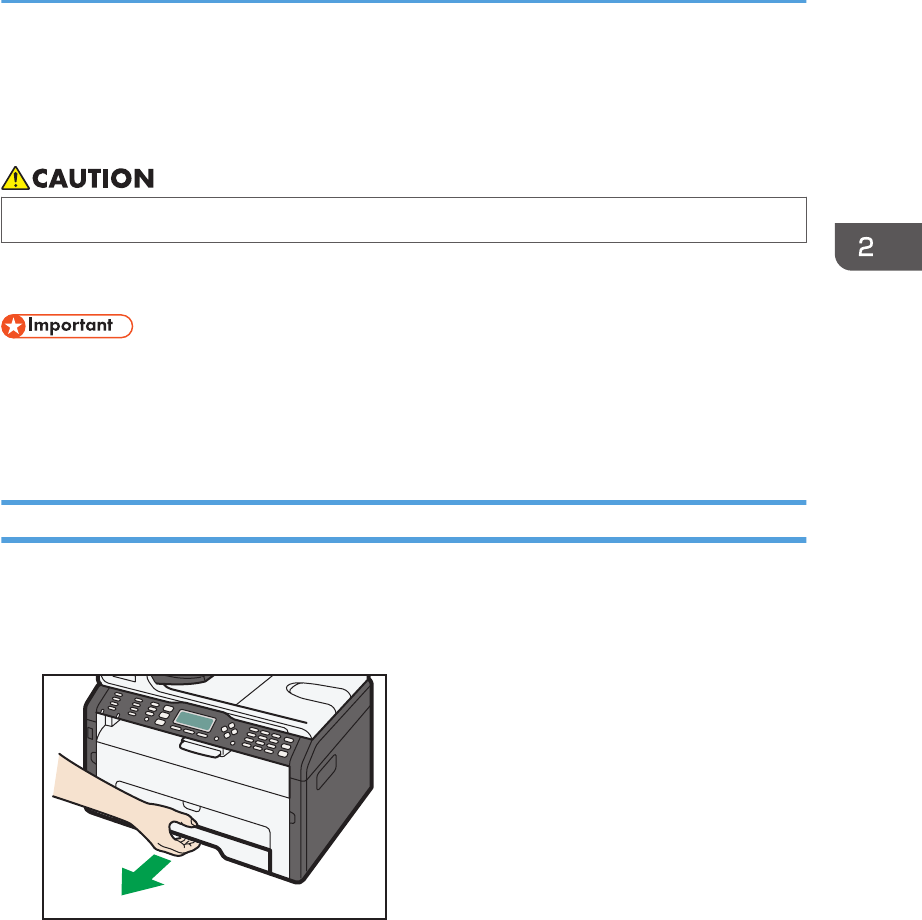
Loading Paper
This sections explains how to load paper into the paper tray and bypass tray.
• When loading paper, take care not to trap or injure your fingers.
For information about supported paper, precautions for storing paper, and print areas, see page 55
"Supported Paper".
• When loading paper, be sure to configure the paper size and paper type for the bypass tray and
Tray 1. When printing a document, specify the paper size and paper type and select the paper
tray in the printer driver so that the settings configured when paper is loaded can be used for
printing.
Loading Paper into Tray 1
To load paper longer than A4 (297 mm), extend this tray. For details, see page 44 "Extending Tray 1
to load paper".
1. Pull Tray 1 out slowly, and then remove it using both hands.
DCT063
Place the tray on a flat surface.
Loading Paper
opal-p3_mf3_com_user_guide_gb_00228426_eng.xml 41
Draft 2016/05/27
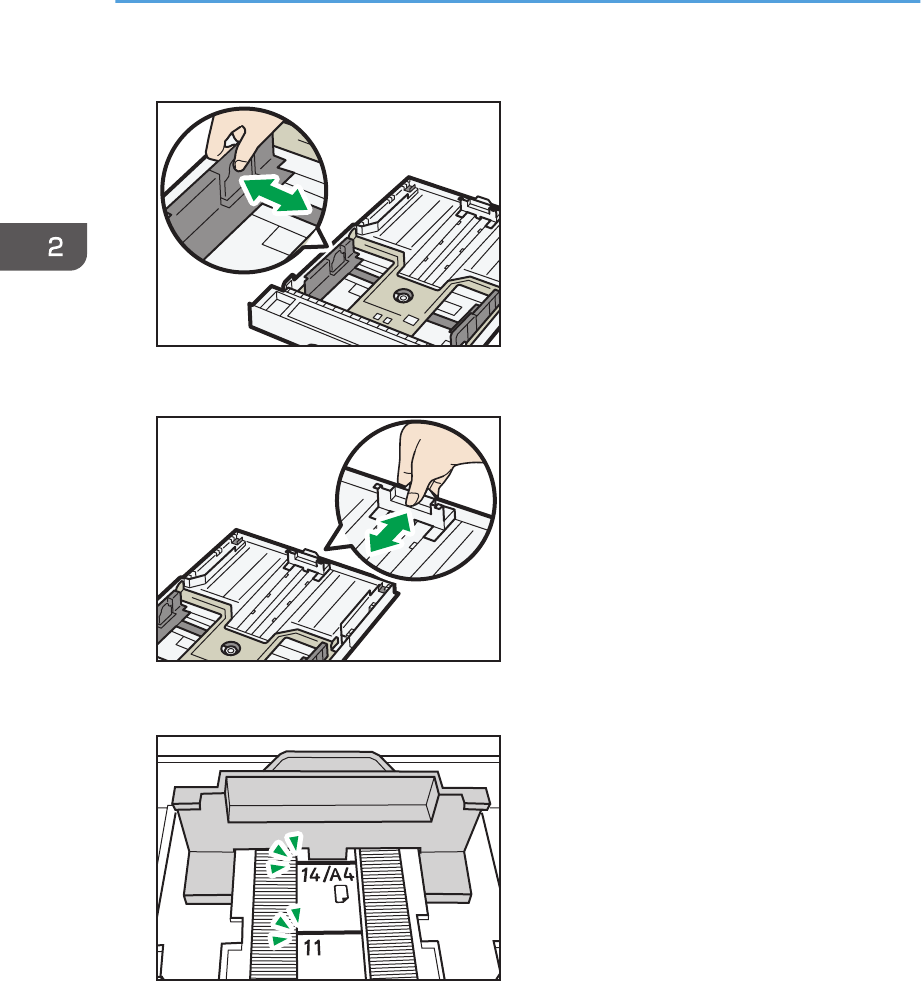
2. Pinch the clips on the side paper guides and slide them to match the standard size.
DCT030
3. Pinch the end paper guide and slide it inward to match the standard size.
DCT031
When loading A5 SEF, A4 or letter size paper, align the paper guide to the following position:
DCT871
4. Fan the paper before loading it in the tray.
5. Load the new paper stack print side down.
Make sure paper is not stacked higher than the upper limit marked inside the tray.
2. Paper Specifications and Adding Paper
42 opal-p3_mf3_com_user_guide_gb_00228426_eng.xml
Draft 2016/05/27
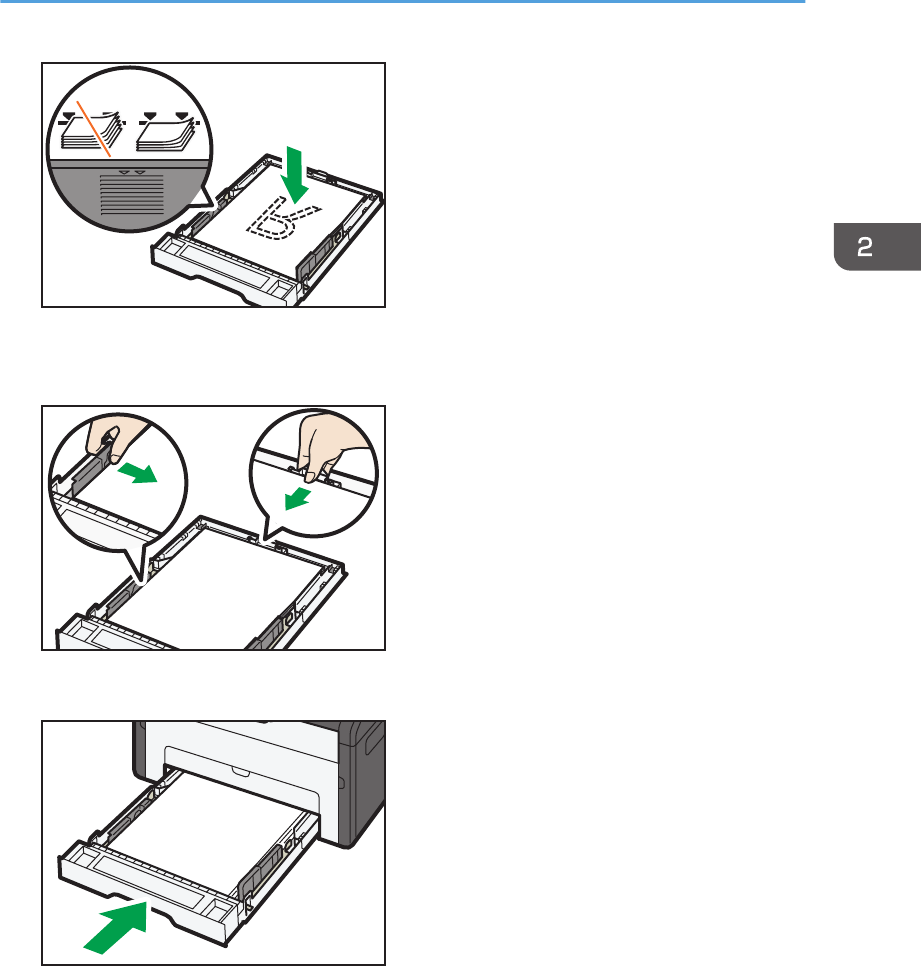
DCT032
6. Check there are no gaps between the paper and the paper guides (both side and end
paper guides).
DCT049
7. Carefully push Tray 1 straight into the machine.
DCT011
To avoid paper jams, make sure the tray is securely inserted.
To deliver the sheets face up, open the rear cover.
Loading Paper
opal-p3_mf3_com_user_guide_gb_00228426_eng.xml 43
Draft 2016/05/27
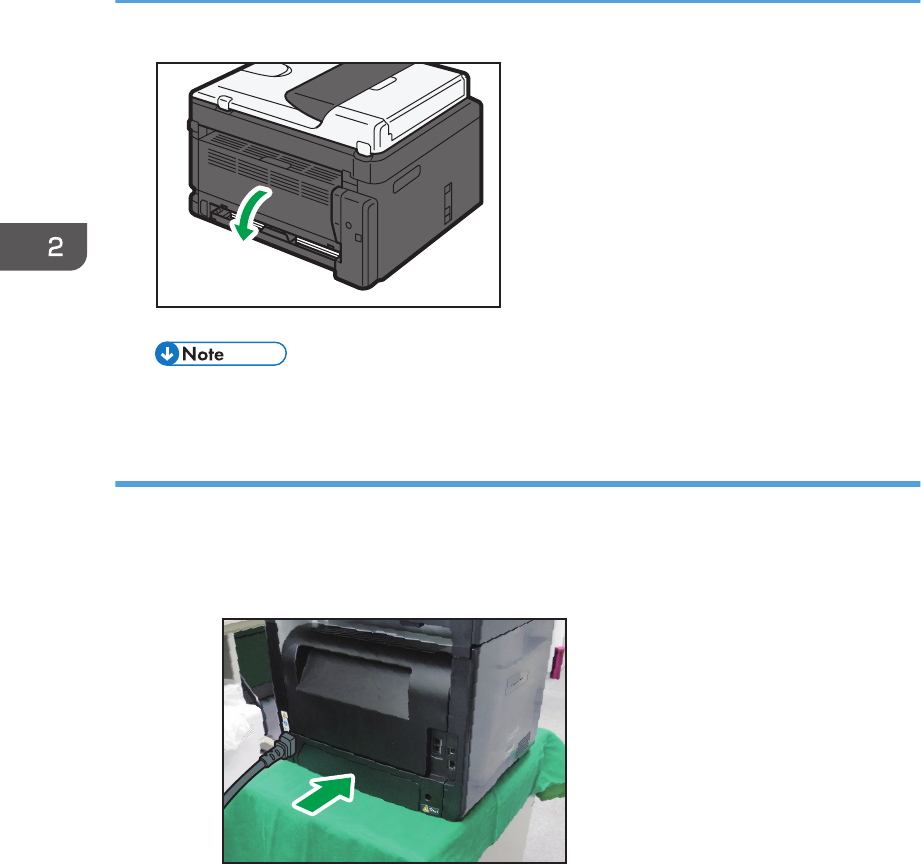
DCT037
• Sheets can be delivered face down from the output tray without opening the rear cover.
Extending Tray 1 to load paper
This section explains how to load paper longer than A4 (297 mm) into the machine.
1. Remove the tray cover by pushing its center.
DSG116
2. Pull Tray 1 out slowly, and then remove it using both hands.
2. Paper Specifications and Adding Paper
44 opal-p3_mf3_com_user_guide_gb_00228426_eng.xml
Draft 2016/05/27
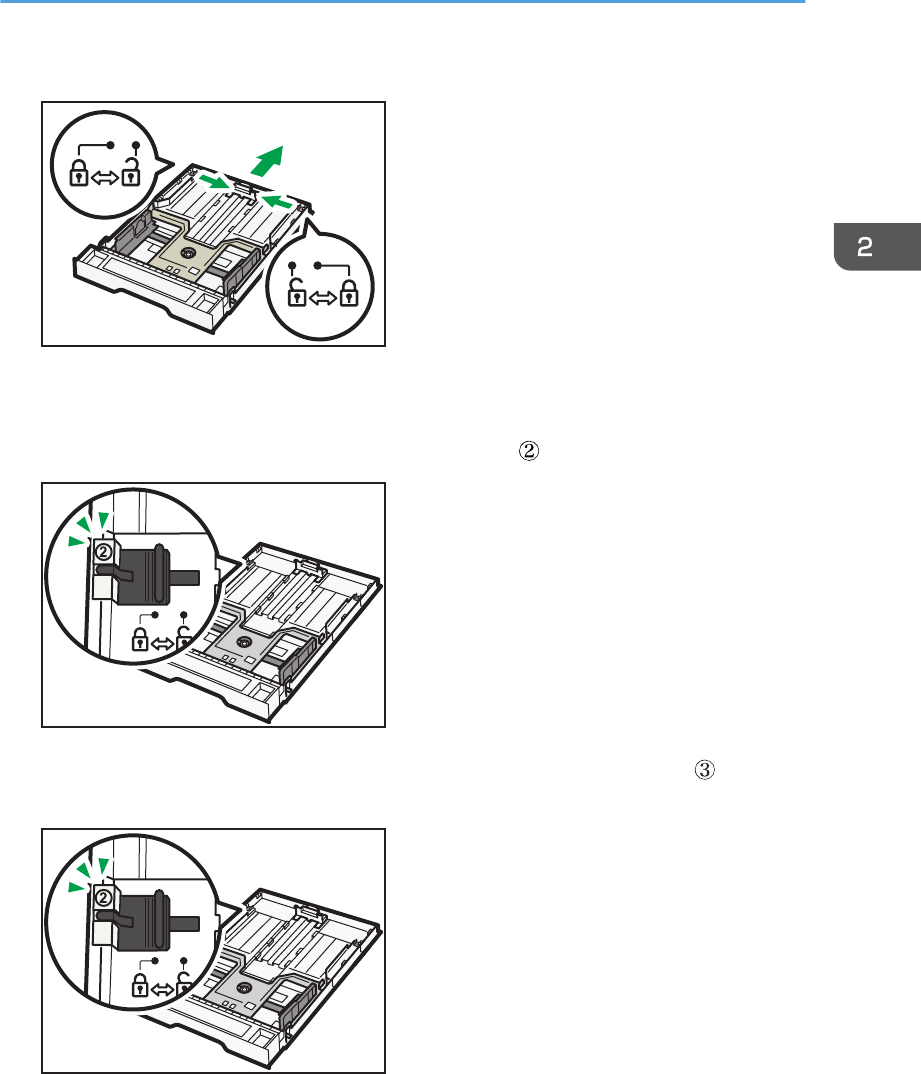
3. Release the extender locks on both sides of the tray, and then pull out the extender.
DCT034
Make sure the extender's inner surface and the scale are aligned.
You can adjust the length of the extender in three steps. When using A5 SEF, A4 or letter size
paper, adjust the length to the position indicated by the mark " " in the tray.
DCT042
When using legal size paper, adjust the length to the position indicated by the mark " " in the
tray.
DCT042
Loading Paper
opal-p3_mf3_com_user_guide_gb_00228426_eng.xml 45
Draft 2016/05/27
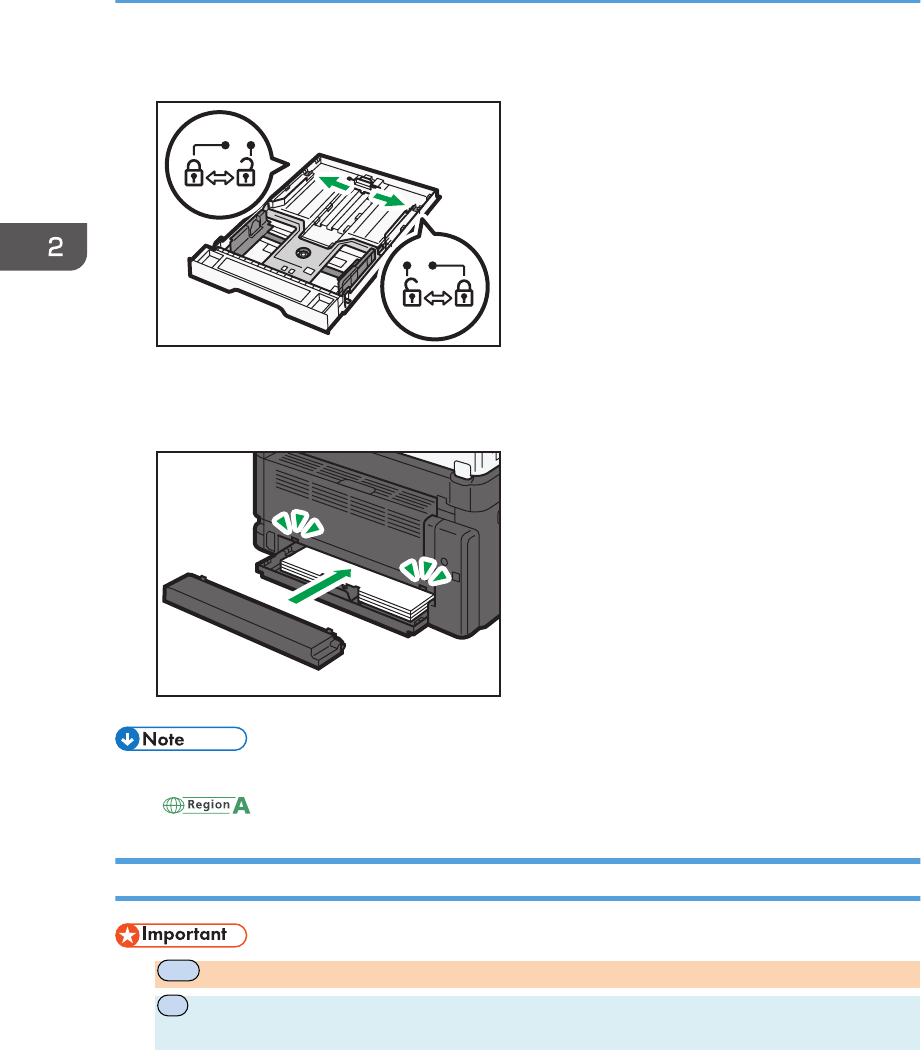
4. Pull out the extender and lock it.
DCT033
5. Follow Steps 2 to 7 in "Loading Paper into Tray 1".
6. Attach the tray cover.
DCT038
• Legal paper or custom-size paper longer than A4 must be loaded without attaching the tray cover.
( only)
Loading Paper into the Bypass Tray
•
MF
Do not load paper in the bypass tray unless the message "Ready" is displayed.
•
P
Do not load paper in the bypass tray unless the message "Ready" appears in Smart
Organizing Monitor.
2. Paper Specifications and Adding Paper
46 opal-p3_mf3_com_user_guide_gb_00228426_eng.xml
Draft 2016/05/27
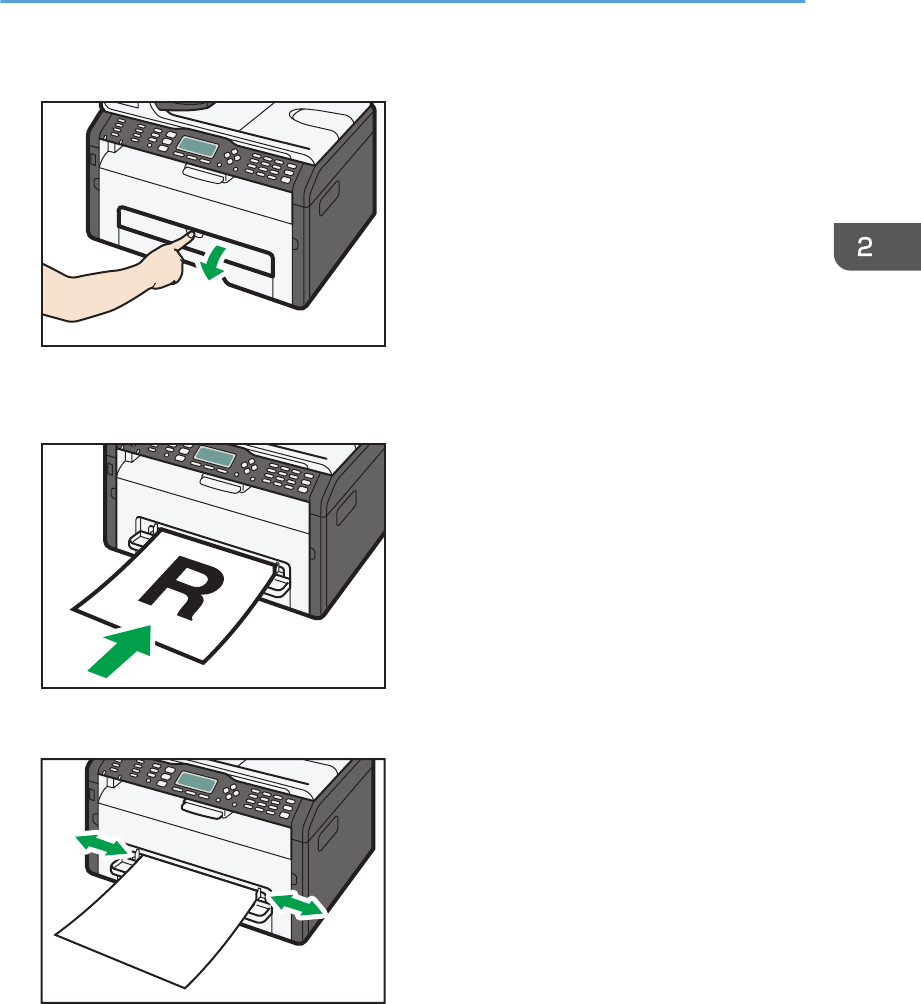
1. Open the bypass tray.
DCT029
2. Slide the side guides outward, load paper with the print side up, and then push in until it
stops against the machine.
DCT013
3. Adjust the side guides to the paper width.
DCT014
To deliver the sheets face up, open the rear cover.
Loading Paper
opal-p3_mf3_com_user_guide_gb_00228426_eng.xml 47
Draft 2016/05/27
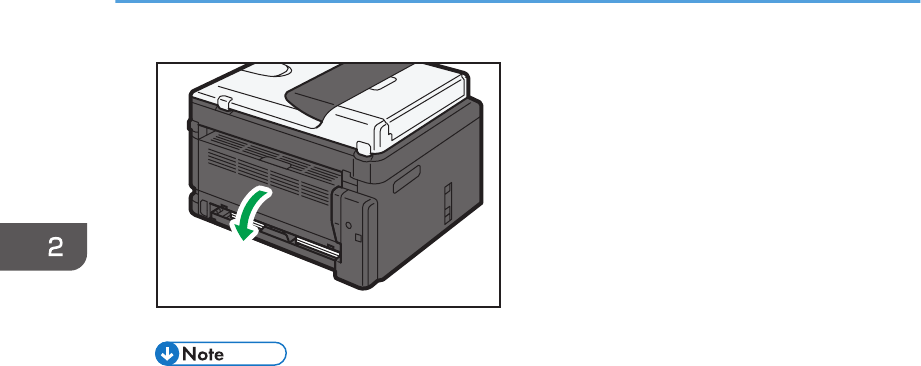
DCT037
• Sheets can be delivered face down from the output tray without opening the rear cover.
2. Paper Specifications and Adding Paper
48 opal-p3_mf3_com_user_guide_gb_00228426_eng.xml
Draft 2016/05/27

MF
Specifying Paper Type and Paper Size Using
the Control Panel
This section describes how to specify the paper size and paper type using the control panel.
• Paper type and size can also be specified using the printer driver. For details, see the printer driver
Help.
• For prints from the bypass tray, you can select to print according to either the printer driver settings
or the control panel settings with [Bypass Tray Priority] under [Tray Paper Settings]. For details
about [Bypass Tray Priority], see page 187 "Tray Paper Settings".
• If [Auto Continue] under [System Settings] is enabled, printing stops temporarily if a paper type/
size error is detected. The printing restarts automatically with the settings made with the control
panel after about ten seconds. For details about [Auto Continue], see page 182 "System Settings".
Specifying the Paper Type
This section describes how to specify the paper type.
1. Press the [User Tools] key.
DSH142
2. Press the [ ] or [ ] key to select [Tray Paper Settings], and then press the [OK] key.
3. Press the [ ] or [ ] key to select the paper type setting for the desired tray, and then
press the [OK] key.
4. Press the [ ] or [ ] key to select the desired paper type, and then press the [OK] key.
5. Press the [User Tools] key to return to the initial screen.
• You can press the [Back] key to exit to the previous level of the menu tree.
Specifying Paper Type and Paper Size Using the Control Panel
opal-p3_mf3_com_user_guide_gb_00228427_eng.xml 49
Draft 2016/05/27
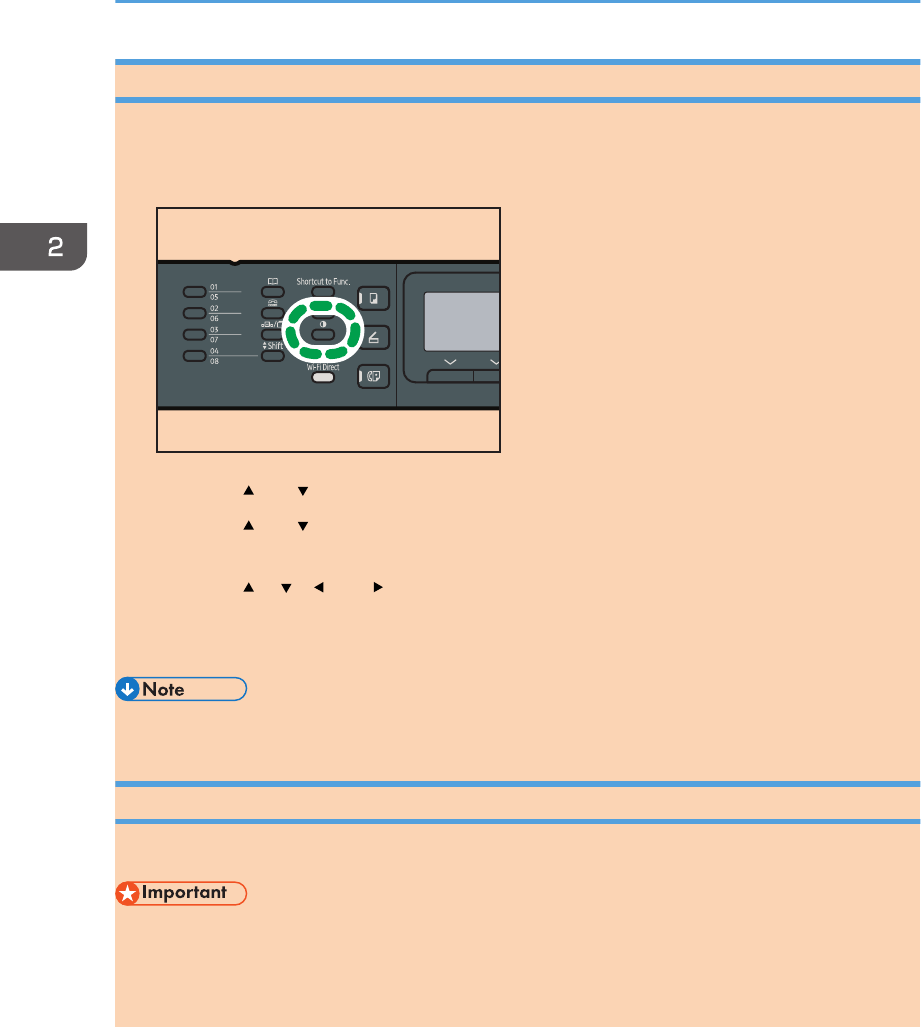
Specifying the Standard Paper Size
This section describes how to specify the standard paper size.
1. Press the [User Tools] key.
DSH142
2. Press the [ ] or [ ] key to select [Tray Paper Settings], and then press the [OK] key.
3. Press the [ ] or [ ] key to select the paper size setting for the desired tray, and then press
the [OK] key.
4. Press the [ ], [ ],[ ], or [ ] key to select the desired paper size, and then press the [OK]
key.
5. Press the [User Tools] key to return to the initial screen.
• You can press the [Back] key to exit to the previous level of the menu tree.
Specifying a Custom Paper Size
This section describes how to specify a custom paper size.
• When you perform printing, make sure that the paper size specified with the printer driver matches
the paper size specified with the control panel. If a paper size mismatch occurs, a message
appears on the display. To ignore the error and print using mismatched paper, see page 72 "If a
Paper Mismatch Occurs".
2. Paper Specifications and Adding Paper
50 opal-p3_mf3_com_user_guide_gb_00228427_eng.xml
Draft 2016/05/27
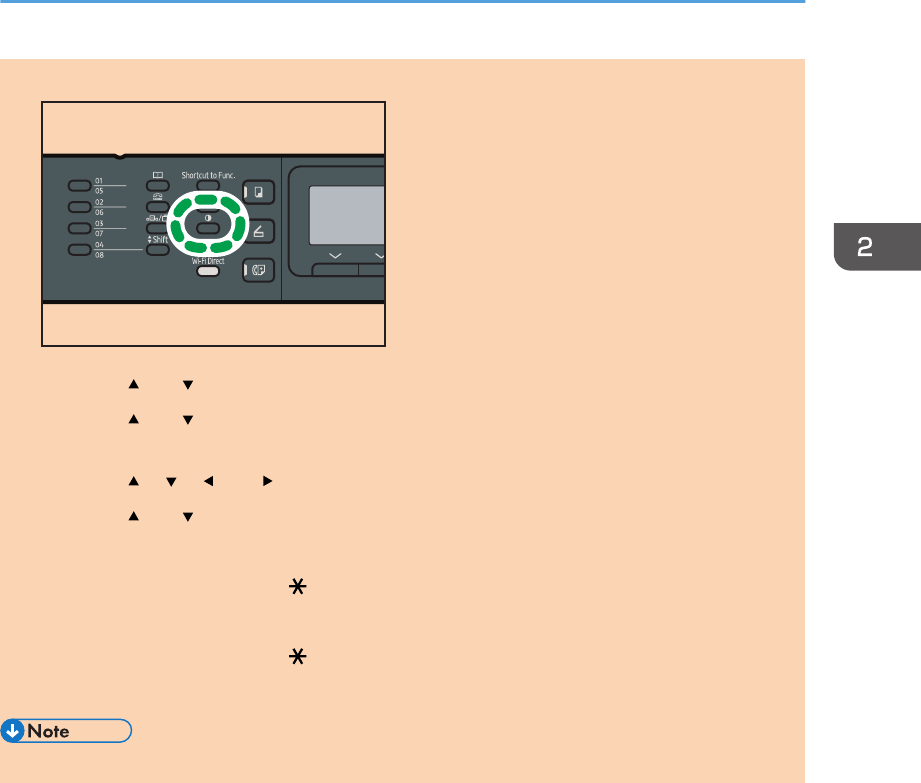
1. Press the [User Tools] key.
DSH142
2. Press the [ ] or [ ] key to select [Tray Paper Settings], and then press the [OK] key.
3. Press the [ ] or [ ] key to select the paper size setting for the desired tray, and then press
the [OK] key.
4. Press the [ ], [ ], [ ], or [ ] key to select [Custom Size], and then press the [OK] key.
5. Press the [ ] or [ ] key to select [mm] or [inch], and then press the [OK] key.
6. Enter the width using number keys, and then press the [OK] key.
To enter a decimal point, press [ ].
7. Enter the length using number keys, and then press the [OK] key.
To enter a decimal point, press [ ].
8. Press the [User Tools] key to return to the initial screen.
• You can press the [Back] key to exit to the previous level of the menu tree.
Specifying Paper Type and Paper Size Using the Control Panel
opal-p3_mf3_com_user_guide_gb_00228427_eng.xml 51
Draft 2016/05/27

Specifying Paper Type and Paper Size Using
Smart Organizing Monitor
The procedure in this section is an example based on Windows 7. The actual procedure may vary
depending on the operating system you are using.
1. On the [Start] menu, click [All Programs].
2. Click [Smart Organizing Monitor].
3. Click [Smart Organizing Monitor Status].
4. If the machine you are using is not selected, click [Connect Printer].
5. Click [Search Network Printer] or input the IP Address of the machine, and then select the
machine's model.
6. Click [OK].
7. On the [User Tools] tab, click [Printer Configuration].
If you are requested to enter an access code, enter the access code and then click [OK].
The default access code is "Admin".
8. Select the paper type and paper size, and then click [OK].
9. Click [Close].
Specifying a Custom Paper Size
1. On the [Start] menu, click [All Programs].
2. Click [Smart Organizing Monitor].
3. Click [Smart Organizing Monitor Status].
4. If the machine you are using is not selected, click [Connect Printer], and then select the
machine's model.
5. Click [OK].
6. On the [User Tools] tab, click [Printer Configuration].
If you are requested to enter an access code, enter the access code and then click [OK].
The default access code is "Admin".
7. On the [Paper Input] tab, select [Custom Paper Size] in the [Paper Size] list.
8. In the [Unit] list, select [mm] or [inch].
9. In the [Horizontal] box and [Vertical] box, specify the width and length.
10. Click [OK].
11. Click [Close].
2. Paper Specifications and Adding Paper
52 opal-p3_mf3_com_user_guide_gb_00228428_eng.xml
Draft 2016/05/27

Specifying Paper Type and Paper Size Using
Web Image Monitor
This section describes how to specify the paper size and paper type using Web Image Monitor.
1. Start the web browser and access the machine by entering its IP address.
2. Click [System Settings].
3. Select the paper type and paper size for the desired tray.
4. Enter the administrator password if required.
5. Click [OK].
6. Close the web browser.
Specifying a Custom Paper Size
1. Start the web browser and access the machine by entering its IP address.
2. Click [System Settings].
3. Select [Custom Size] in the [Paper Size] list.
4. Select [mm] or [inch] and specify the width and length.
5. Enter the administrator password if required.
6. Click [OK].
7. Close the web browser.
Specifying Paper Type and Paper Size Using Web Image Monitor
opal-p3_mf3_com_user_guide_gb_00229282_eng.xml 53
Draft 2016/05/27

Specifying Paper Type and Paper Size Using
the Printer Driver
• Make sure that the paper type and size specified with the printer driver matches the paper type
and size loaded in the tray. Since this machine does not detect the paper size automatically, the
type or size of the paper may be mismatched and the print job may not print correctly.
1. Open the [Printing Preferences] dialog box from the printer driver.
For information of how to open the printer driver properties from [Devices and Printers], see
page 70 "Displaying the Printing Preferences Dialog Box".
2. Click the [Paper] tab.
3. In the [Input Tray] list, select the paper tray you want to print onto.
4. In the [Paper Type] list, select the type of paper that is loaded in the paper tray.
5. In the [Document Size] list, select the paper size that is loaded in the paper tray.
6. Click [OK].
2. Paper Specifications and Adding Paper
54 opal-p3_mf3_com_user_guide_gb_00228429_eng.xml
Draft 2016/05/27
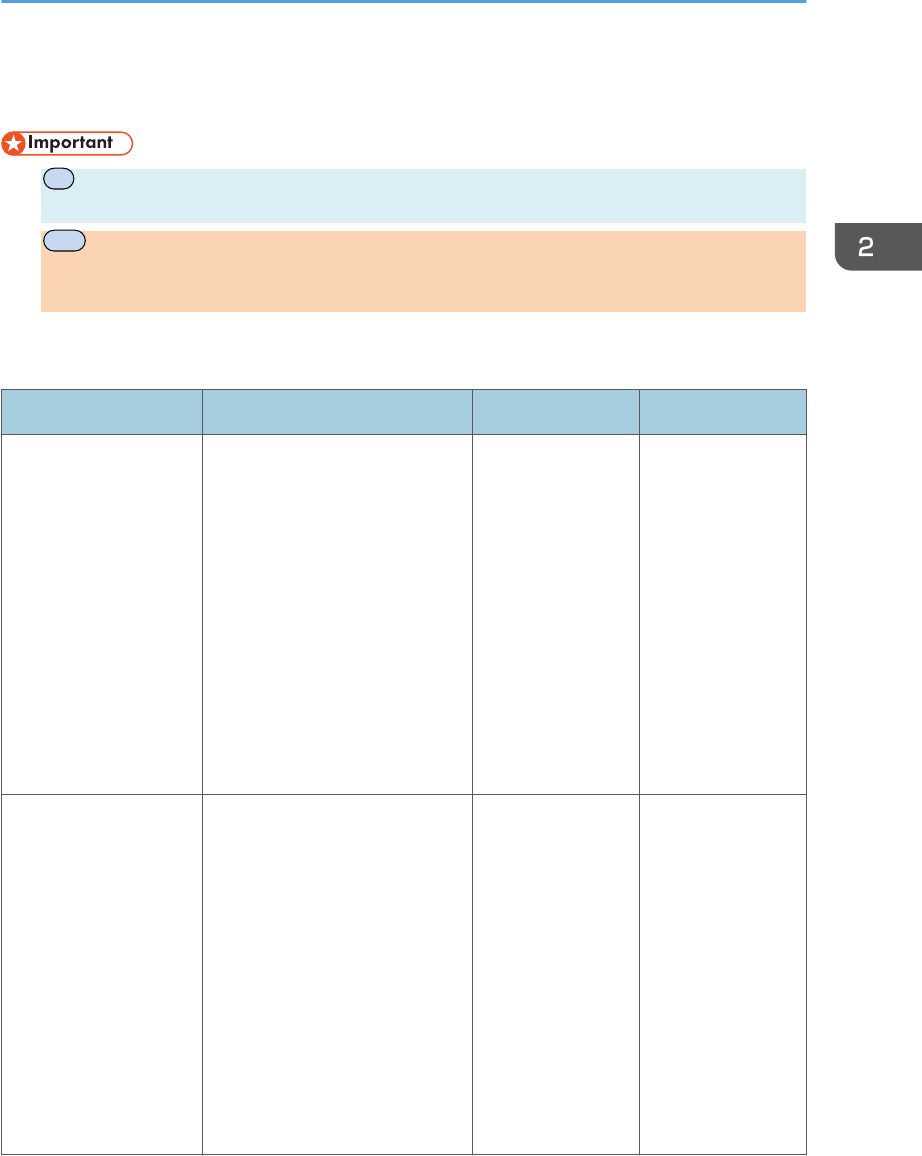
Supported Paper
•
P
After loading paper in the tray, specify the paper type and size using Smart Organizing
Monitor and the printer driver. This machine does not detect the paper size automatically.
•
MF
After loading paper in the tray, specify the paper type and size using the control panel or
using Smart Organizing Monitor and printer driver. This machine does not detect the paper size
automatically.
• When loading custom size paper, specify the width and length using the control panel and the
printer driver.
Type Size Weight Capacity
Plain Paper
Recycled
Thick Paper 1
Thin Paper
Letterhead
Preprinted Paper
Prepunched Paper
Bond Paper
Cardstock
Color Paper
A4, 81/2 × 11, B5 JIS, B6 JIS,
A5 LEF, A5 SEF, A6, 81/2 ×
14, 81/2 × 13, 8.5 × 13.4, 8.5
× 13.6, 16K, 8.11 × 13.3,
51/2 × 81/2
52 to 162 g/m2
(14 to 43 lb.)
• Tray 1
150 sheets
• Bypass tray
1 sheet
(80 g/m2, 20 lb.)
Plain Paper
Recycled
Thick Paper 1
Thin Paper
Letterhead
Preprinted Paper
Prepunched Paper
Bond Paper
Cardstock
Color Paper
Custom size:
100 to 216 mm in width,
148 to 356 mm in length
(3.94 to 8.50 inches in width,
5.83 to 14.02 inches in length)
52 to 162 g/m2
(14 to 43 lb.)
• Tray 1
150 sheets
• Bypass tray
1 sheet
(80 g/m2, 20 lb.)
Supported Paper
opal-p3_mf3_com_user_guide_gb_00228430_eng.xml 55
Draft 2016/05/27
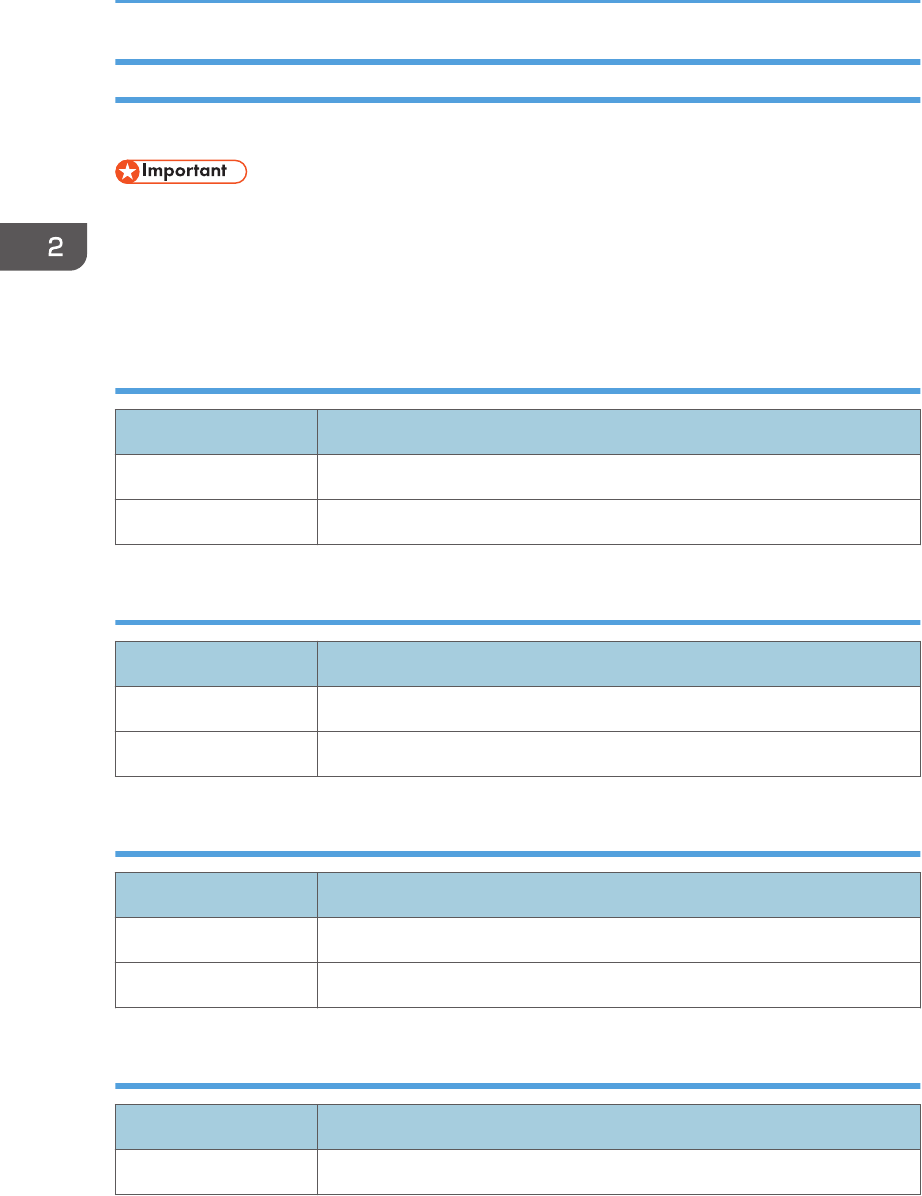
Specifications of Paper Types
The following tables describe the types of paper that can be used with this machine.
• Depending on the paper type, the toner may take a while to dry. Before handling printed sheets,
make sure that they have fully dried. Otherwise, the toner may smudge.
• Print quality can be guaranteed only if recommended paper is used. For more information about
the recommended paper, contact your sales or service representative.
Plain Paper
Item Description
Paper thickness 65 to 99 g/m2 (17 to 27 lb.)
Supported paper tray Tray 1 and bypass tray
Thick Paper 1
Item Description
Paper thickness 100 to 130 g/m2 (27 to 35 lb.)
Supported paper tray Tray 1 and bypass tray
Thin Paper
Item Description
Paper thickness 52 to 64 g/m2 (14 to 16 lb.)
Supported paper tray Tray 1 and bypass tray
Recycled Paper
Item Description
Paper thickness 75 to 90 g/m2 (20 to 24 lb.)
2. Paper Specifications and Adding Paper
56 opal-p3_mf3_com_user_guide_gb_00228430_eng.xml
Draft 2016/05/27

Item Description
Supported paper tray Tray 1 and bypass tray
Notes If the paper thickness is outside the specified range, select [Thin Paper],
[Plain Paper 1], [Thick Paper 1], or [Thick Paper 2].
Color Paper
Item Description
Paper thickness 75 to 90 g/m2 (20 to 24 lb.)
Supported paper tray Tray 1 and bypass tray
Notes If the paper thickness is outside the specified range, select [Thin Paper],
[Plain Paper 1], [Thick Paper 1], or [Thick Paper 2].
Preprinted Paper
Item Description
Paper thickness 75 to 90 g/m2 (20 to 24 lb.)
Supported paper tray Tray 1 and bypass tray
Notes If the paper thickness is outside the specified range, select [Thin Paper],
[Plain Paper 1], [Thick Paper 1], or [Thick Paper 2].
Prepunched Paper
Item Description
Paper thickness 75 to 90 g/m2 (20 to 24 lb.)
Supported paper tray Tray 1 and bypass tray
Notes If the paper thickness is outside the specified range, select [Thin Paper],
[Plain Paper 1], [Thick Paper 1], or [Thick Paper 2].
Supported Paper
opal-p3_mf3_com_user_guide_gb_00228430_eng.xml 57
Draft 2016/05/27
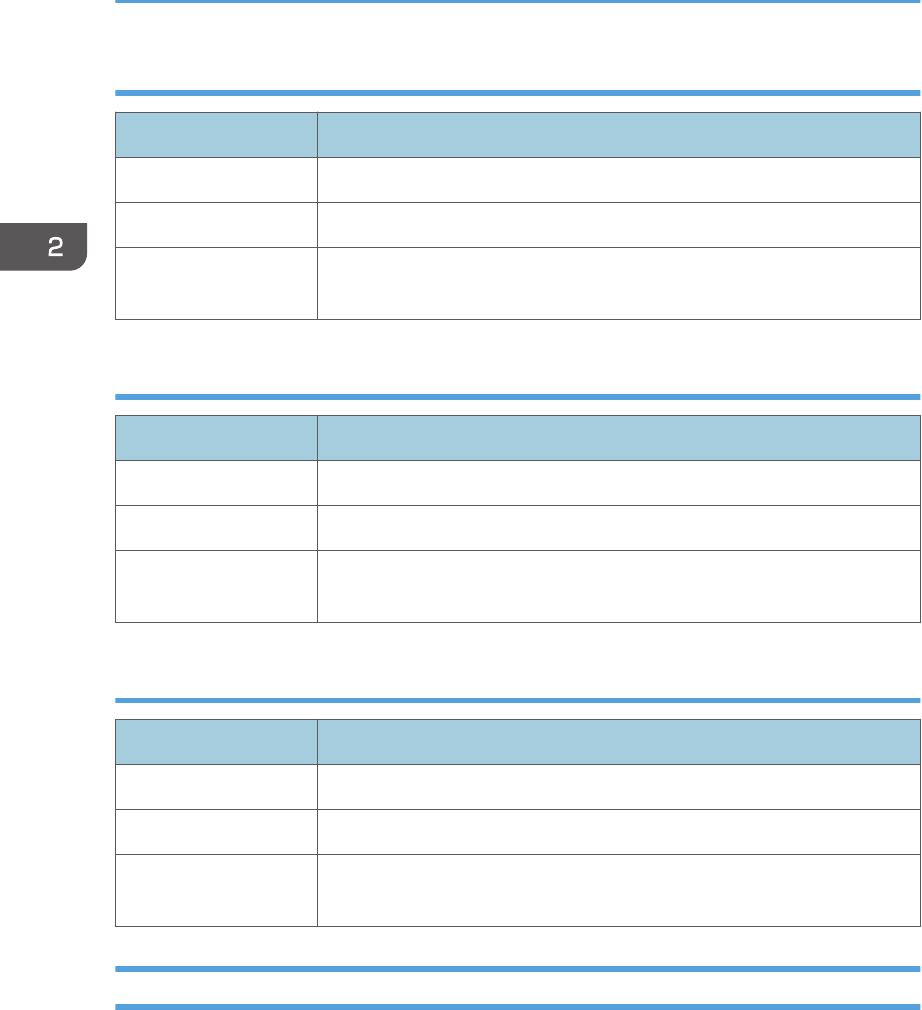
Letterhead
Item Description
Paper thickness 100 to 130 g/m2 (27 to 35 lb.)
Supported paper tray Tray 1 and bypass tray
Notes Paper that has a thickness outside the specified range cannot be printed
onto.
Bond Paper
Item Description
Paper thickness 105 to 160 g/m2 (28 to 43 lb.)
Supported paper tray Tray 1 and bypass tray
Notes If the paper thickness is outside the specified range, select [Thin Paper],
[Plain Paper 1], [Thick Paper 1], or [Thick Paper 2].
Cardstock
Item Description
Paper thickness 100 to 130 g/m2 (27 to 35 lb.)
Supported paper tray Tray 1 and bypass tray
Notes If the paper thickness is outside the specified range, select [Thin Paper],
[Plain Paper 1], [Thick Paper 1], or [Thick Paper 2].
Non-Recommended Paper Types
Do not use the following types of paper:
• Ink-jet printer paper
• Bent, folded, or creased paper
• Curled or twisted paper
• Torn paper
• Wrinkled paper
2. Paper Specifications and Adding Paper
58 opal-p3_mf3_com_user_guide_gb_00228430_eng.xml
Draft 2016/05/27
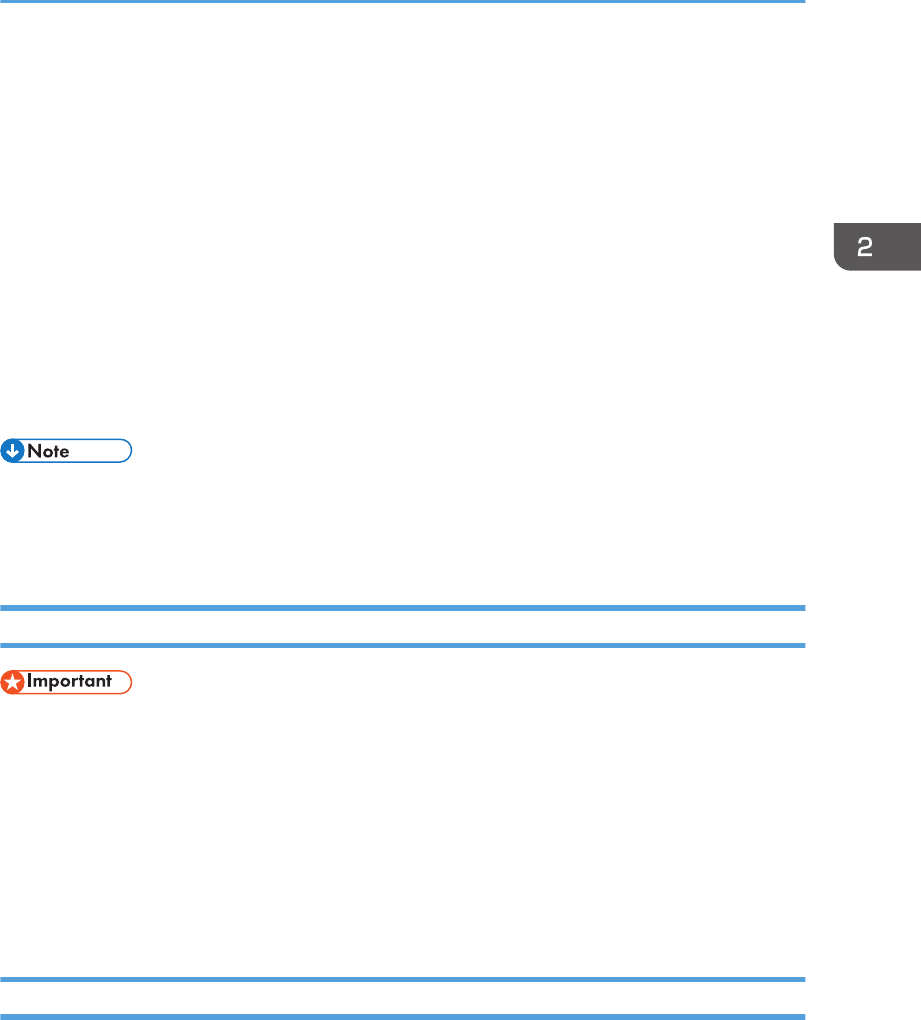
• Damp paper
• Dirty or damaged paper
• Paper that is dry enough to emit static electricity
• Paper that has already been printed onto, except a preprinted letterhead paper.
Malfunctions are especially likely when using paper printed on by other than a laser printer
(e.g.monochrome and color copiers, ink-jet printers, etc.)
• Special paper, such as thermal paper and carbon paper
• Paper weighing heavier or lighter than the limit
• Paper with windows, holes, perforations, cutouts, or embossing
• Adhesive label paper on which glue or base paper is exposed
• Paper with clips or staples
• When loading paper, take care not to touch the surface of the paper.
• Even if paper is adequate for the machine, poorly stored paper can cause paper misfeeds, print
quality degradation, or malfunctions.
Paper Storage
• Store paper appropriately. If the paper is stored incorrectly, misfeeds, lower printing quality, or
malfunctions may result.
When storing paper:
• Do not store paper in a humid place.
• Do not store paper in direct sunlight.
• Do not stand paper on its edge.
• Store any leftover paper in a wrapping or box supplied with the paper.
Print Area
The diagram below shows the area of the paper that the machine can print on.
Supported Paper
opal-p3_mf3_com_user_guide_gb_00228430_eng.xml 59
Draft 2016/05/27
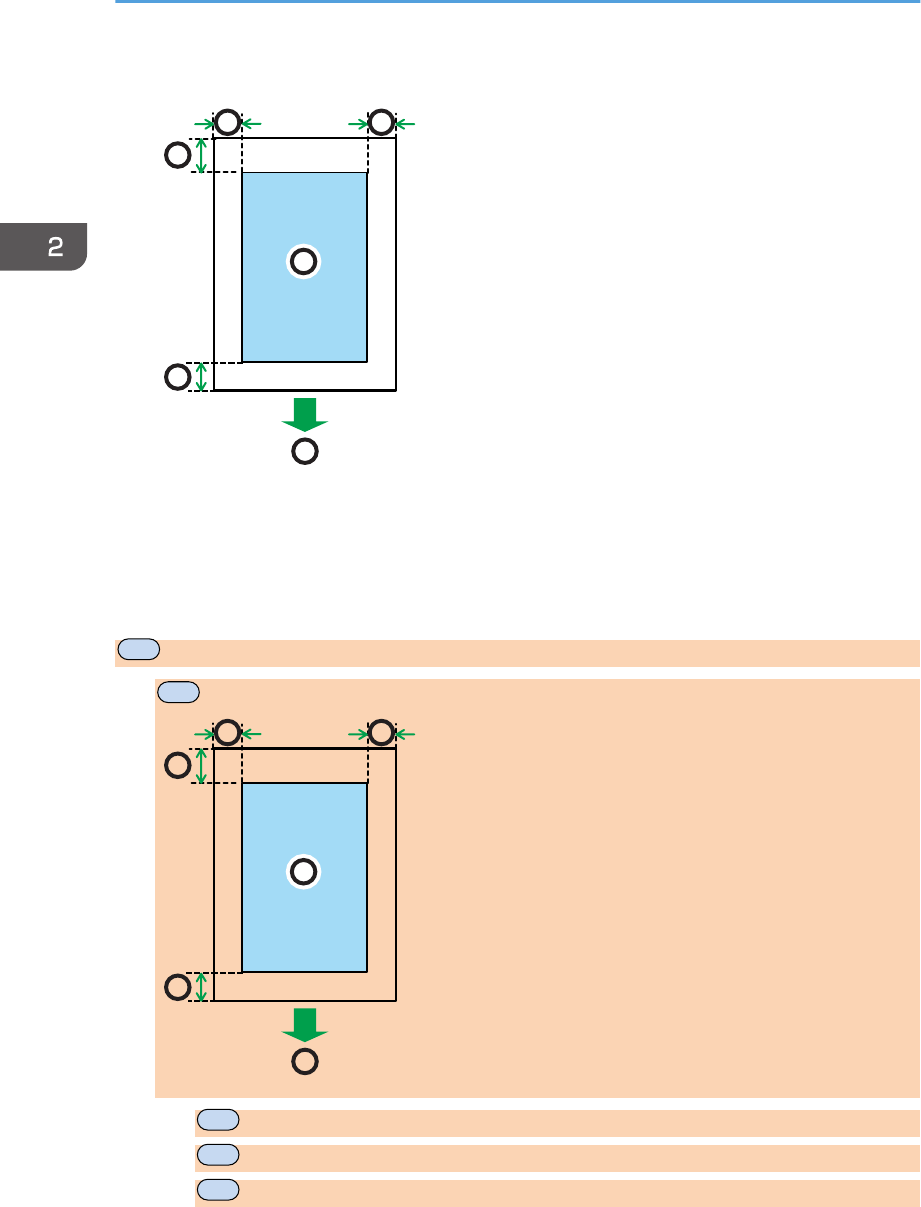
From the printer driver
CHZ904
2
3
3
1
44
1. Print area
2. Feed direction
3. Approx. 4.2 mm (0.2 inches)
4. Approx. 4.2 mm (0.2 inches)
MF
Copier function
MF
CHZ904
2
3
3
1
44
1.
MF
Print area
2.
MF
Feed direction
3.
MF
Approx. 4.0 mm (0.2 inches)
2. Paper Specifications and Adding Paper
60 opal-p3_mf3_com_user_guide_gb_00228430_eng.xml
Draft 2016/05/27
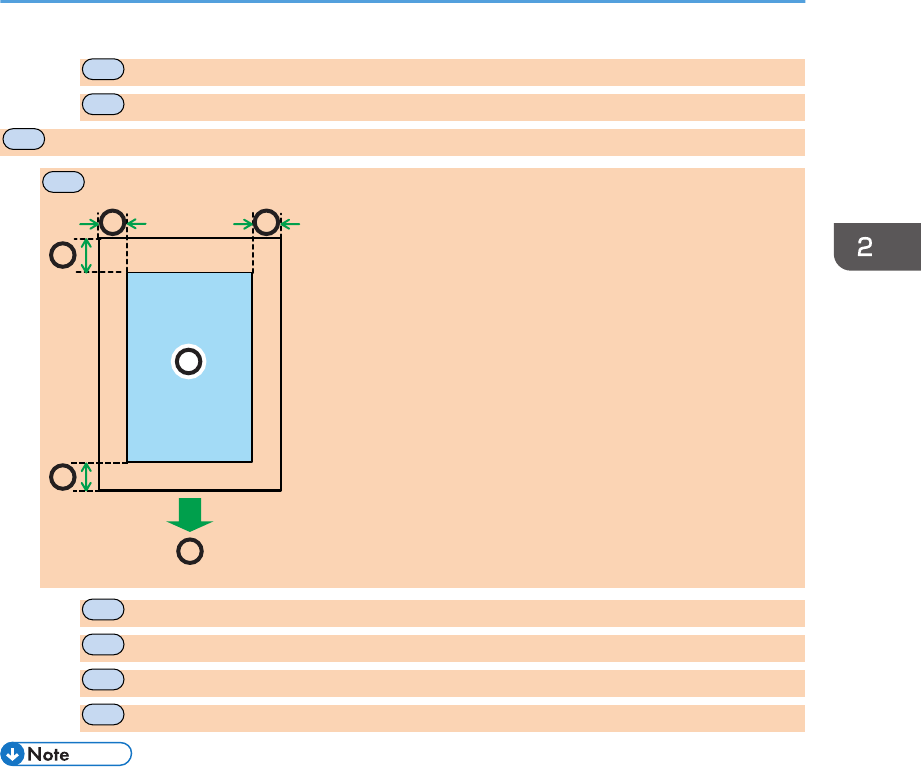
4.
MF
Approx. 3.3 mm (0.1 inches)
5.
MF
Approx. 3.0 mm (0.1 inches)
MF
Fax function
MF
CHZ904
2
3
3
1
44
1.
MF
Print area
2.
MF
Feed direction
3.
MF
Approx. 4.2 mm (0.2 inches)
4.
MF
Approx. 2.0 mm (0.08 inches)
• The print area may vary depending on the paper size, printer language and printer driver settings.
Supported Paper
opal-p3_mf3_com_user_guide_gb_00228430_eng.xml 61
Draft 2016/05/27
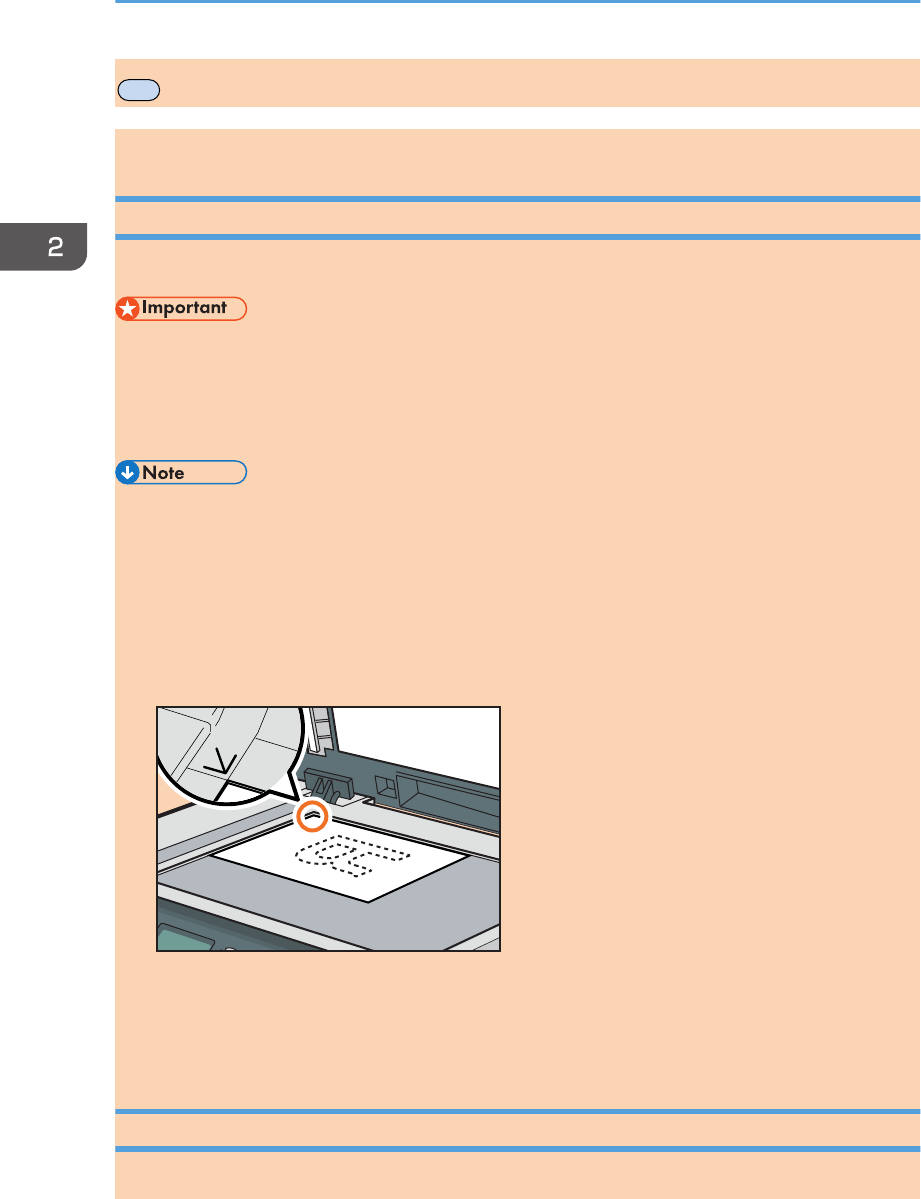
MF
Placing Originals
This section describes the types of originals you can set and how to place them.
Placing Originals on the Exposure Glass
This section describes the procedure for placing originals on the exposure glass and in the ADF.
• Do not place originals before any correction fluid and toner has completely dried. Doing so may
make marks on the exposure glass that will appear on copies.
• The original in the ADF takes precedence over the original on the exposure glass if you place
originals both in the ADF and on the exposure glass.
• Because colors made by marker or highlighter pen on originals are difficult to reproduce, they
might not appear on copies.
1. Lift the ADF.
Be careful not to hold the input tray when lifting the ADF, for the tray might be damaged.
2. Place the original face down on the exposure glass. The original should be aligned to the
rear left corner.
CMF048
3. Lower the ADF.
Hold down the ADF with your hands when using thick, folded, or bound originals and the ADF
cannot be lowered completely.
Placing Originals in the Auto Document Feeder
By using the ADF, you can scan multiple pages at once.
2. Paper Specifications and Adding Paper
62 opal-p3_mf3_com_user_guide_gb_00228431_eng.xml
Draft 2016/05/27
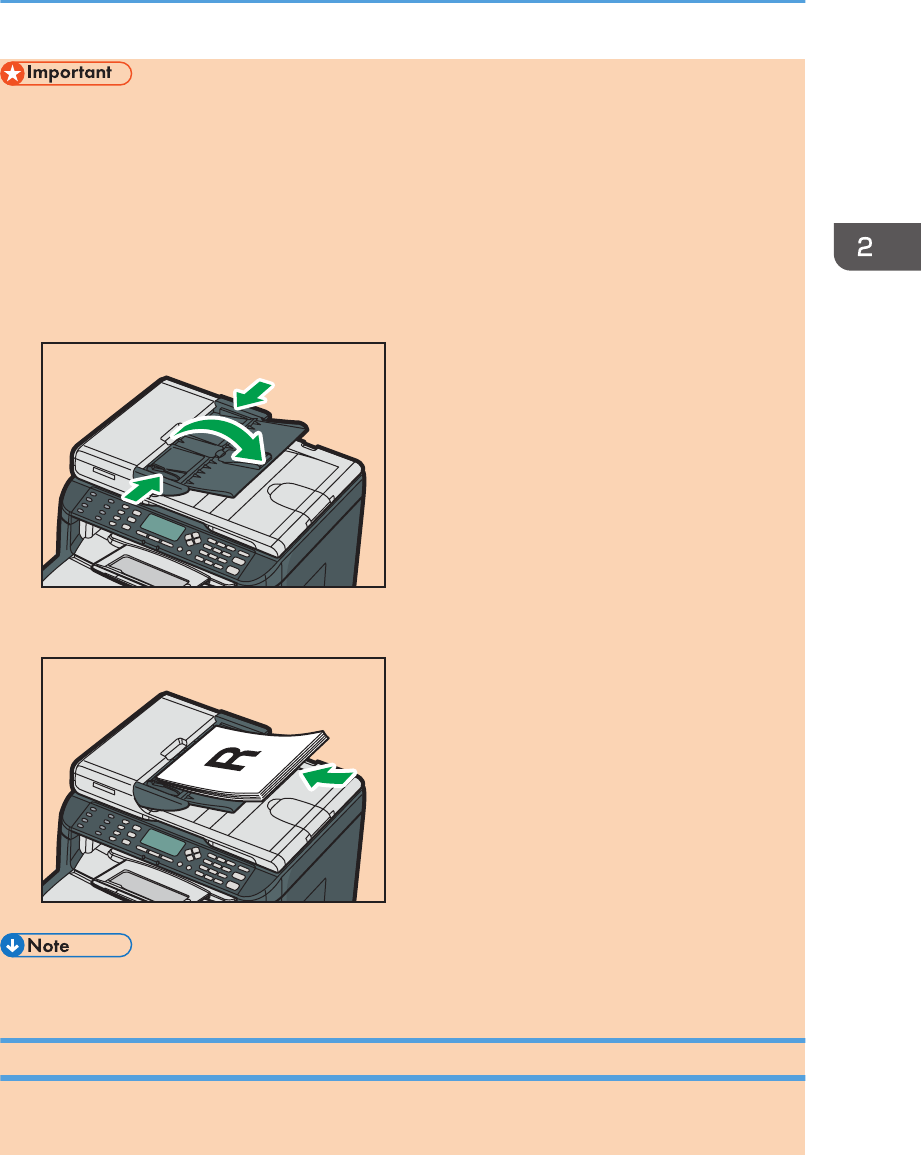
• Do not place different size originals in the ADF at once.
• Straighten curls in the originals before placing them in the ADF.
• To prevent multiple sheets from being fed at once, fan the pages of your original before placing
them in the ADF.
• Place the original squarely.
1. Open the cover of the input tray for the ADF and adjust the guides according to the size of
the original.
DPH050
2. Place the aligned originals face up in the ADF. The last page should be on the bottom.
DPH051
• When placing originals longer than A4, pull out the ADF tray's extenders.
About Originals
This section describes the types of originals that can be placed and the parts of the original that are
unscannable.
Placing Originals
opal-p3_mf3_com_user_guide_gb_00228431_eng.xml 63
Draft 2016/05/27
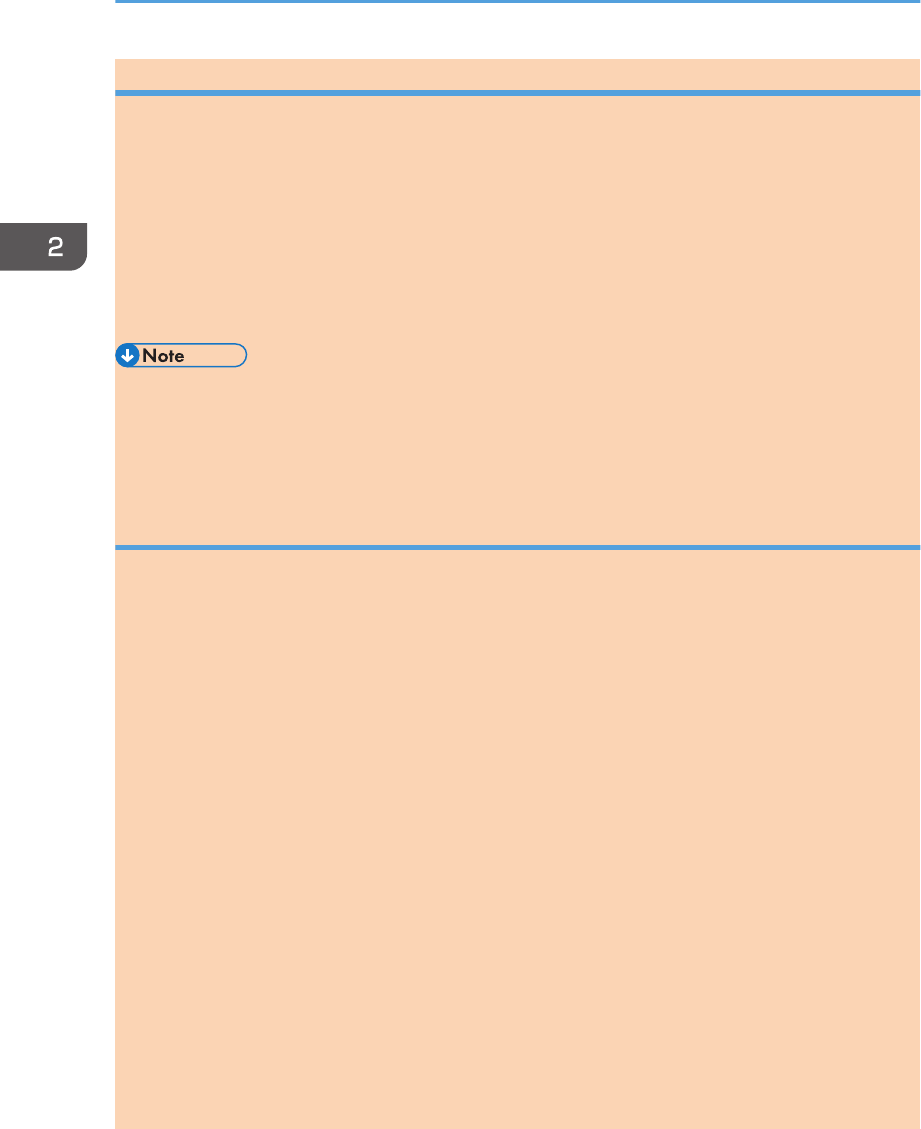
Recommended size of originals
This section describes the recommended size of the original.
Exposure glass
Up to 216 mm (8.5 inches) in width, up to 297 mm (11.7 inches) in length
ADF
• Paper size: 140 to 216 mm (51/2 to 81/2 inches) in width, 140 to 356 mm (51/2 to 14
inches) in length
• Paper weight: 52 to 105 g/m2 (14 to 28 lb.)
• Only 1 sheet of an original can be placed on the exposure glass at a time.
• In the ADF, up to 35 sheets of originals can be placed at once (when using paper weighing 80
g/m2, 20 lb.).
Types of originals not supported by the Auto Document Feeder
If placed in the ADF, the following types of original might be damaged or become jammed, or result in
gray or black lines appearing on prints:
• Originals larger or heavier than recommended
• Stapled or clipped originals
• Perforated or torn originals
• Curled, folded, or creased originals
• Pasted originals
• Originals with any kind of coating, such as thermal fax paper, art paper, aluminum foil, carbon
paper, or conductive paper
• Originals with perforated lines
• Originals with indexes, tags, or other projecting parts
• Sticky originals such as translucent paper
• Thin, highly flexible originals
• Thick originals such as postcards
• Bound originals such as books
• Transparent originals such as OHP transparencies or translucent paper
• Originals that are wet with toner or white out
2. Paper Specifications and Adding Paper
64 opal-p3_mf3_com_user_guide_gb_00228431_eng.xml
Draft 2016/05/27
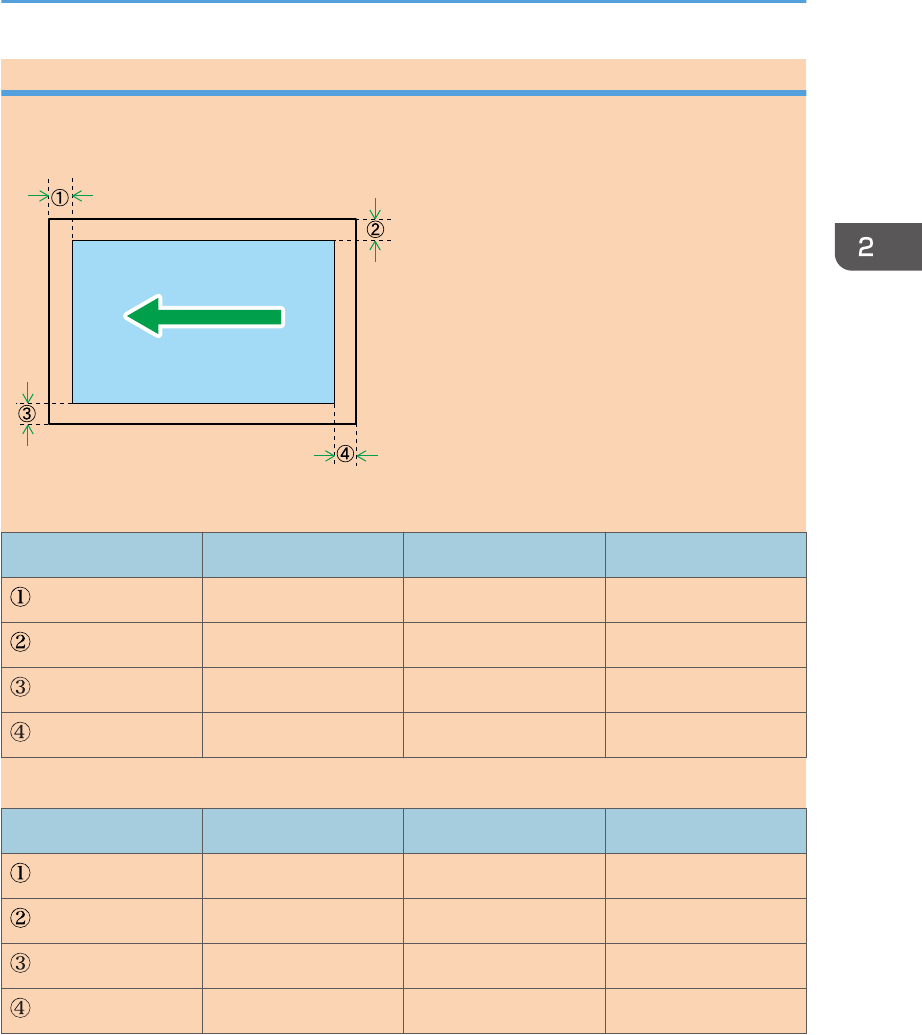
Unscannable image area
Even if you correctly place originals in the ADF or on the exposure glass, margins of a few millimeters on
all four sides of the original might not be scanned.
CES107
Margins when using exposure glass
In copier mode In scanner mode In fax mode
Top 4 mm 0 mm 0 mm
Right 3 mm 0 mm 0 mm
Left 3 mm 0 mm 0 mm
Bottom 3.3 mm 0 mm 0 mm
Margins when using ADF
In copier mode In scanner mode In fax mode
Top 4 mm 0 mm 0 mm
Right 3 mm 0 mm 0 mm
Left 3 mm 0 mm 0 mm
Bottom 3.3 mm 2 mm 0 mm
Placing Originals
opal-p3_mf3_com_user_guide_gb_00228431_eng.xml 65
Draft 2016/05/27

2. Paper Specifications and Adding Paper
66 opal-p3_mf3_com_user_guide_gb_00228431_eng.xml
Draft 2016/05/27

3. Printing Documents
This chapter describes how to configure settings on the printer driver and how to print documents.
What You Can Do with the Printer Function
Combined printing
You can consolidate multiple pages and print them on a single sheet. This saves paper and
documents require less shelf space for storage. For details, see the printer driver Help.
opal-p3_mf3_com_user_guide_gb_00228434_eng.xml 67
Draft 2016/05/27

Configuring Option Settings and Paper Settings
for the Printer
This section explains how to configure settings on the printer driver for the options installed on the
machine and for the paper settings for each tray.
When bidirectional communication works correctly, your computer obtains information about option,
paper size and paper feed direction settings from the machine automatically. Bidirectional
communication also allows you to monitor machine status.
To support bidirectional communication, the following conditions must be met:
Operating system
Windows Vista/7/8/8.1/10, Windows Server 2003/2003
R2/2008/2008R2/2012/2012R2
When connected with the network
• The Standard TCP/IP port must be used.
• In addition to the above, one of the following conditions must also be met:
• The TCP/IP protocol or the IPP protocol is used. (When using the IPP protocol, the IPP
port name must include the IP address.)
When connected with USB
• The machine must be connected to the computer's USB port using the USB interface cable.
• The computer must support bidirectional communication.
• [Enable bidirectional support] must be selected, and [Enable printer pooling] must not be
selected on the [Ports] tab with the printer driver.
When Using Windows
This section describes how to set up option and setting of paper size for each tray on your computer
manually.
The following procedure is explained using Windows 7 as an example.
• Manage Printers permission is required to change the printer properties. Log on as an
Administrators group member.
1. On the [Start] menu, select [Devices and Printers].
2. Right-click the machine's icon, and then click [Printer properties].
3. Click the [Accessories] tab.
4. Select options installed from the [Options] area, and then make the necessary settings.
3. Printing Documents
68 opal-p3_mf3_com_user_guide_gb_00228435_eng.xml
Draft 2016/05/27

5. Click [Paper Size Settings] tab.
6. In [Input Tray:] select which trays to use, and then, in [Paper Size:] select the size of the
paper that you want to load in each tray.
Click [Update] to apply the setting for each tray.
7. Click [Apply].
8. Click [OK] to close the printer properties window.
When Using Mac OS X
This section describes how to set up option and setting of paper size for each tray on your computer
manually. The following procedure is explained using Mac OS X 10.11 as an example.
1. Start System Preferences.
2. Click [Printers & Scanners].
3. Select the printer you are using, and then click [Options & Supplies...].
4. Click [Options], and then configure settings as needed.
5. Click [OK].
6. Quit System Preferences.
Configuring Option Settings and Paper Settings for the Printer
opal-p3_mf3_com_user_guide_gb_00228435_eng.xml 69
Draft 2016/05/27
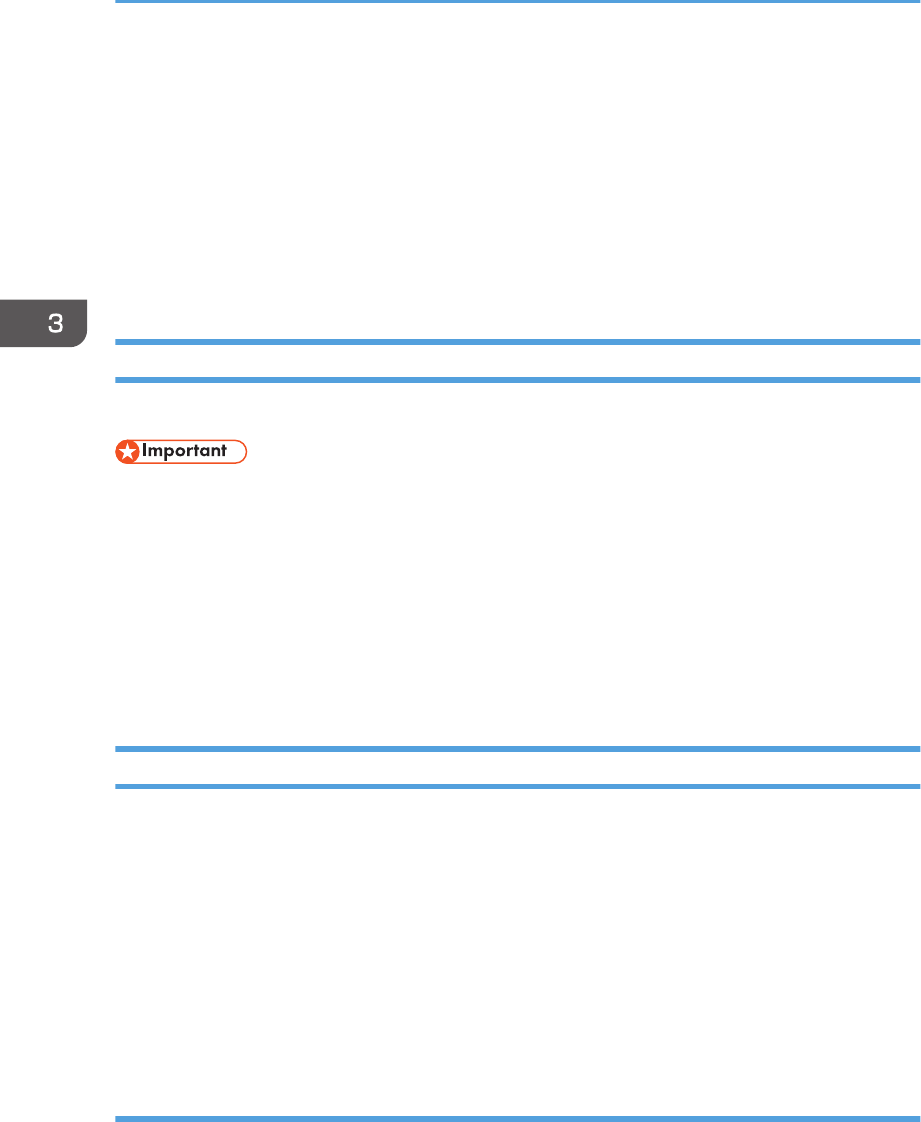
Displaying the Printing Preferences Dialog Box
To change the default settings of the printer driver, make settings in the [Printing Preferences] dialog box.
To change the default settings of all applications, open the [Printing Preferences] dialog box from the
OS. For details, see page 70 "Displaying the Printing Preferences Dialog Box from the [Start] Menu".
To change the default settings of a specific application, open the [Printing Preferences] dialog box from
that application. For details, see page 70 "Displaying the Printing Preferences Dialog Box in an
Application".
Displaying the Printing Preferences Dialog Box from the [Start] Menu
This section explains how to open the [Printing Preferences] dialog box from [Devices and Printers].
• When the printer driver is distributed from the print server, the setting values specified by the server
are displayed as the default for [Printing Defaults...].
• You cannot configure different print settings for each user. The settings configured in this dialog box
are used as the default.
1. On the [Start] menu, click [Devices and Printers].
2. Right-click the icon of the printer you want to use.
3. Click [Printing Preferences].
Displaying the Printing Preferences Dialog Box in an Application
You can make printer settings for a specific application. To make printer settings for a specific
application, open the [Printing Preferences] dialog box from that application.
The settings displayed in the [Printing Preferences] dialog box opened from the [Devices and Printers]
window are applied as the default in the [Printing Preferences] dialog box opened in an application.
When printing from an application, modify the settings as required.
The screens displayed may differ depending on the application. The following procedure explains how
to print documents from an application using WordPad in Windows 7 as an example.
Displaying the Printing Preferences Dialog Box in an Application When Using
Windows
1. Click the WordPad menu button in the upper left corner of the window, and then click
[Print].
2. In the [Select Printer] list, select the printer you want to use.
3. Printing Documents
70 opal-p3_mf3_com_user_guide_gb_00228436_eng.xml
Draft 2016/05/27

3. Click [Preferences].
• Procedures for opening the [Printing Preferences] dialog box vary depending on the application.
For details, see the printer driver Help or the manuals provided with the application.
Displaying the Printing Preferences Dialog Box in an Application When Using Mac OS
X
The following procedure is explained using Mac OS X 10.11 as an example.
1. Open the document to print.
2. Select [Print...] on the [File] menu.
3. Check that the machine name or IP address you are using is selected in the [Printer:]
popup menu.
If the machine name or IP address you are using is not selected in the [Printer:] list, click the list, and
then select the machine.
Displaying the Printing Preferences Dialog Box
opal-p3_mf3_com_user_guide_gb_00228436_eng.xml 71
Draft 2016/05/27
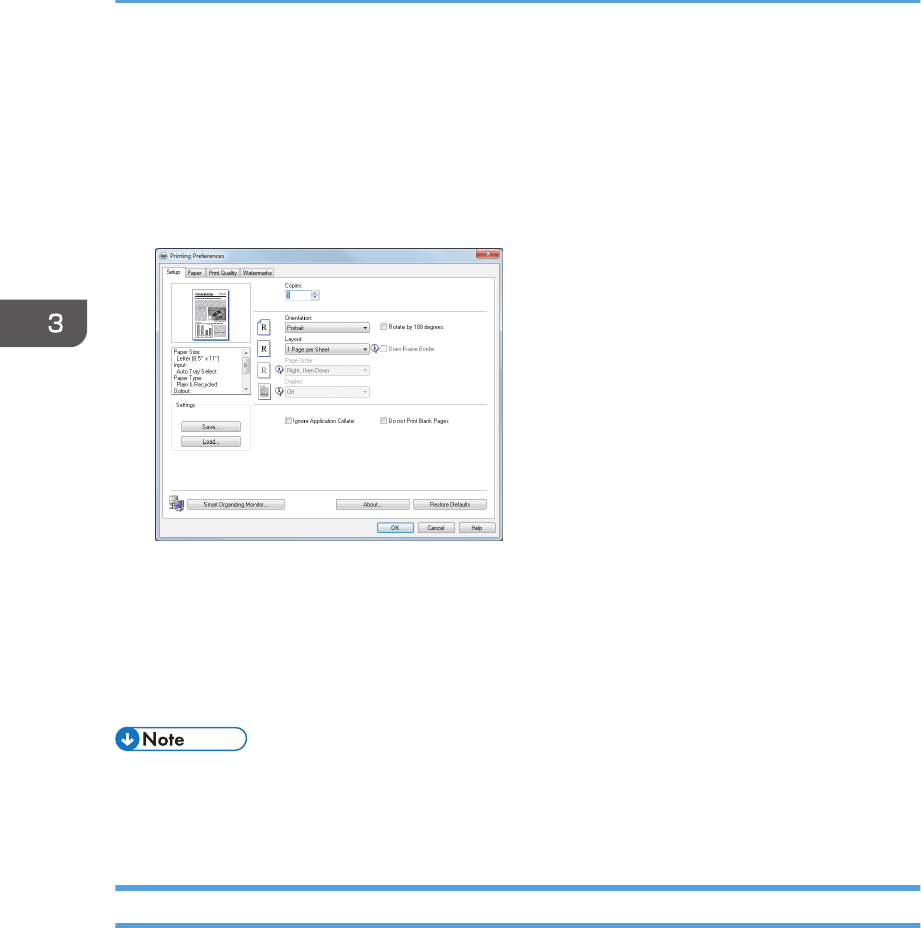
Basic Operation of Printing
The following procedure explains how to perform basic printing.
For details of printing options, see the printer driver Help.
1. Open the printer properties dialog box in your document's application.
For details about each setting, click [Help]. You can also click the information icons to show
configuration information.
2. Set printing options as necessary, and then click [OK].
The printer properties dialog box closes.
3. Click [Print].
• If a paper jam occurs, printing stops after the current page has been printed out. After the jammed
paper is removed, printing restarts from the jammed page automatically. For details about how to
remove the jammed paper, see page 273 "Clearing Misfeeds".
If a Paper Mismatch Occurs
The machine reports an error if the paper size does not match the print job's settings when [Size
Mismatch Detection] under [Tray Paper Settings] is enabled.
There are two ways to resolve these errors:
Continue printing using mismatched paper
Use the form-feed function to ignore the error and print using mismatched paper.
Cancel the print job
Cancel printing.
3. Printing Documents
72 opal-p3_mf3_com_user_guide_gb_00228437_eng.xml
Draft 2016/05/27
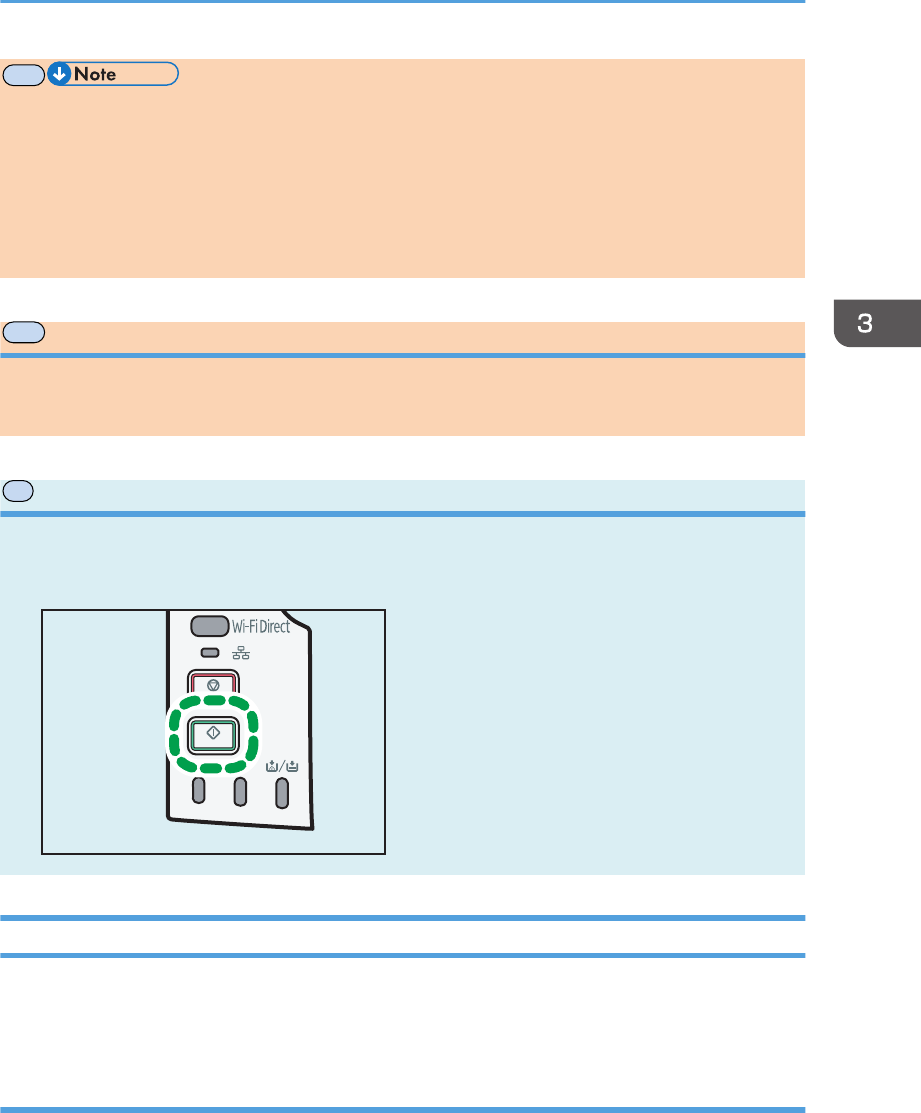
MF
• For details about [Size Mismatch Detection], see page 187 "Tray Paper Settings".
• If [Auto Continue] under [System Settings] is enabled, the machine ignores the paper type and size
settings and prints on whatever paper is loaded. Printing stops temporarily when the error is
detected, and restarts automatically after about ten seconds using the settings made on the control
panel.
• For details about [Auto Continue], see page 182 "System Settings".
MF
Continuing printing using mismatched paper
If the paper is too small for the print job, the printed image will be cropped.
1. If the error message is displayed, press [FormFeed].
P
Continuing printing using mismatched paper
If the paper is too small for the print job, the printed image will be cropped.
1. If the Alert indicator lights up, press the [Start] key.
DSG128
Canceling a Print Job
You can cancel print jobs using either the machine's control panel or your computer, depending on the
status of the job.
Canceling a print job before printing has started
• Windows
1. Double-click the printer icon on the task tray of your computer.
Basic Operation of Printing
opal-p3_mf3_com_user_guide_gb_00228437_eng.xml 73
Draft 2016/05/27
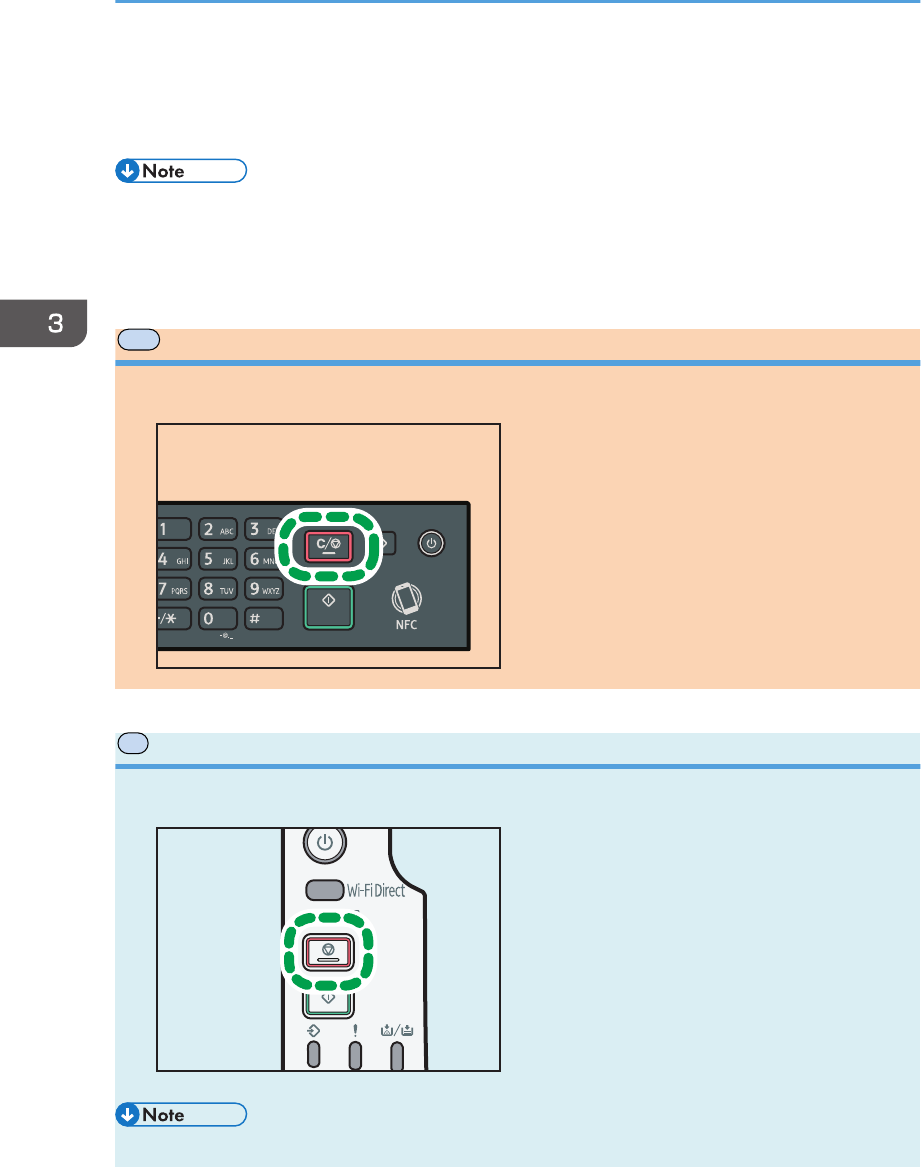
2. Select the print job you want to cancel, click the [Document] menu, and then click
[Cancel].
3. Click [Yes].
• If you cancel a print job that has already been processed, printing may continue for a few pages
before being canceled.
• It may take a while to cancel a large print job.
MF
Canceling a print job while printing
1. Press the [Clear/Stop] key.
DSH144
P
Canceling a print job while printing
1. Press the [Stop] key twice.
DSG130
• The first time you press the [Stop] key pauses the job, the second time cancels the job.
3. Printing Documents
74 opal-p3_mf3_com_user_guide_gb_00228437_eng.xml
Draft 2016/05/27
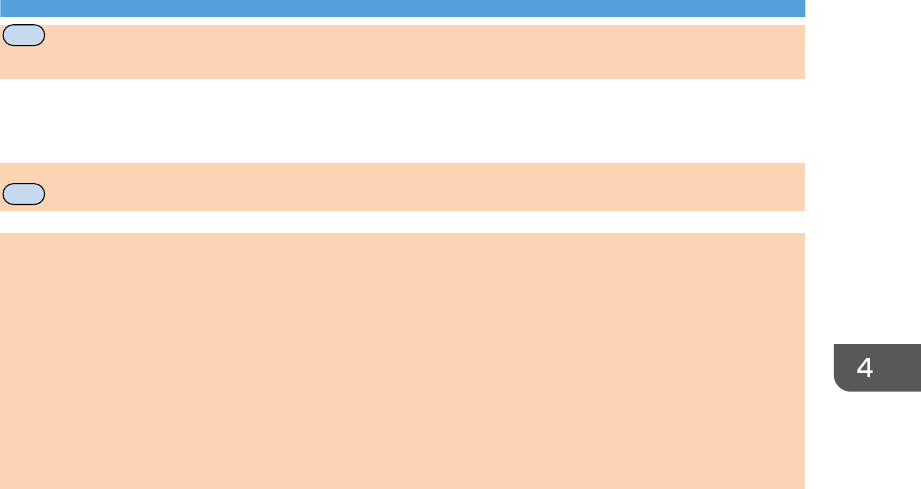
4. Copying Originals
MF
This chapter describes the basic and advanced procedures for making copies and how to specify
settings.
MF
What You Can Do with the Copier Function
Combine copying
Combine copying allows you to copy multiple pages onto a single sheet. This saves paper and
documents require less shelf space for storage.
For details about the settings, see page 82 "Making Combined/2-sided Copies".
ID card copying
ID card copying allows you to copy the front and back sides of an ID card or other small
documents onto one side of a sheet of paper.
For details, see page 87 "Copying an ID Card".
opal-p3_mf3_com_user_guide_gb_00228440_eng.xml 75
Draft 2016/05/27
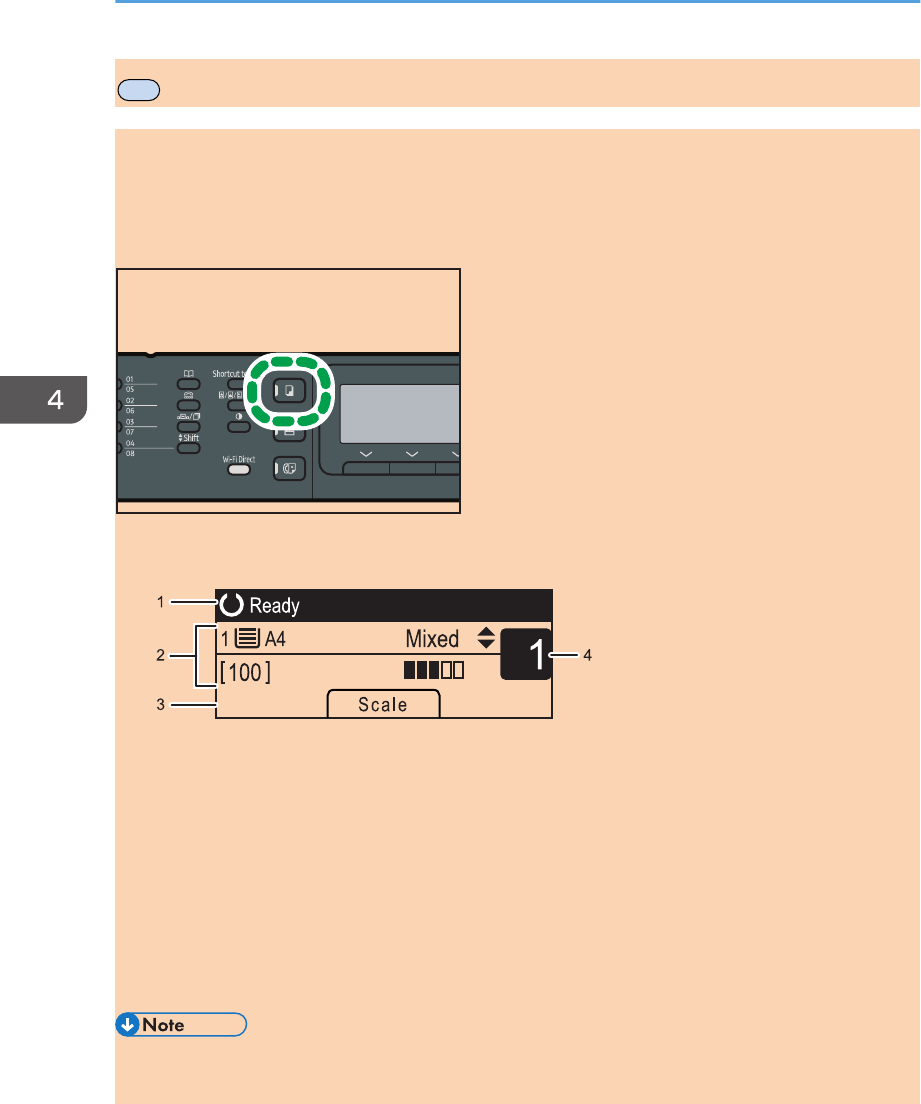
MF
Copier Mode Screen
This section provides information about the screen when the machine is in copier mode.
By default, the display shows the copier screen when the machine is turned on.
If the scanner or fax screen is shown on the display, press the [Copy] key on the control panel to switch
to the copier screen.
DSH146
Screen in standby mode
CVW200
1. Current status or messages
Displays the current status or messages.
2. Current settings
Displays the current tray, reproduction ratio, and scan settings.
3. Selection key items
Displays the functions you can use by pressing the corresponding selection keys.
4. Copy quantity
Displays the current copy quantity. You can change the copy quantity using the number keys.
• The start-up mode can be specified in the [Function Priority] setting under [Admin. Tools]. For
details, see page 189 "Administrator Settings".
4. Copying Originals
76 opal-p3_mf3_com_user_guide_gb_00228441_eng.xml
Draft 2016/05/27
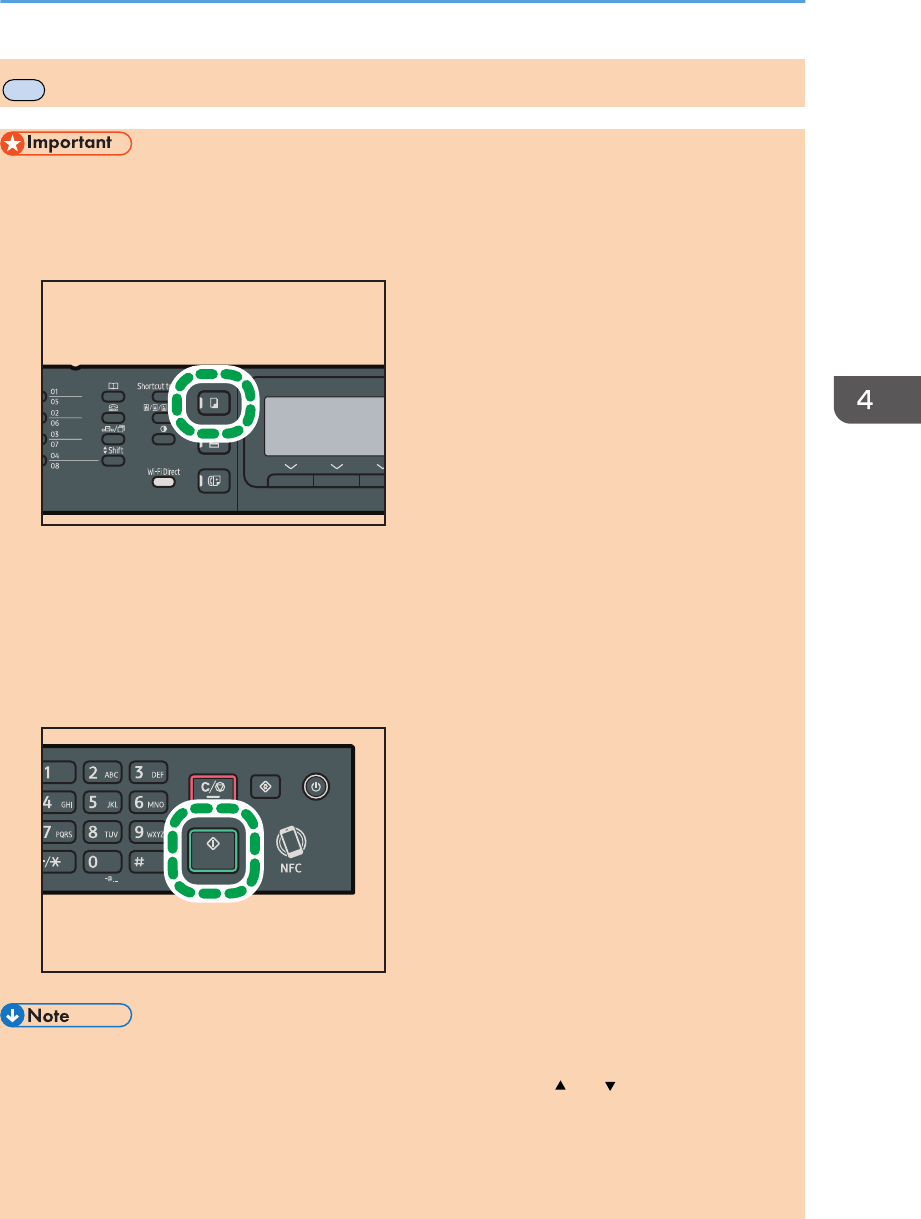
MF
Basic Operation of Copying
• The original in the ADF takes precedence over the original on the exposure glass if you place
originals both in the ADF and on the exposure glass.
1. Press the [Copy] key.
DSH146
2. Place the original on the exposure glass or in the ADF. To place the original, see page 62
"Placing Originals".
If necessary, configure advanced photocopy settings.
3. To make multiple copies, enter the number of copies using the number keys.
4. Press the [Start] key.
DSH147
• The maximum number of copies is 99.
• You can change the paper tray for the current job by pressing the [ ] or [ ] key. You can also
select to change the paper tray automatically according to the paper size (A4, Letter, or 16K).
• You can select the paper tray for printing out copies in [Select Paper] under [Copier Features]. If
you set the machine to switch between tray 1 and the bypass tray automatically depending on the
paper size in this setting, you can also specify the tray the machine uses first in [Paper Tray Priority]
Basic Operation of Copying
opal-p3_mf3_com_user_guide_gb_00228442_eng.xml 77
Draft 2016/05/27
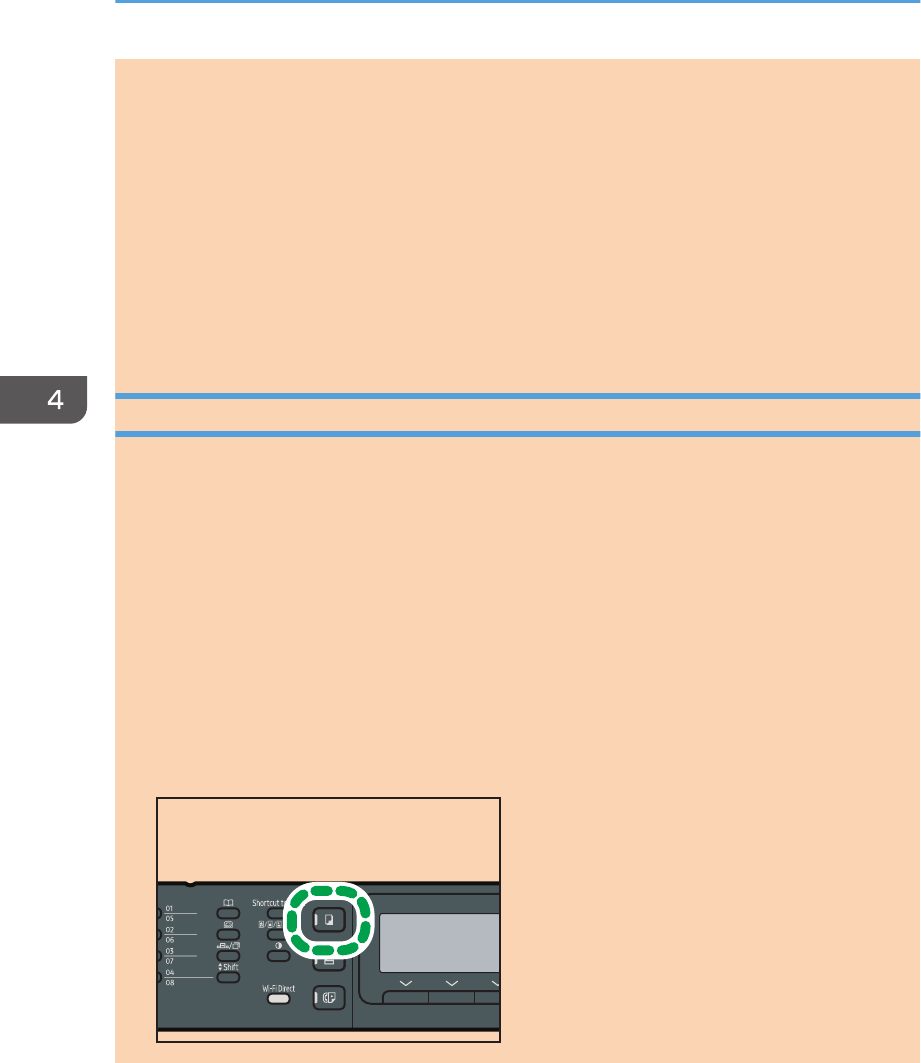
under [Tray Paper Settings]. For [Select Paper], see page 168 "Copier Features Settings". For
[Paper Tray Priority], see page 187 "Tray Paper Settings".
• When making multiple copies of a multi-page document, you can select whether copies are output
in collated sets, or in page batches in the [Sort] setting under [Copier Features]. [Sort] cannot be
used with the bypass tray. For [Sort], see page 168 "Copier Features Settings".
• If a paper jam occurs, printing stops after the current page has been printed out. After the jammed
paper is removed, printing restarts from the jammed page automatically.
• If a scanning jam occurs in the ADF, copying is canceled immediately. In this case, copy the
originals again starting from the jammed page. For the direction to remove the jammed paper, see
page 273 "Clearing Misfeeds".
Canceling a Copy
While scanning the original
If copying is canceled while the machine is scanning the original, copying is cancelled immediately
and there is no printout.
When the original is set in the ADF, scanning stops immediately but pages that have already been
scanned completely will be copied.
While printing
If copying is canceled during printing, the photocopy process is canceled after the current page
has been printed out.
Follow the procedure below to cancel copying.
1. Press the [Copy] key.
DSH146
4. Copying Originals
78 opal-p3_mf3_com_user_guide_gb_00228442_eng.xml
Draft 2016/05/27
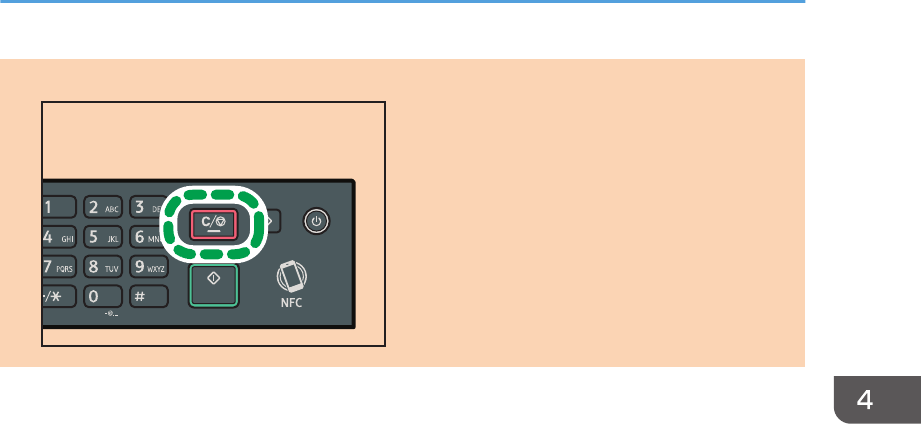
2. Press the [Clear/Stop] key.
DSH144
Basic Operation of Copying
opal-p3_mf3_com_user_guide_gb_00228442_eng.xml 79
Draft 2016/05/27
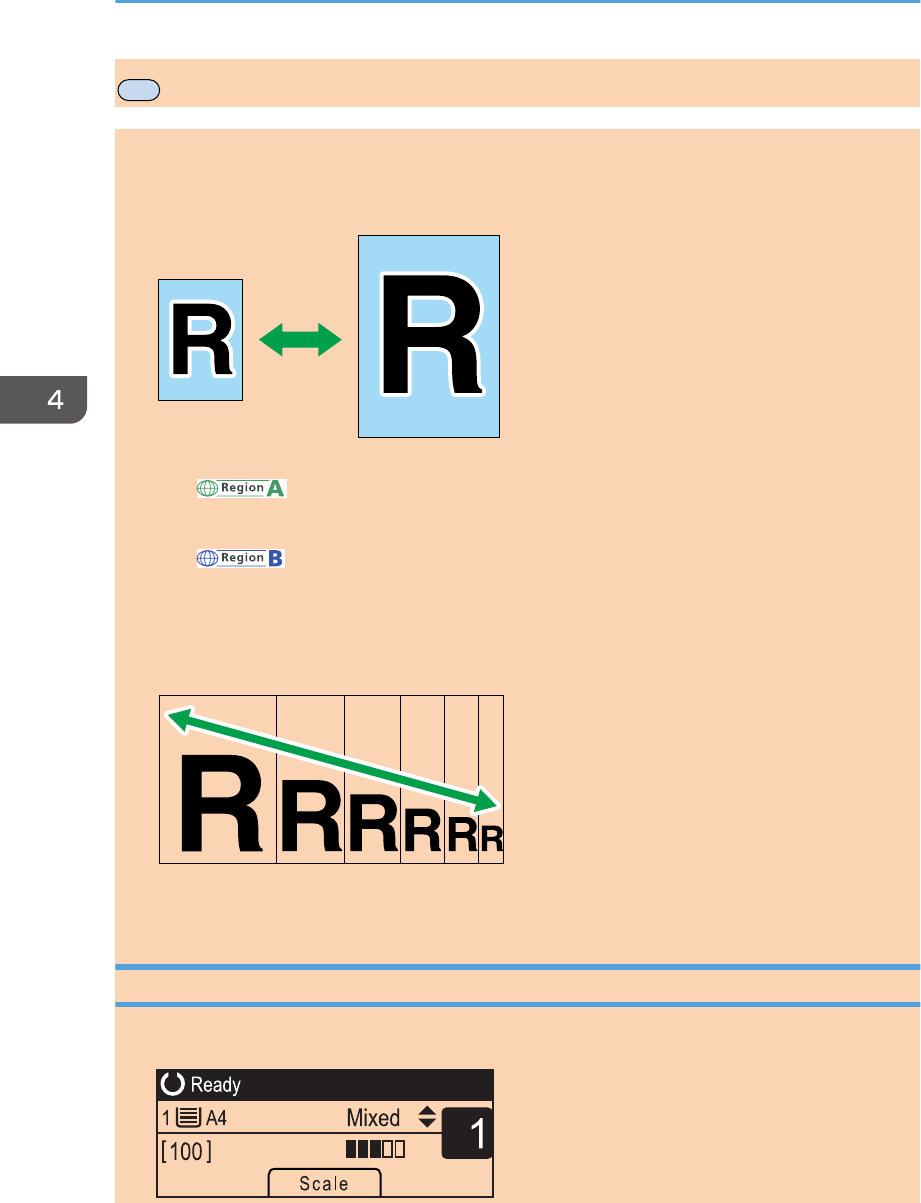
MF
Making Enlarged or Reduced Copies
There are two ways to set the scaling ratio: using a preset ratio or manually specifying a customized
ratio.
Preset ratio
CES103
• (mainly Europe and Asia)
50%, 71%, 82%, 93%, 122%, 141%, 200%, 400%
• (mainly North America)
50%, 65%, 78%, 93%, 129%, 155%, 200%, 400%
50%, 71%, 82%, 93%, 122%, 141%, 200%, 400%
Custom ratio
CES106
25% to 400% in 1% increments.
Specifying Reduce/Enlarge
1. Press [Scale].
4. Copying Originals
80 opal-p3_mf3_com_user_guide_gb_00228443_eng.xml
Draft 2016/05/27

2. Press [Reduce], [Enlarge], or [Zoom].
For [Reduce] or [Enlarge], press the [ ], [ ], [ ], or [ ] key to select the desired ratio. For [Zoom],
specify the desired ratio using the number keys.
3. Press the [OK] key.
Making Enlarged or Reduced Copies
opal-p3_mf3_com_user_guide_gb_00228443_eng.xml 81
Draft 2016/05/27
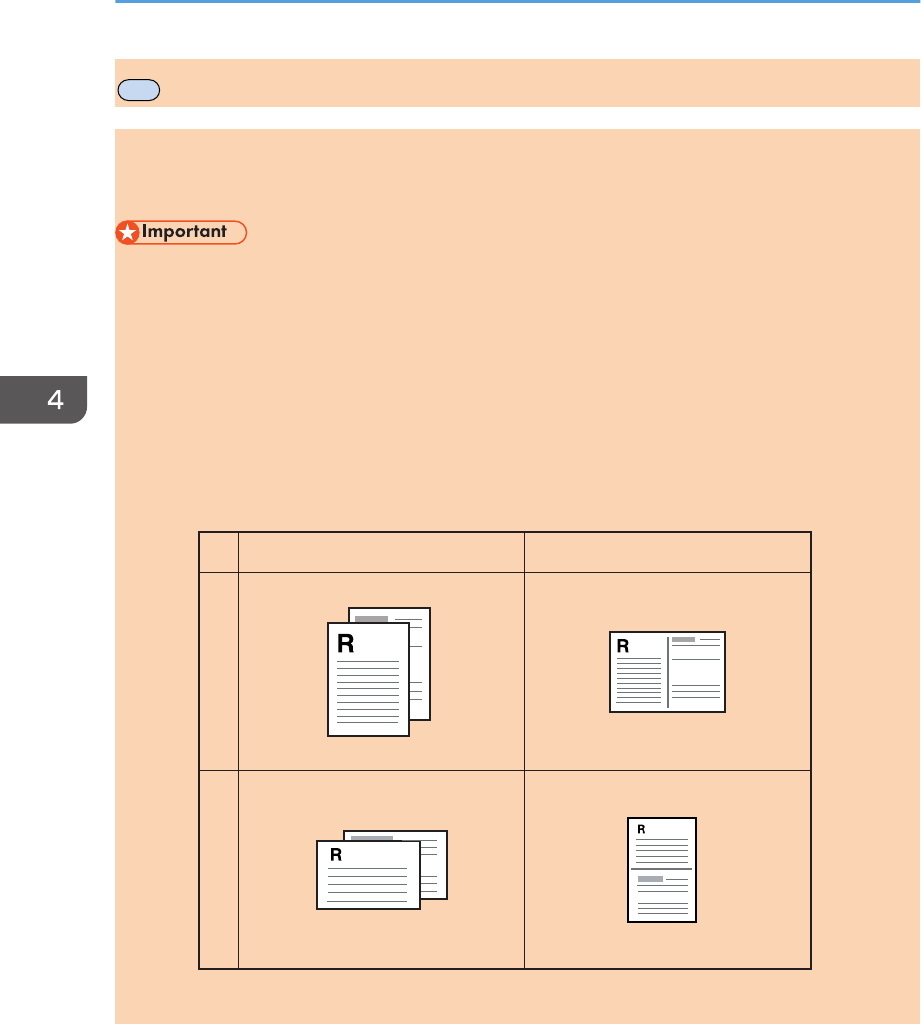
MF
Making Combined/2-sided Copies
This section describes how to combine and print a multiple pages (two or four pages) on one side or
both sides of paper. Only SP 220SNw, SP221SNw, SP221SF, SP 220SFNw, and SP221SFNw are
available.
• This function is only available when the original is set in the ADF, not when it is set on the exposure
glass.
• To use this function, the paper size used for printing copies must be set to A4, Letter or Legal.
There are following copy modes. Select a copy mode according to your original and how you want the
copy outputs to appear.
Combined copy on one side
In this mode, a two or four-page original is combined and printed on one side of paper.
• 1Sd 2Orig->Comb 2on1 1Sd
PortraitLandscape
Original Copy
CMF250
• 1Sd 4Orig->Comb 4on1 1Sd
4. Copying Originals
82 opal-p3_mf3_com_user_guide_gb_00228444_eng.xml
Draft 2016/05/27
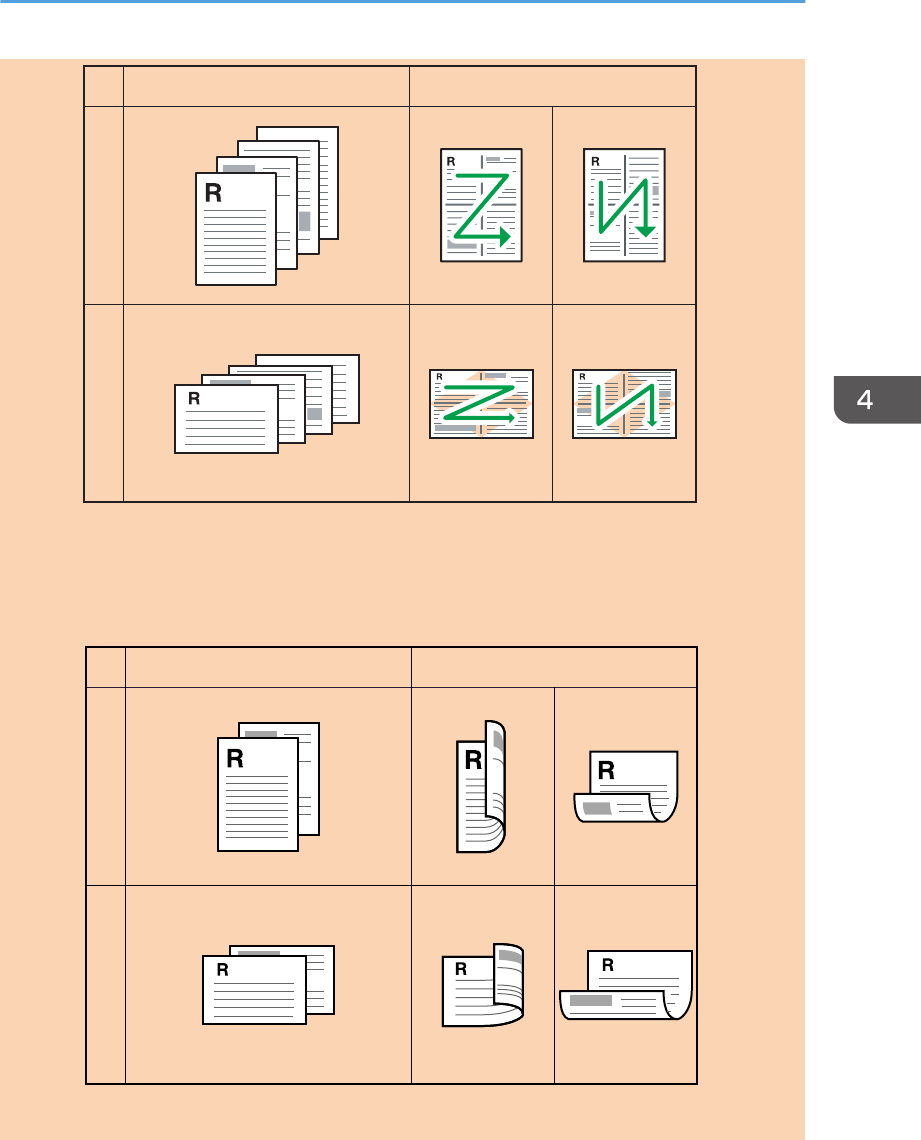
PortraitLandscape
Original Copy
Left to Right Top to Bottom
Left to Right Top to Bottom
DCT002
Combined copy on both sides
In this mode, a multiple-page original is combined and printed on both sides of paper.
• 1 Sided Orig->2 Sided Copy
PortraitLandscape
Original Copy
CMF260
Top to Top Top to Bottom
Top to Top Top to Bottom
• 1Sd 4Orig->Comb 2on1 2Sd
Making Combined/2-sided Copies
opal-p3_mf3_com_user_guide_gb_00228444_eng.xml 83
Draft 2016/05/27
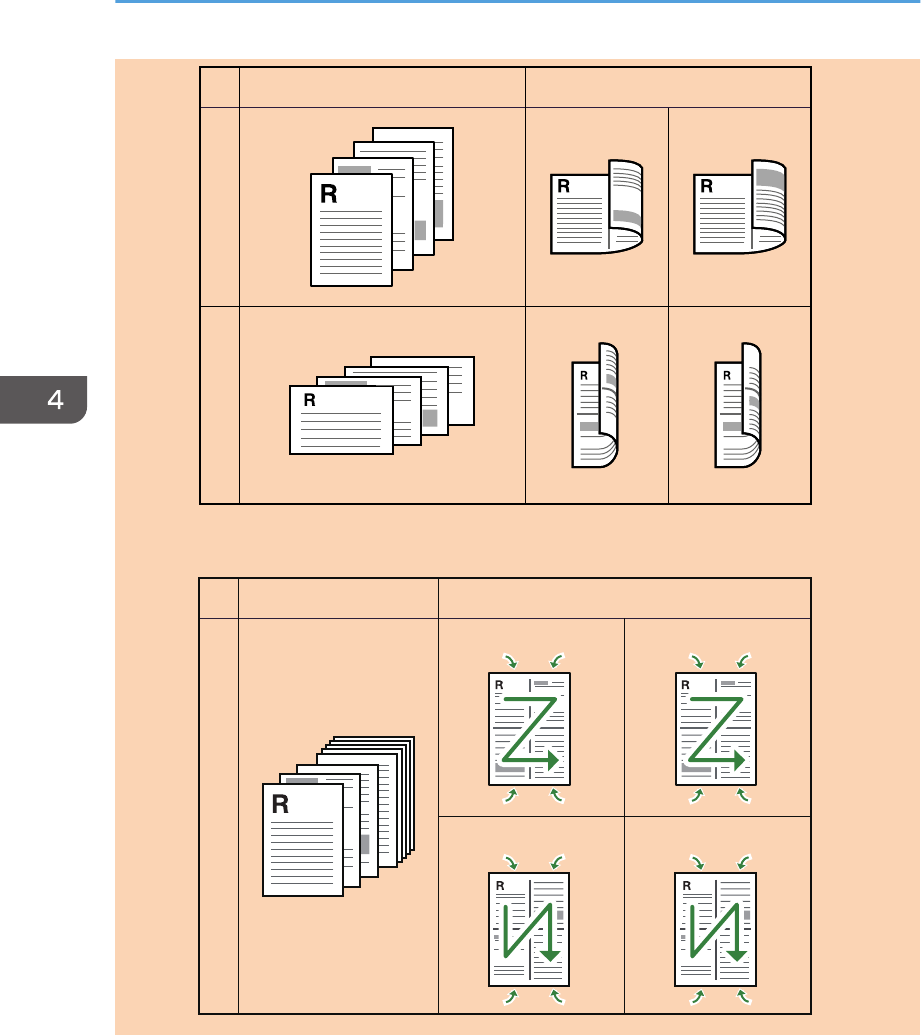
PortraitLandscape
Original Copy
Top to Top Top to Bottom
Top to Top Top to Bottom
CMF254
• 1Sd 8Orig->Comb 4on1 2Sd
87
65
86
75
65
87
75
86
Portrait
Original Copy
Left to Right, Top to Top Left to Right, Top to Bottom
Top to Bottom, Top to Top Top to Bottom, Top to Bottom
DCT003
4. Copying Originals
84 opal-p3_mf3_com_user_guide_gb_00228444_eng.xml
Draft 2016/05/27
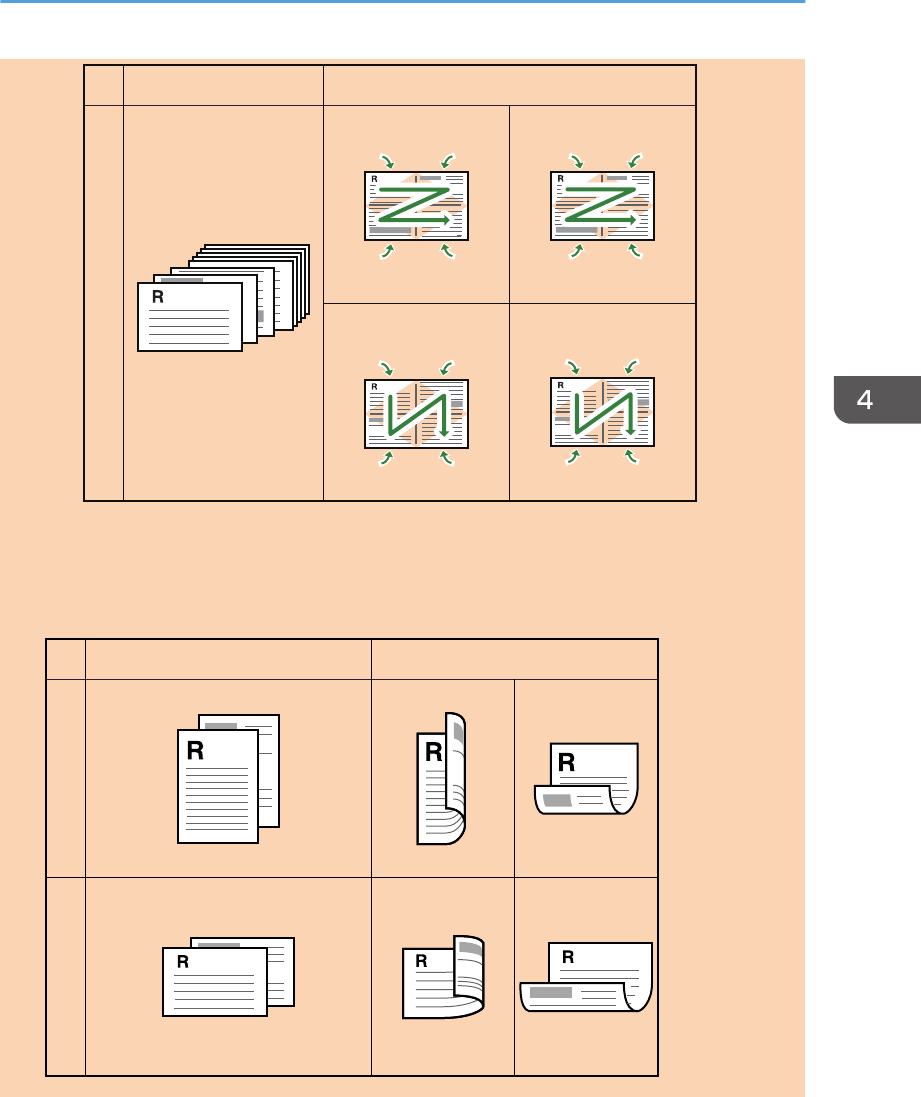
87
65
86
75
65
87
75
86
Landscape
Original Copy
Left to Right, Top to Top Left to Right, Top to Bottom
Top to Bottom, Top to Top Top to Bottom, Top to Bottom
DCT004
2-sided copy
In this mode, one-sided pages are printed on the front and back sides of paper without being
combined.
PortraitLandscape
Original Copy
CMF260
Top to Top Top to Bottom
Top to Top Top to Bottom
Making Combined/2-sided Copies
opal-p3_mf3_com_user_guide_gb_00228444_eng.xml 85
Draft 2016/05/27
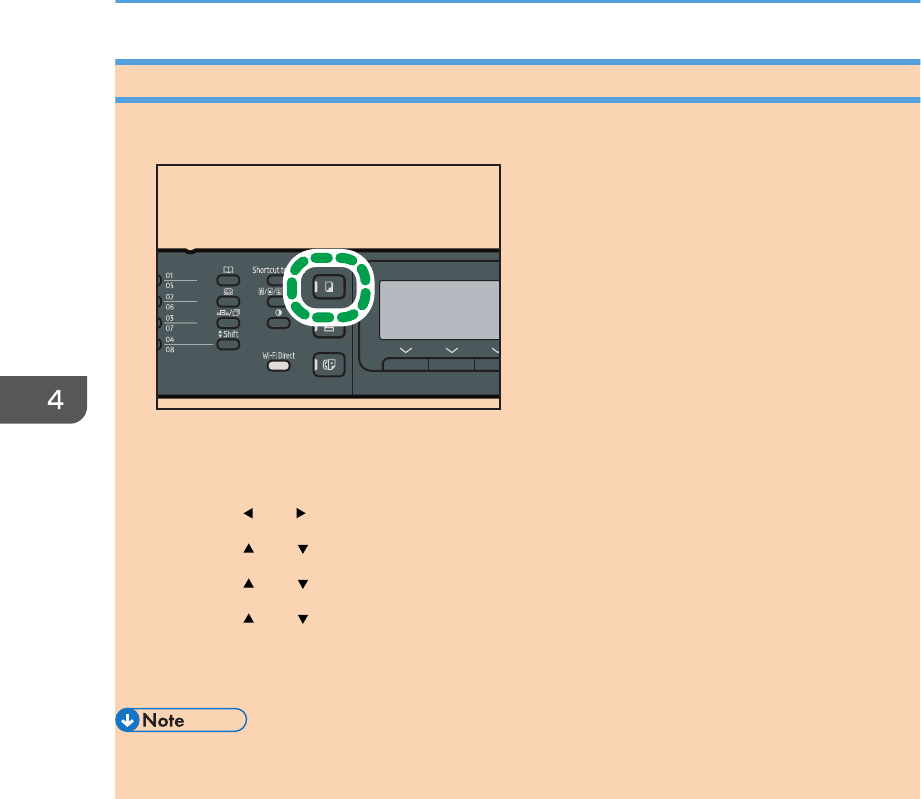
Specifying Combined and 2-sided Copies
1. Press the [Copy] key.
DSH146
With Type 1 models, start from Step 2. If ID card copy mode is being displayed, press the [Shortcut
to Func.] key again to switch to normal copier mode.
2. Press the [ ] or [ ] key.
3. Press the [ ] or [ ] key to select [Duplex/Combine].
4. Press the [ ] or [ ] key to select the desired copy mode, and then press the [OK] key.
5. Press the [ ] or [ ] key to select paper orientation and page order, and then press the
[OK] key.
The screen will show the selected copy mode.
• After you place the originals, press the [Start] key within the time specified in [System Auto Reset
Timer]. Otherwise, the job is canceled. For details, see page 189 "Administrator Settings".
4. Copying Originals
86 opal-p3_mf3_com_user_guide_gb_00228444_eng.xml
Draft 2016/05/27
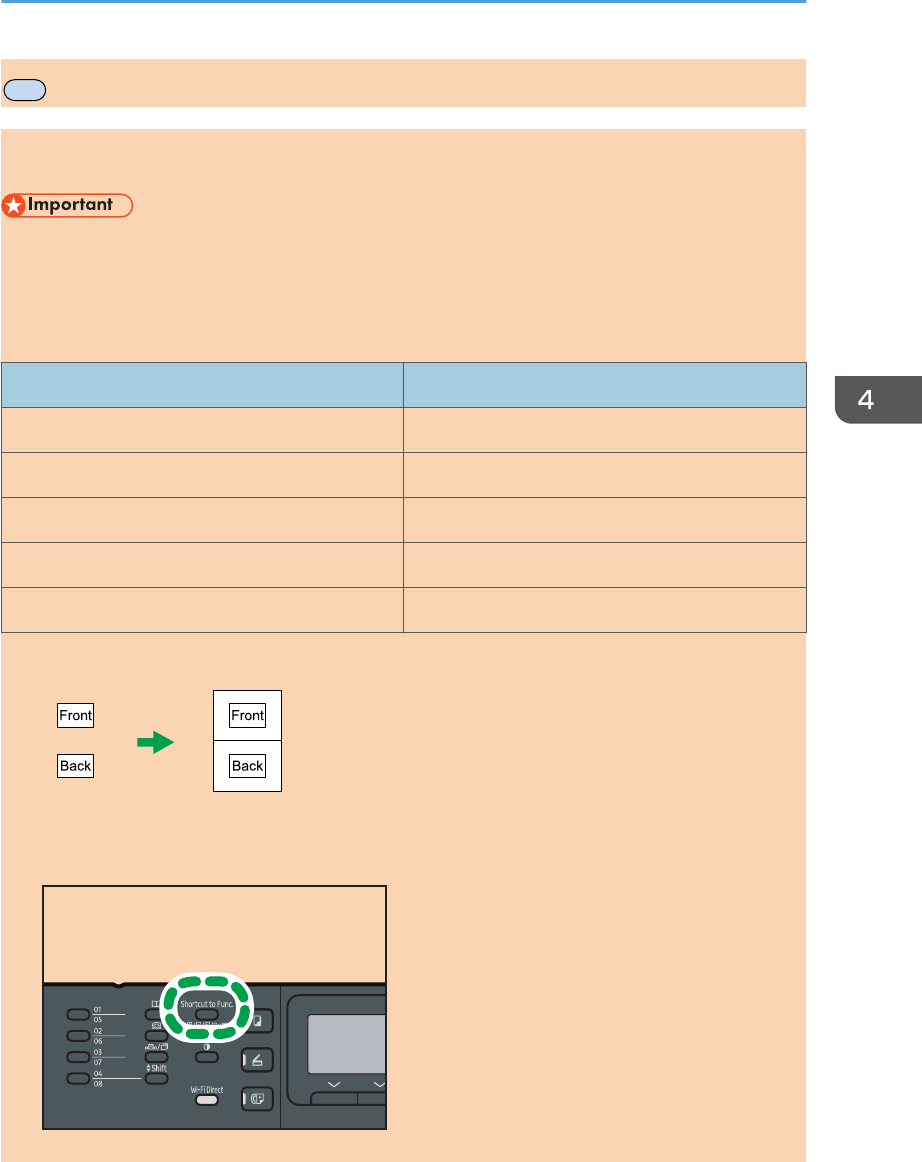
MF
Copying an ID Card
This section describes how to copy the front and back sides of an ID card or other small documents onto
one side of a sheet of paper.
• This function is available only when the original is set on the exposure glass, not when it is set in the
ADF.
• To use this function, the paper size used for printing copies must be set to A6, A5, A4, Half Letter or
Letter.
Printed paper size Scanned paper size
A4 A5 (148×210 mm)
Letter Half Letter (140×216 mm)
A5 A6 (105×148 mm)
Half Letter Quarter Letter (108×140 mm)
A6 A7 (74×105 mm)
CES165
1. Press the [Shortcut to Func.] key.
DSH141
Copying an ID Card
opal-p3_mf3_com_user_guide_gb_00228445_eng.xml 87
Draft 2016/05/27
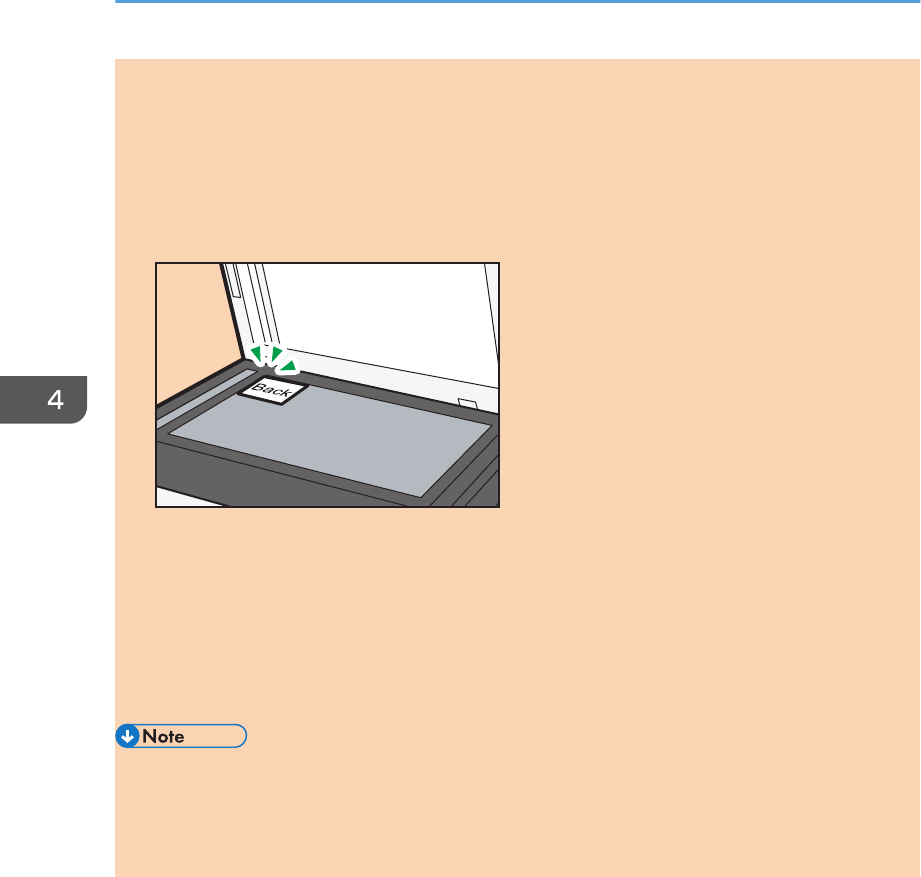
To make the [Shortcut to Func.] key enable ID card copy mode for the current job, [Shortcut to
Function] under [Admin. Tools] must be set to [ID Card Copy Mode]. You can also assign the
setting using Web Image Monitor.
For [Shortcut to Function], see page 189 "Administrator Settings".
2. To make multiple copies, enter the number of copies using the number keys.
3. Place the original in the upper-left corner of the exposure glass.
DCT840
4. Press the [Start] key.
A message prompting you to place the original back side down on the exposure glass appears on
the display.
5. Place the original on the exposure glass back side down and with the top to the rear of
the machine within the time specified in [System Auto Reset Timer], and then press the
[Start] key again.
• For the ID card copy function, you can set the machine to print a line in the middle of the printed
paper. Specify [ID Card Center Line] under [Copier Features].
• You can change the scanning size for the ID card function. Specify [ID Card Size] under [Copier
Features].
4. Copying Originals
88 opal-p3_mf3_com_user_guide_gb_00228445_eng.xml
Draft 2016/05/27
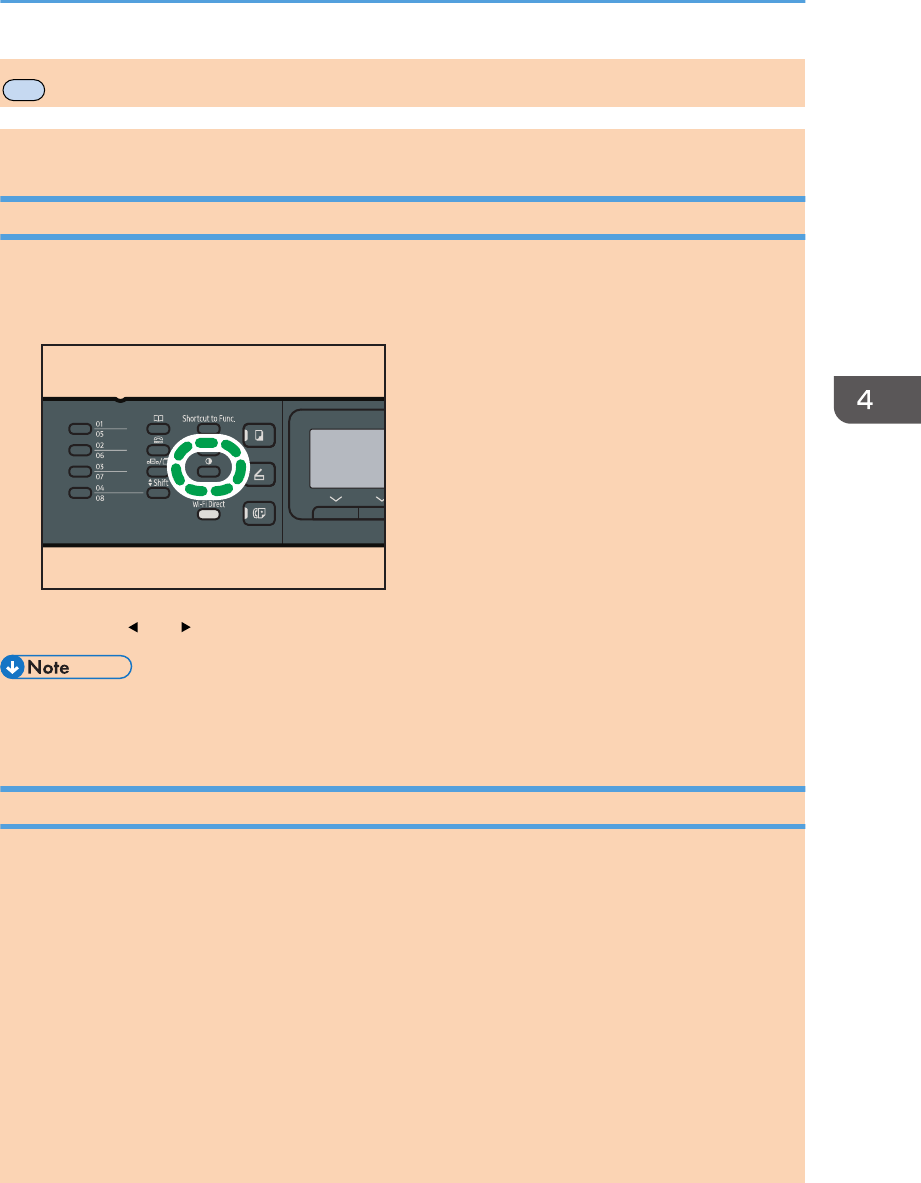
MF
Specifying the Scan Settings for Copying
This section describes how to specify image density and scan quality for the current job.
Adjusting Image Density
There are five image density levels. The higher the density level, the darker the printout.
1. Press the [Density] key.
DSH153
2. Press the [ ] or [ ] key to select the desired density level, and then press the [OK] key.
• You can change the machine's default [Density] setting to always make copies with a specific
density level. For details, see page 168 "Copier Features Settings".
Selecting the Document Type According to Original
There are three document types:
Mixed
Select this when the original contains both text and photographs or pictures.
Text
Select this when the original contains only text and no photographs or pictures.
Photo
Select this when the original contains only photographs or pictures. Use this mode for the following
types of original:
• Photographs
• Pages that are entirely or mainly photographs or pictures, such as magazine pages.
Specifying the Scan Settings for Copying
opal-p3_mf3_com_user_guide_gb_00228446_eng.xml 89
Draft 2016/05/27
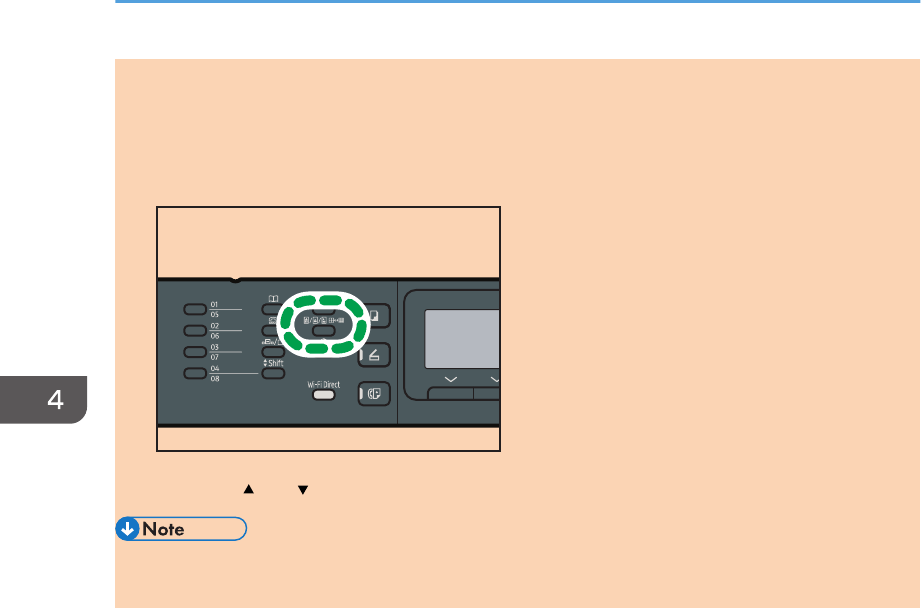
Vou.
Select this when copying a voucher. This function is available only when the original is set on the
exposure glass, not when it is set in the ADF.
1. Press the [Image Quality] key.
DSH148
2. Press the [ ] or [ ] key to select the desired document type, and then press the [OK] key.
• You can change the machine's default [Original Type] setting to always make copies with a
specific document type. For details, see page 168 "Copier Features Settings".
4. Copying Originals
90 opal-p3_mf3_com_user_guide_gb_00228446_eng.xml
Draft 2016/05/27
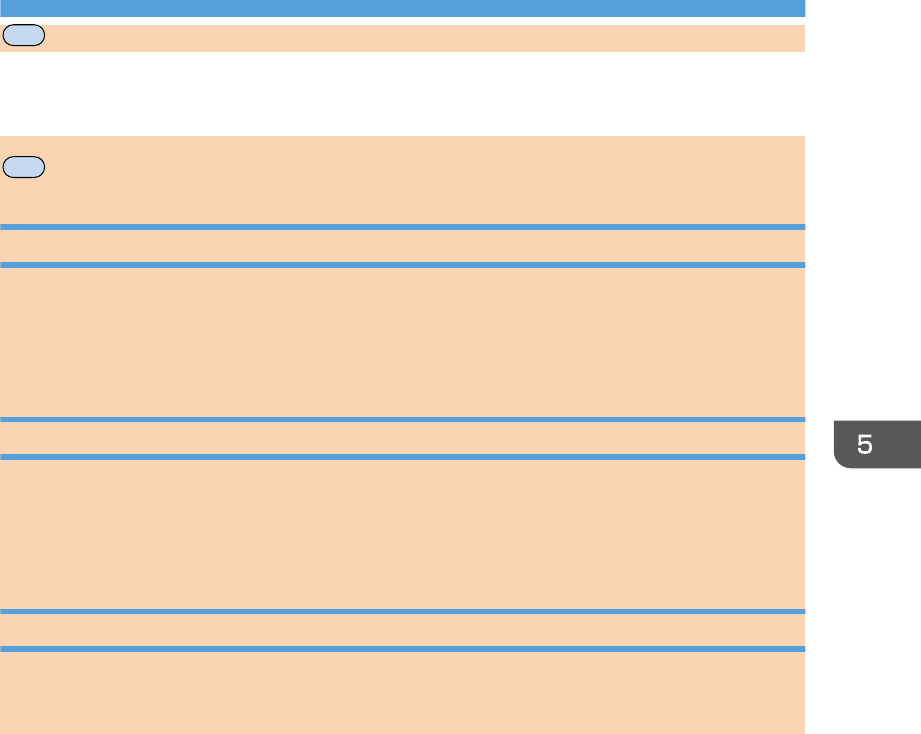
5. Scanning Originals
MF
This chapter describes how to specify settings and use the scanner function.
MF
What You Can Do with the Scanner Function
Send Scanned Documents to a Folder on a Client Computer
You can use this function to convert a large amount of paper documents into a digital format to store and
utilize.
For details, see page 101 "Basic Operation of Scan to Folder".
Send Scanned Documents by E-mail
You can use this function to scan handwritten materials such as meeting materials to distribute as a file
attached to an e-mail.
For details, see page 109 "Basic Operation of Scan to E-mail".
Scanning Documents from a Client Computer
You can use this function to download files scanned by applications directly to a computer.
For details, see page 113 "Basic Operation of Scan to FTP".
opal-p3_mf3_com_user_guide_gb_00228451_eng.xml 91
Draft 2016/05/27
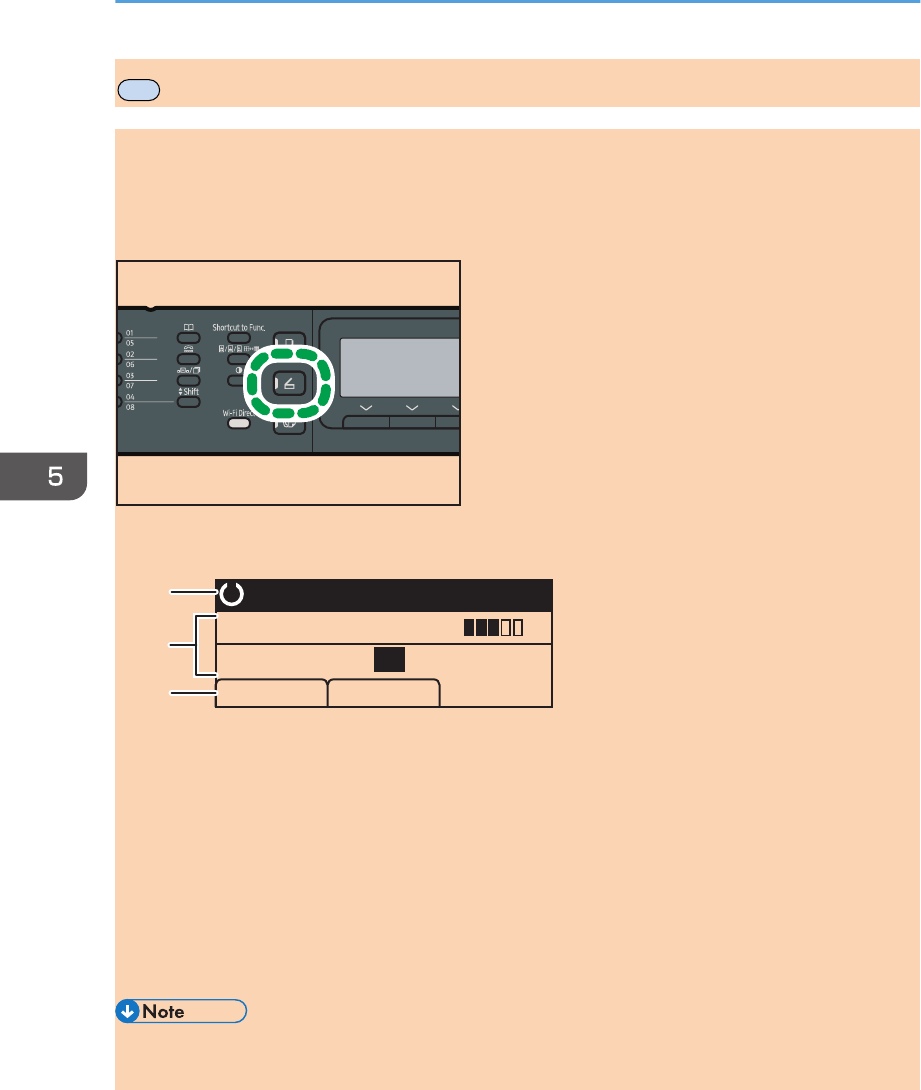
MF
Scanner Mode Screen
This section provides information about the screen in scanner mode.
By default, the display shows the copier screen when the machine is turned on. If the copier or fax
screen is shown on the display, press the [Scanner] key on the control panel to switch to the scanner
screen.
DSH149
Screen in standby mode
DSH150
Ready
Specify Dest.
A4
Scn Size Dest.
300 x 300dpi
1
3
2
1. Current status or messages
Displays the current status or messages.
2. Current settings
Displays the current scanning mode and scan settings.
• When "Specify Dest." is displayed:
Scan to E-mail, Scan to FTP, or Scan to Folder functions can be used.
3. Selection key items
Displays the functions you can use by pressing the corresponding selection keys.
• The machine's default mode at power on can be specified in the [Function Priority] setting under
[Admin. Tools]. For [Function Priority], see page 189 "Administrator Settings".
5. Scanning Originals
92 opal-p3_mf3_com_user_guide_gb_00228452_eng.xml
Draft 2016/05/27
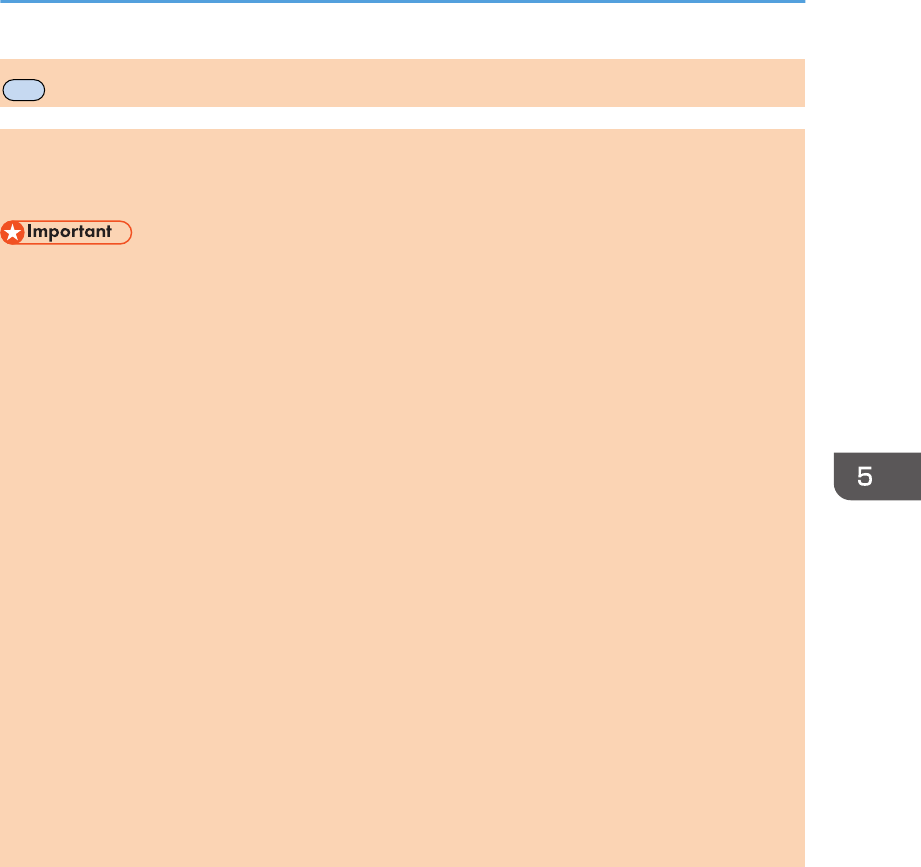
MF
Registering Scan Destinations
This section describes how to register scan destinations in the Address Book. To send scanned files to an
e-mail address (Scan to E-mail), FTP server (Scan to FTP), or a shared folder on a network computer
(Scan to Folder), you must first register the destination in the Address Book using Web Image Monitor.
• The Address Book data could be damaged or lost unexpectedly. The manufacturer shall not be
responsible for any damages resulting from such data loss. Be sure to create backup files of the
Address Book data periodically.
• Depending on your network environment, the Scan to FTP and Scan to Folder functions may
require a user name and password to be correctly entered in the destination information. In such
cases, after registering destinations, check that the user name and password are correctly entered
by sending test documents to those destinations.
The Address Book can contain up to 100 entries, including 8 Quick Dial entries.
Destinations registered as Quick Dial entries can be selected by pressing the corresponding One Touch
button (only SP 221SF, SP 220SFNw, and SP 221SFNw).
1. Start the web browser and access the machine by entering its IP address.
2. Click [Quick Dial Destination] or [Scan Destination].
3. From the [Destination Type] list, select [E-mail Address], [FTP], or [Folder].
4. Register information as necessary.
The information you must register varies depending on the destination type. For details, see the
tables below.
5. Enter the administrator password if required.
6. Click [Apply].
7. Close the web browser.
Registering Scan Destinations
opal-p3_mf3_com_user_guide_gb_00228453_eng.xml 93
Draft 2016/05/27
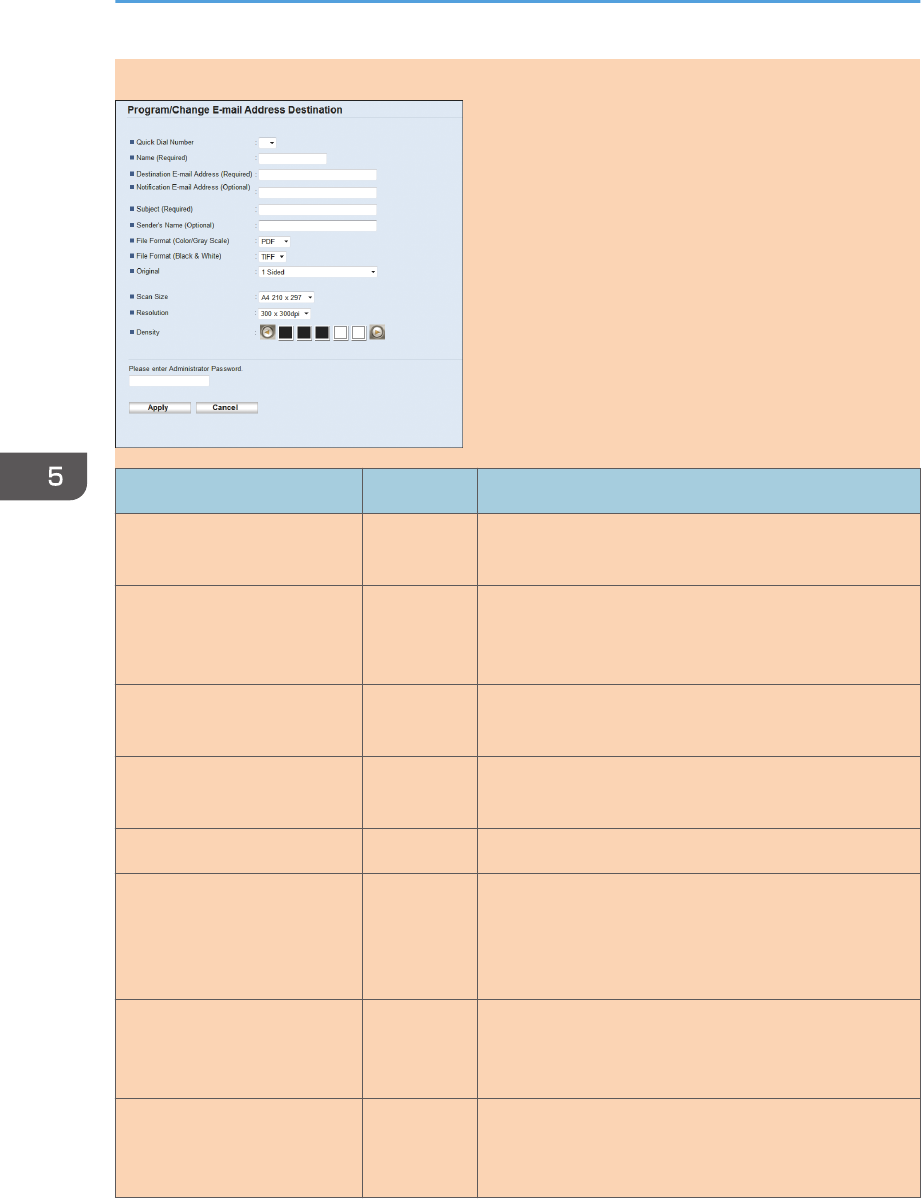
Scan to E-mail Settings
Item Setting Description
Quick Dial Number Optional Select when setting the destination as a Quick Dial
entry.
Name Required
Name of the destination. The name specified here will
be shown on the screen when selecting a scan
destination. Can contain up to 16 characters.
Destination E-mail Address Required E-mail address of the destination. Can contain up to
64 characters.
Notification E-mail Address Optional E-mail address to which a notification is sent after
transmission. Can contain up to 64 characters.
Subject Required Subject of the e-mail. Can contain up to 64 characters.
Sender's Name Optional
Name of e-mail sender. The name specified here will
be shown under "From" or a similar field of the
recipient's email application. Can contain up to 32
characters.
File Format (Color/Gray
Scale) Required
File format of the scanned file when scanning in color.
PDF or JPEG can be selected. PDF supports multiple
pages in a document, but JPEG does not.
File Format (Black & White) Required
File format of the scanned file when scanning in black
and white. PDF or TIFF can be selected. Both formats
support multiple pages in a document.
5. Scanning Originals
94 opal-p3_mf3_com_user_guide_gb_00228453_eng.xml
Draft 2016/05/27
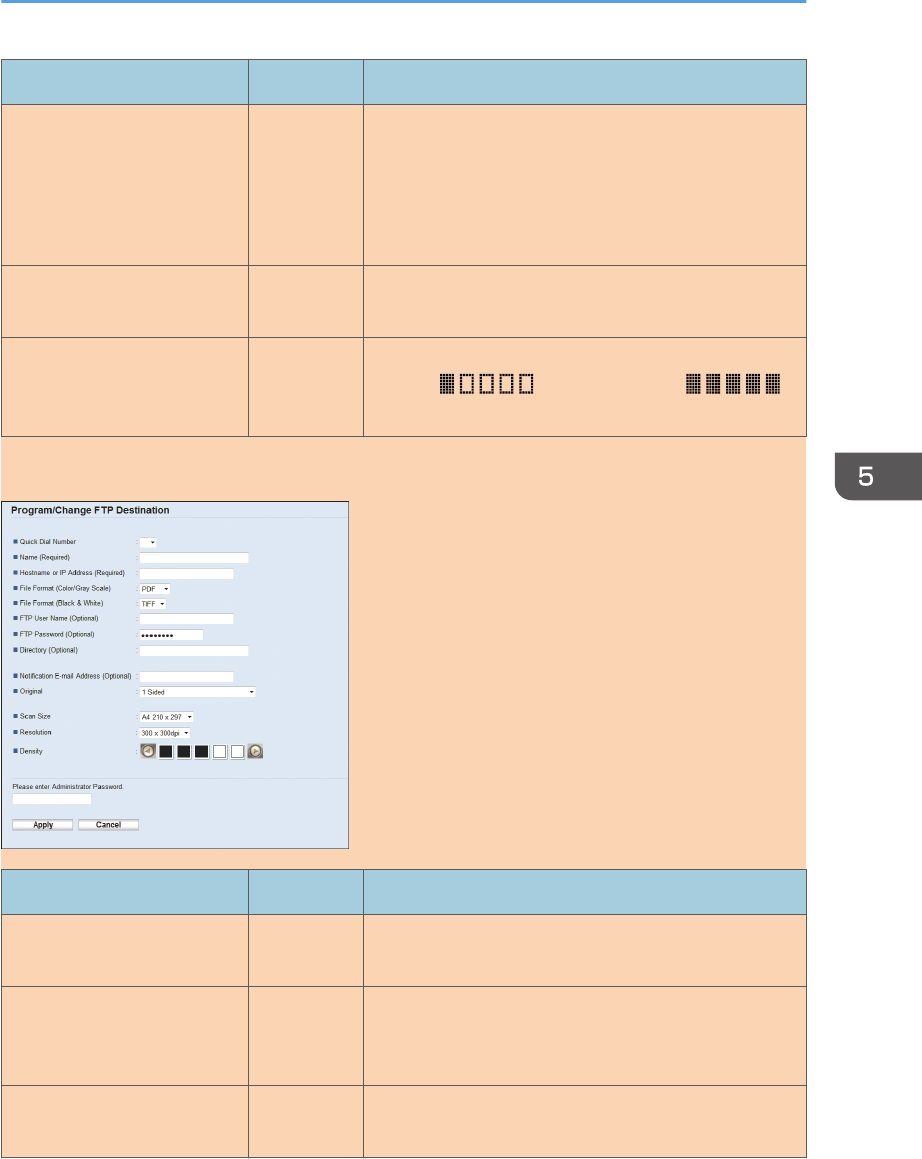
Item Setting Description
Scan Size Optional
Select the scanning size for the original from A5, B5,
A4, 71/4 × 101/2, 81/2 × 51/2, 81/2 × 11, 81/2 ×
14, 16K, or custom size.
If you select custom size, select [mm] or [Inch], and
then specify the width and length.
Resolution Optional Select the scan resolution from 100×100, 150×150,
200×200, 300×300, 400×400, or 600×600 dpi.
Density Optional
Specify the image density by clicking the right or left
buttons. is the lightest, and
is the darkest.
Scan to FTP Settings
Item Setting Description
Quick Dial Number Optional Select when setting the destination as a Quick Dial
entry.
Name Required
Name of the destination. The name specified here will
be shown on the screen when selecting a scan
destination. Can contain up to 16 characters.
Hostname or IP Address Required Name or IP address of the FTP server. Can contain up
to 64 characters.
Registering Scan Destinations
opal-p3_mf3_com_user_guide_gb_00228453_eng.xml 95
Draft 2016/05/27
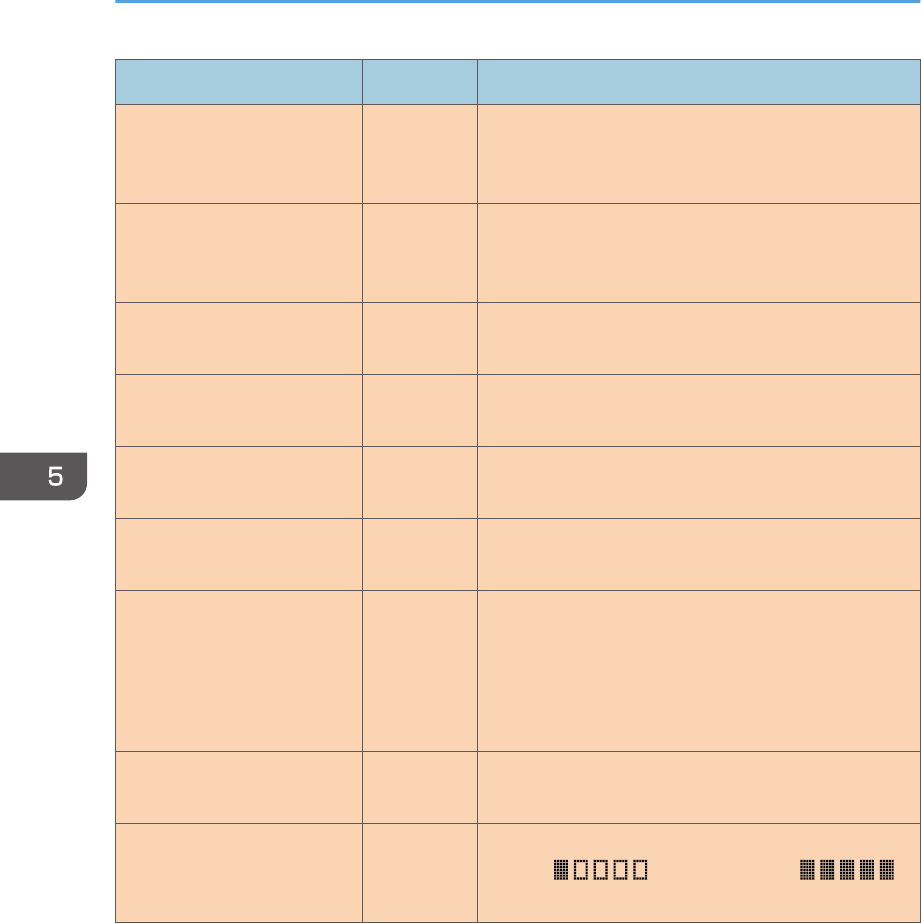
Item Setting Description
File Format (Color/Gray
Scale) Required
File format of the scanned file when scanning in color.
PDF or JPEG can be selected. PDF supports multiple
pages in a document, but JPEG does not.
File Format (Black & White) Required
File format of the scanned file when scanning in black
and white. PDF or TIFF can be selected. Both formats
support multiple pages in a document.
FTP User Name Optional User name for logging in to the FTP server. Can
contain up to 32 characters.
FTP Password Optional Password for logging in to the FTP server. Can contain
up to 32 characters.
Directory Optional Name of the FTP server directory where scanned files
are stored. Can contain up to 64 characters.
Notification E-mail Address Optional E-mail address to which a notification is sent after
transmission. Can contain up to 64 characters.
Scan Size Optional
Select the scanning size for the original from A5, B5,
A4, 71/4 × 101/2, 81/2 × 51/2, 81/2 × 11, 81/2 ×
14, 16K, or custom size.
If you select custom size, select [mm] or [Inch], and
then specify the width and length.
Resolution Optional Select the scan resolution from 100×100, 150×150,
200×200, 300×300, 400×400, or 600×600 dpi.
Density Optional
Specify the image density by clicking the right or left
buttons. is the lightest, and
is the darkest.
5. Scanning Originals
96 opal-p3_mf3_com_user_guide_gb_00228453_eng.xml
Draft 2016/05/27
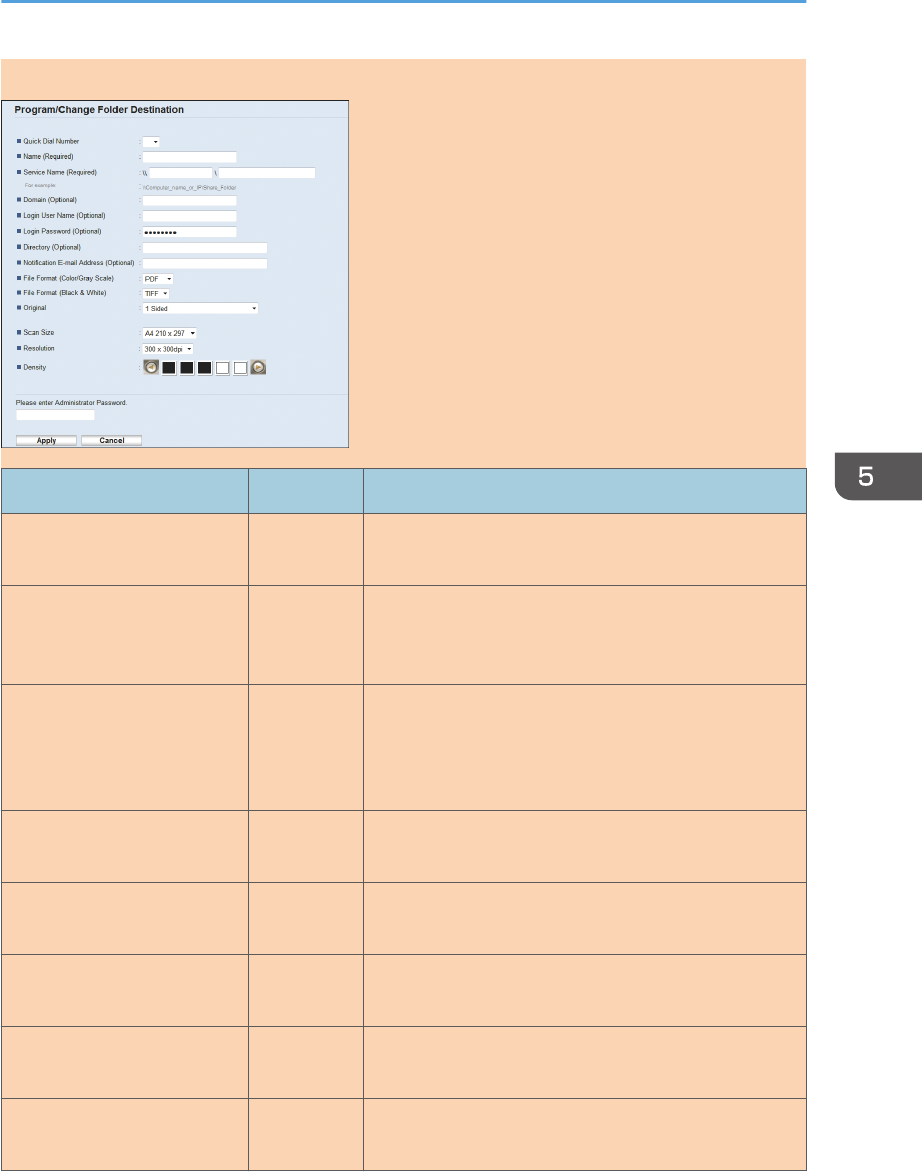
Scan to Folder Settings
Item Setting Description
Quick Dial Number Optional Select when setting the destination as a Quick Dial
entry.
Name Required
Name of the destination. The name specified here will
be shown on the screen when selecting a scan
destination. Can contain up to 16 characters.
Service Name Required
Path to the directory where scanned files will be stored.
Consists of the IP address or name of the destination
computer (can contain up to 64 characters), and name
of the shared folder (can contain up to 32 characters).
Domain Optional Specify the name of the domain to which the computer
belongs. Can contain up to 15 characters.
Login User Name Optional User name for logging in to the destination computer.
Can contain up to 32 characters.
Login Password Optional Password for logging in to the destination computer.
Can contain up to 32 characters.
Directory Optional Directory within the shared folder for storing scanned
files. Can contain up to 64 characters.
Notification E-mail Address Optional E-mail address to which a notification is sent after
transmission. Can contain up to 64 characters.
Registering Scan Destinations
opal-p3_mf3_com_user_guide_gb_00228453_eng.xml 97
Draft 2016/05/27
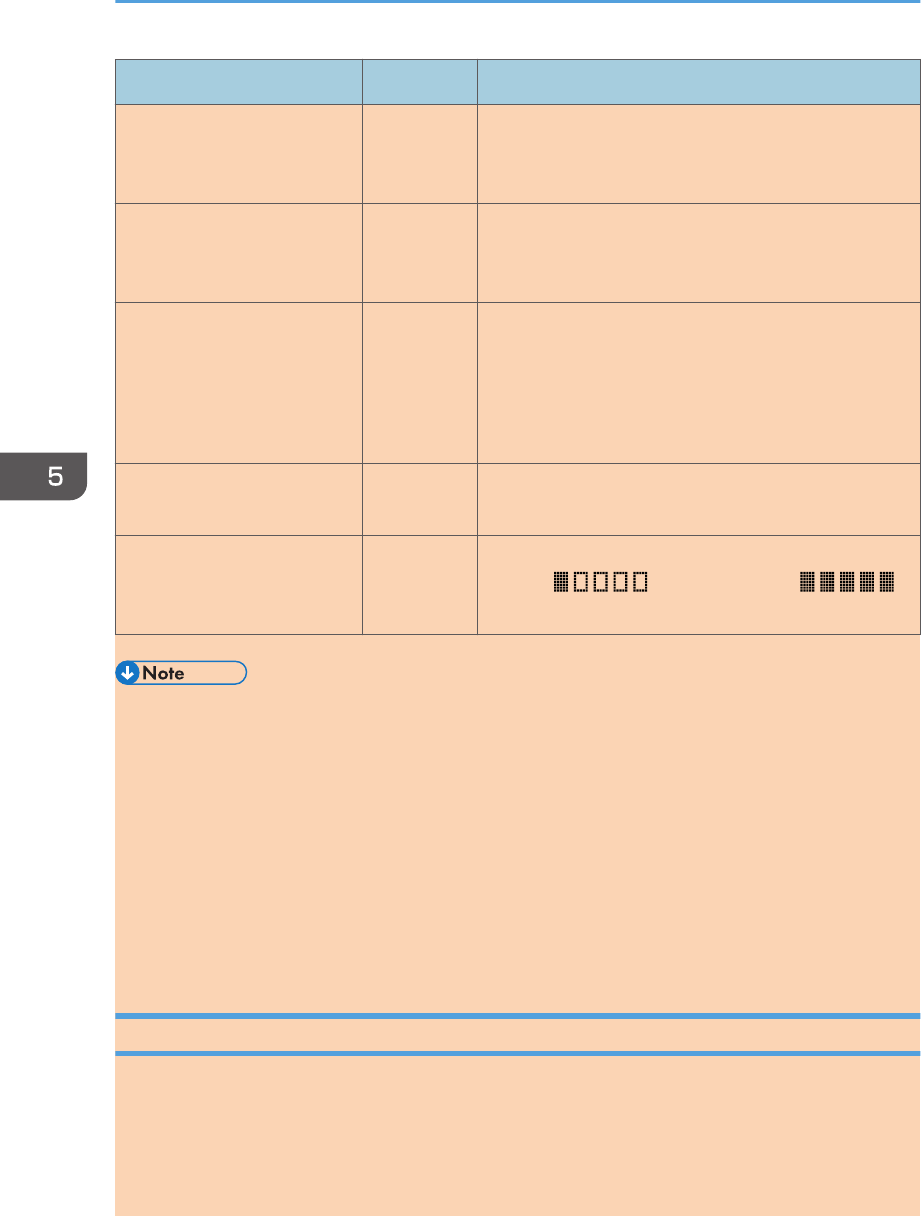
Item Setting Description
File Format (Color/Gray
Scale) Required
File format of the scanned file when scanning in color.
PDF or JPEG can be selected. PDF supports multiple
pages in a document, but JPEG does not.
File Format (Black & White) Required
File format of the scanned file when scanning in black
and white. PDF or TIFF can be selected. Both formats
support multiple pages in a document.
Scan Size Optional
Select the scanning size for the original from A5, B5,
A4, 71/4 × 101/2, 81/2 × 51/2, 81/2 × 11, 81/2 ×
14, 16K, or custom size.
If you select custom size, select [mm] or [Inch], and
then specify the width and length.
Resolution Optional Select the scan resolution from 100×100, 150×150,
200×200, 300×300, 400×400, or 600×600 dpi.
Density Optional
Specify the image density by clicking the right or left
buttons. is the lightest, and
is the darkest.
• To send files via e-mail, SMTP and DNS settings must be configured properly.
• If you are using the Scan to E-mail function, select a time zone according to your geographic
location to send email with correct transmission date and time.
• To send files to an FTP server or computer, the user name, password, and directory must be
configured properly.
• On a network that uses a DNS server, specify a computer name in [Service Name] and the name
of the domain to which the computer belongs in [Domain]. In this case, also configure the DNS
related settings using Web Image Monitor.
• Scan destinations cannot be registered using the control panel.
Modifying Scan Destinations
This section describes how to modify the information of registered destinations.
1. Start the web browser and access the machine by entering its IP address.
2. Click [Scan Destination].
3. Click the [E-mail Address], [FTP], or [Folder] tab.
5. Scanning Originals
98 opal-p3_mf3_com_user_guide_gb_00228453_eng.xml
Draft 2016/05/27
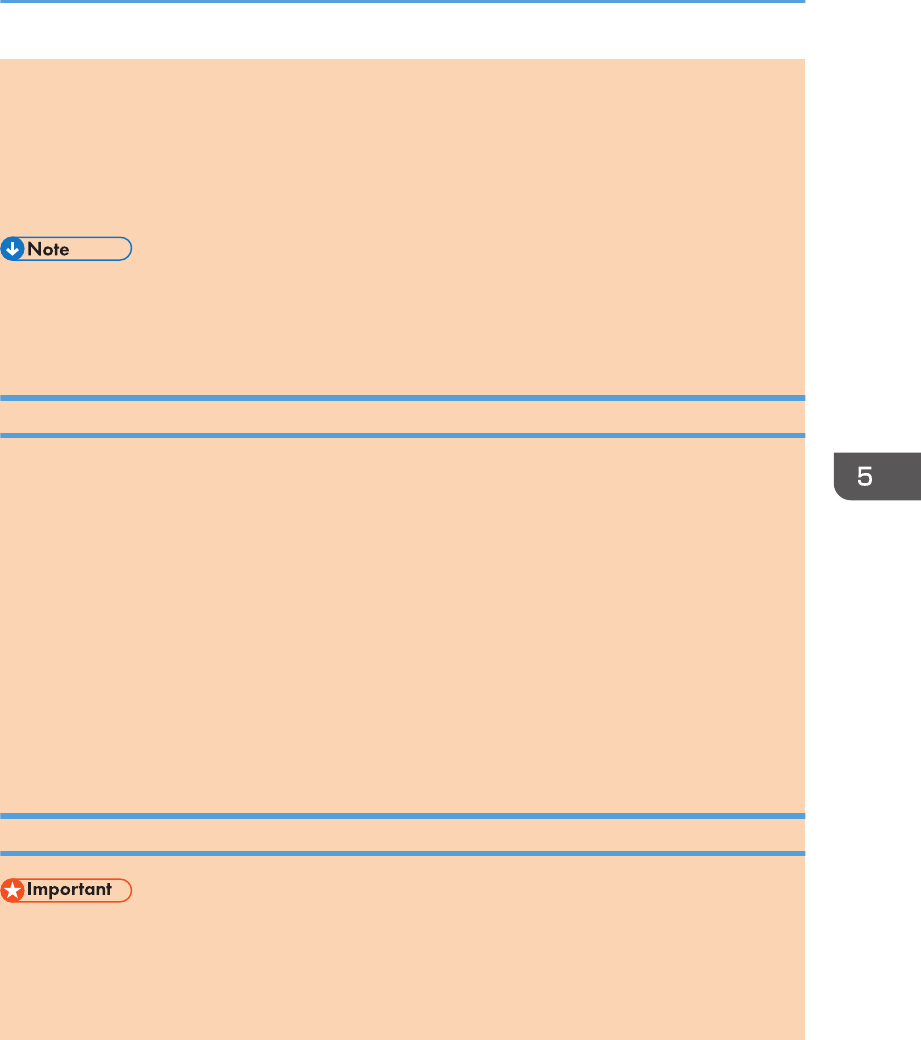
4. Select the entry to modify, and then click [Change].
5. Modify settings as necessary.
6. Enter the administrator password if required.
7. Click [Apply].
8. Close the web browser.
• You can unassign a Quick Dial entry from a One-touch button from the [Quick Dial Destination]
page. (only SP 221SF, SP 220SFNw, and SP 221SFNw) To do this, select the desired entry, click
[Delete], and then click [Apply] again on a confirmation page.
Deleting Scan Destinations
This section describes how to delete registered destinations.
1. Start the web browser and access the machine by entering its IP address.
2. Click [Scan Destination].
3. Click the [E-mail Address], [FTP], or [Folder] tab.
4. Select the entry to delete, and then click [Delete].
5. Confirm that the entry you have selected is the entry that you want to delete.
6. Enter the administrator password if required.
7. Click [Apply].
8. Close the web browser.
Testing Transmission
• When a USB flash memory device is inserted into the machine, scanned documents will be stored
in the USB flash memory device. Confirm that there are no USB flash memory devices inserted into
the machine.
1. Place the original on the exposure glass or in the ADF.
Registering Scan Destinations
opal-p3_mf3_com_user_guide_gb_00228453_eng.xml 99
Draft 2016/05/27